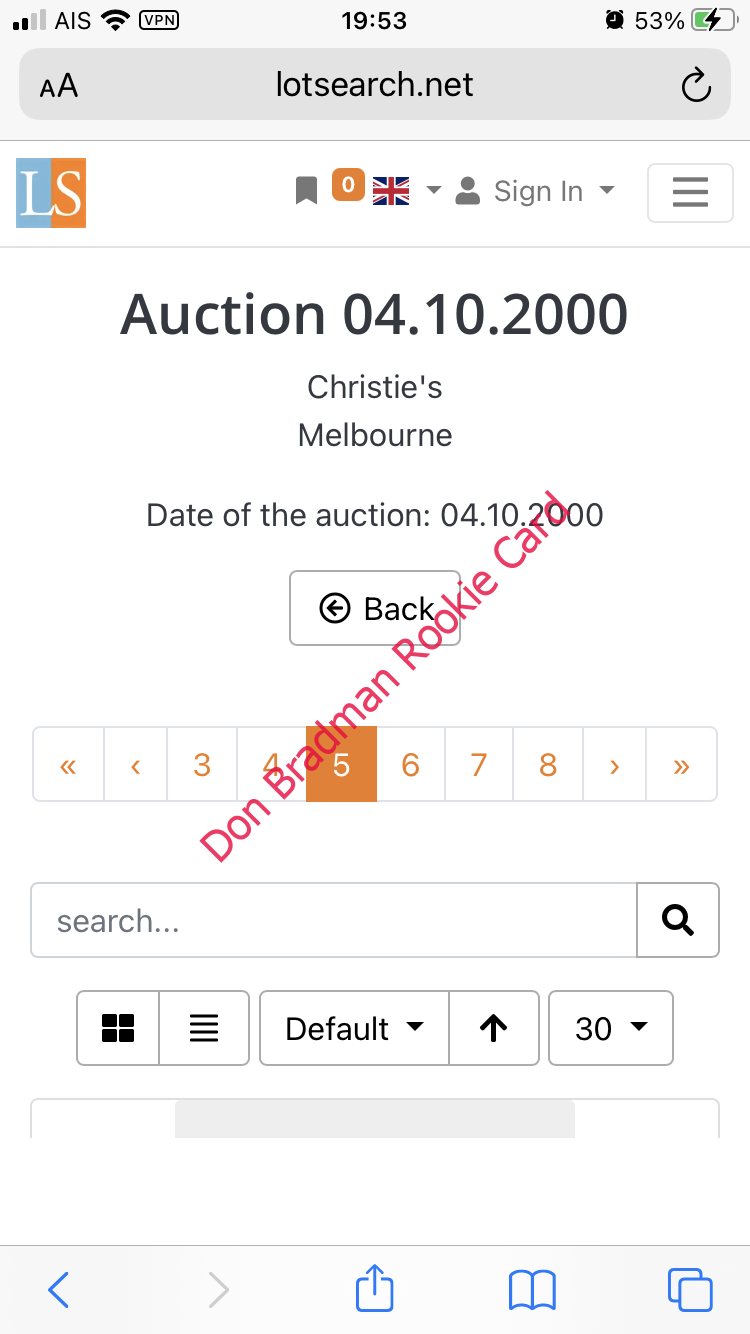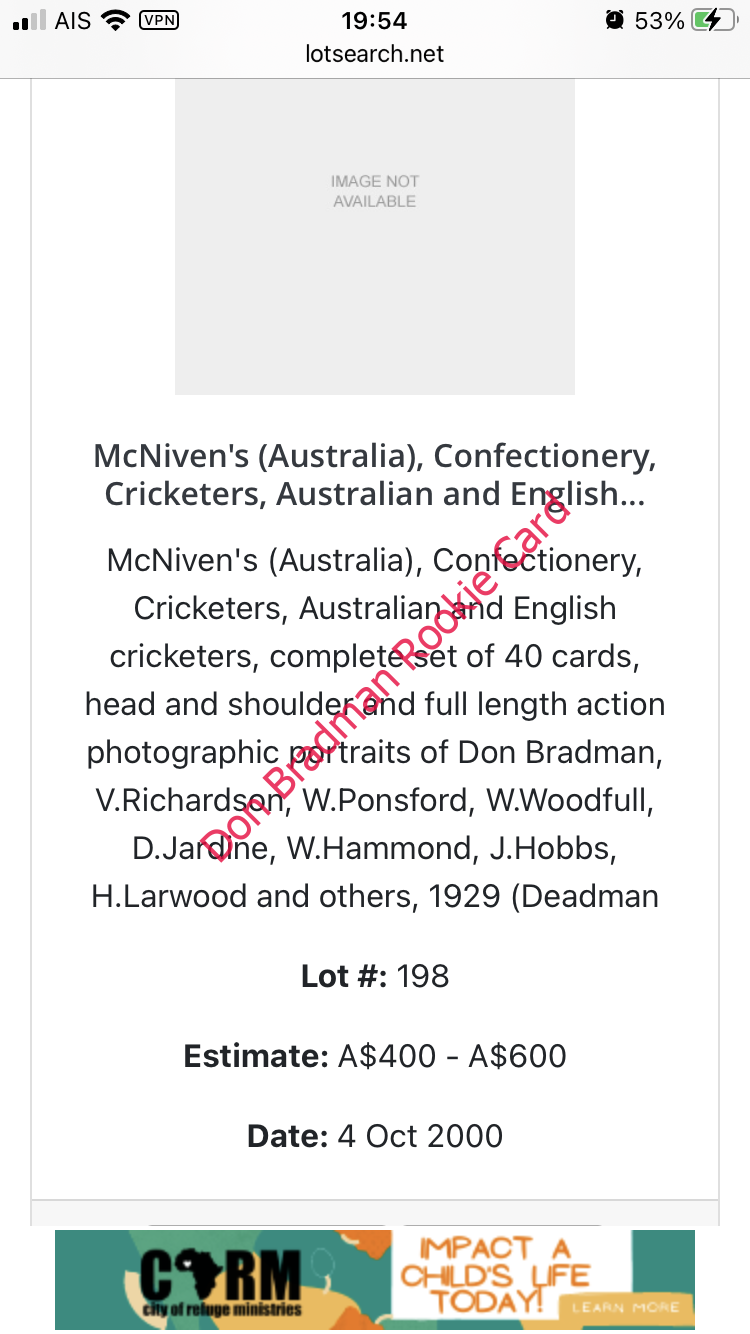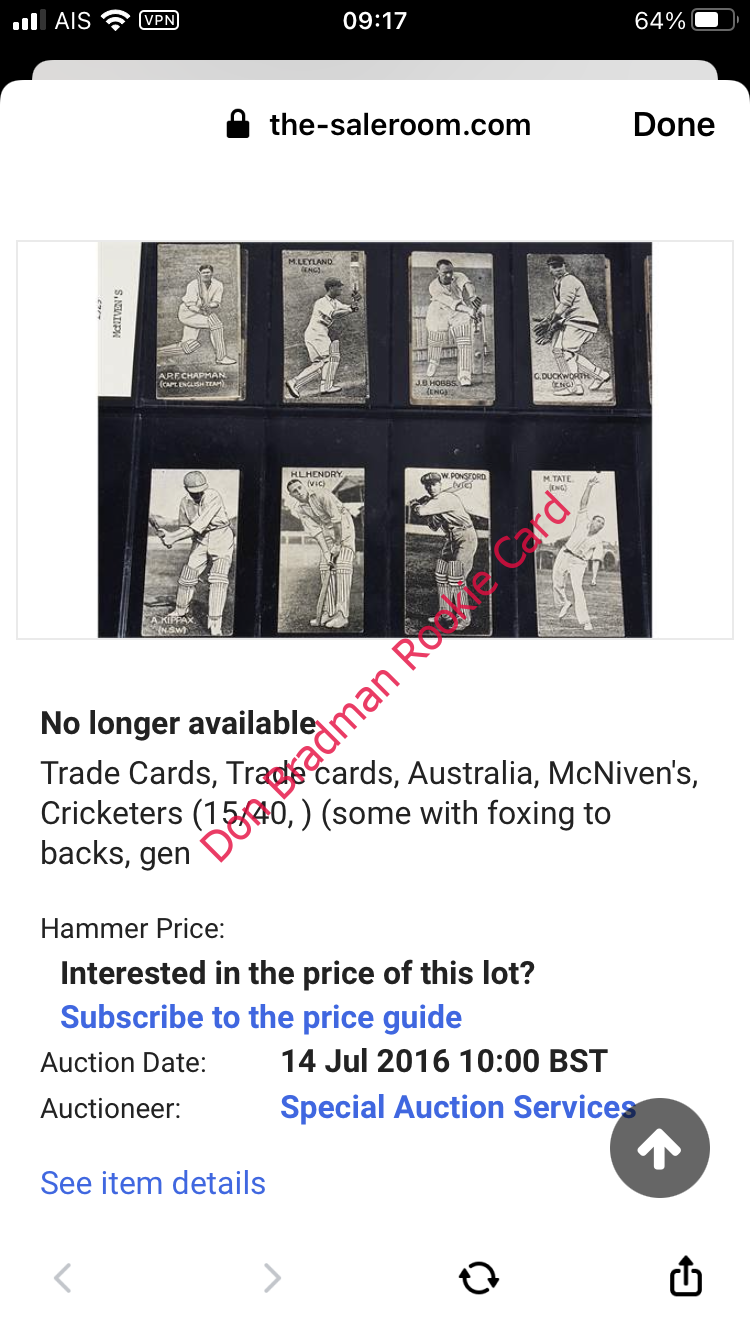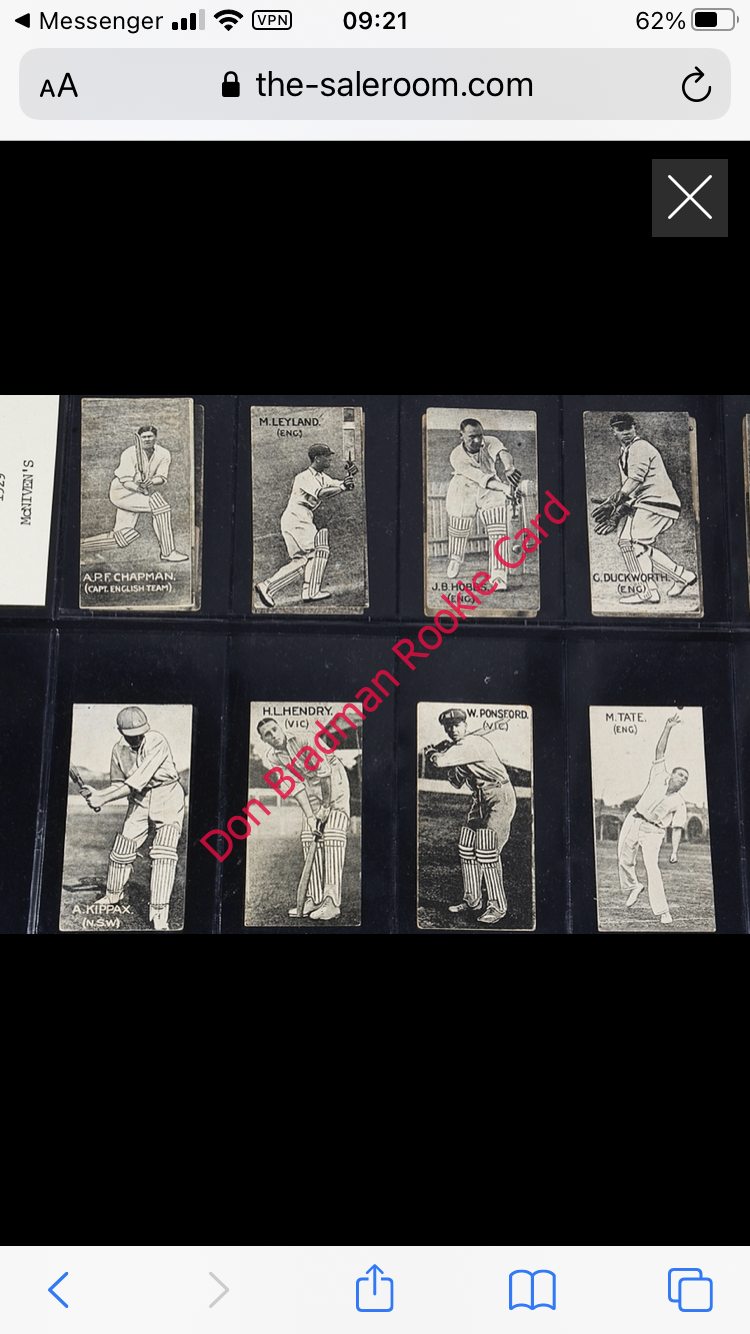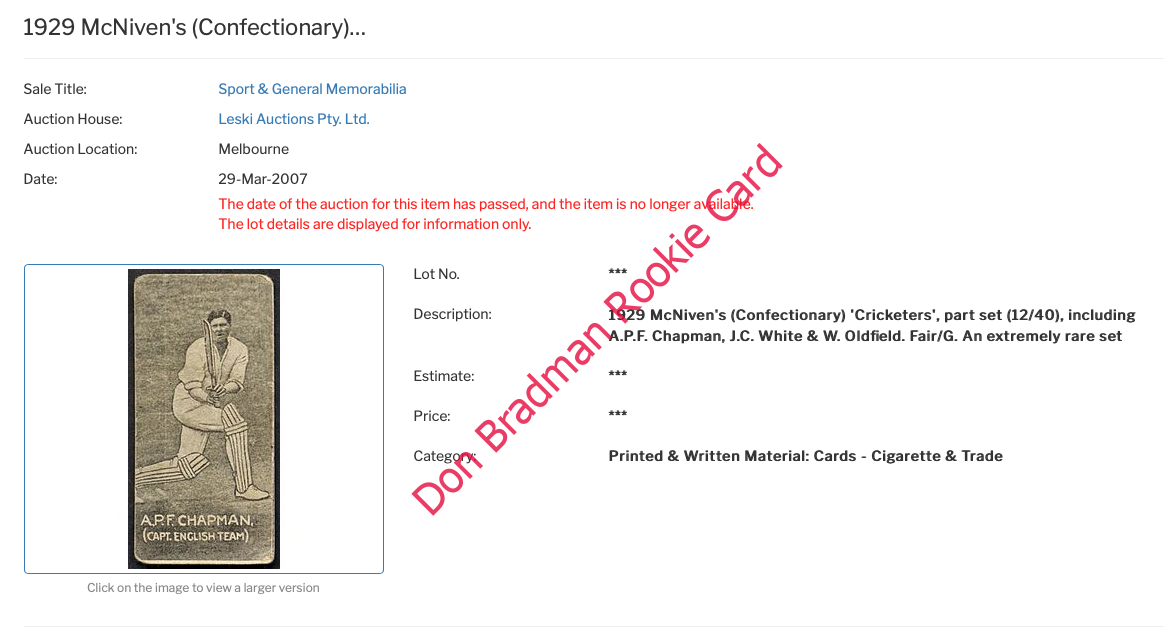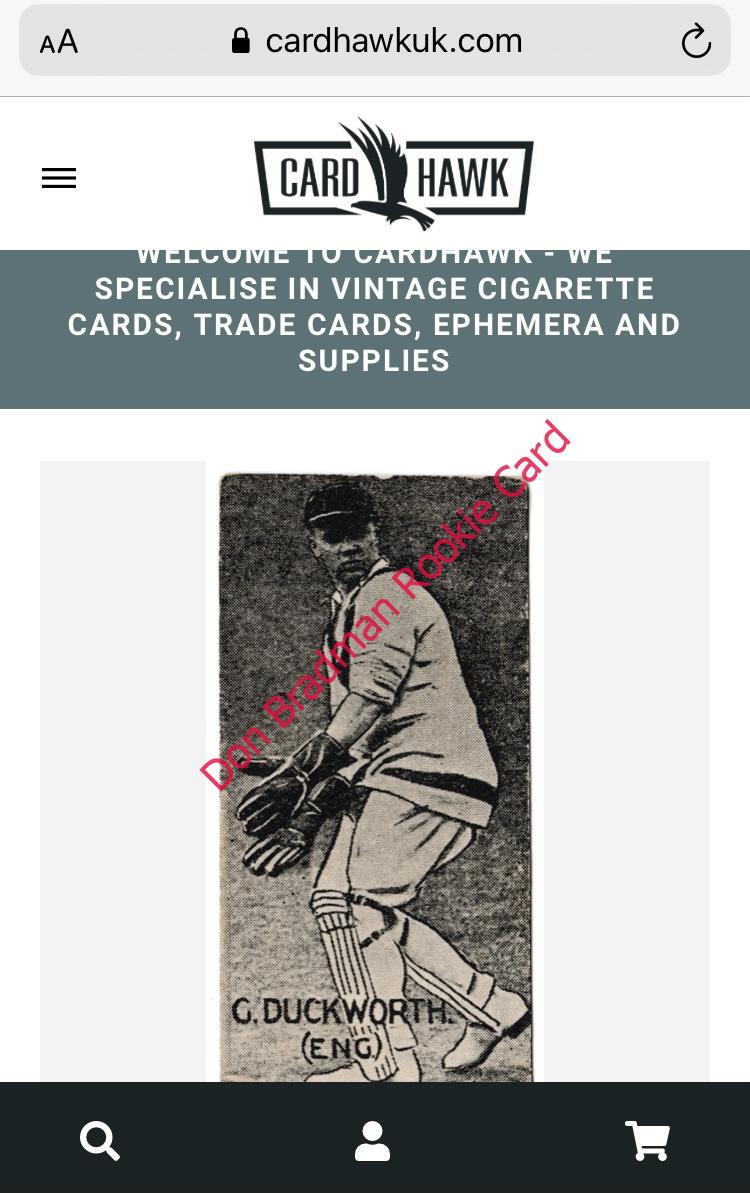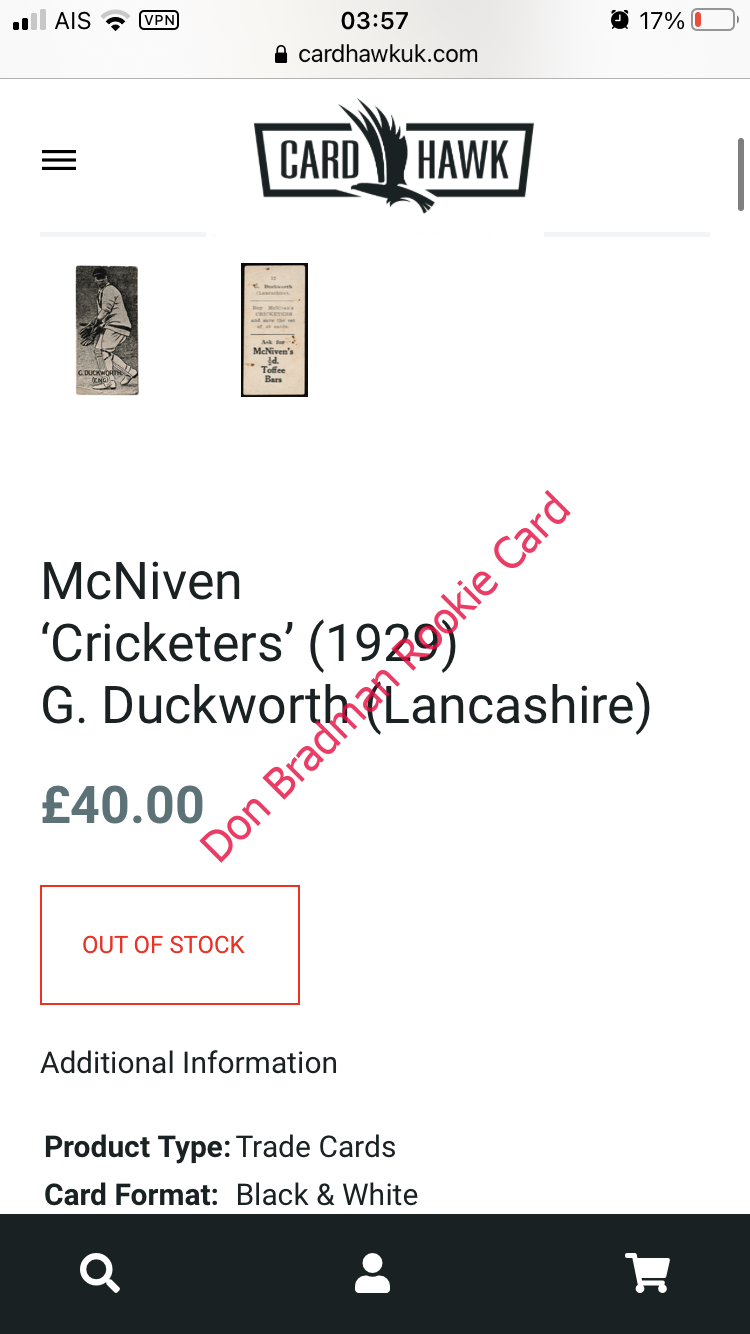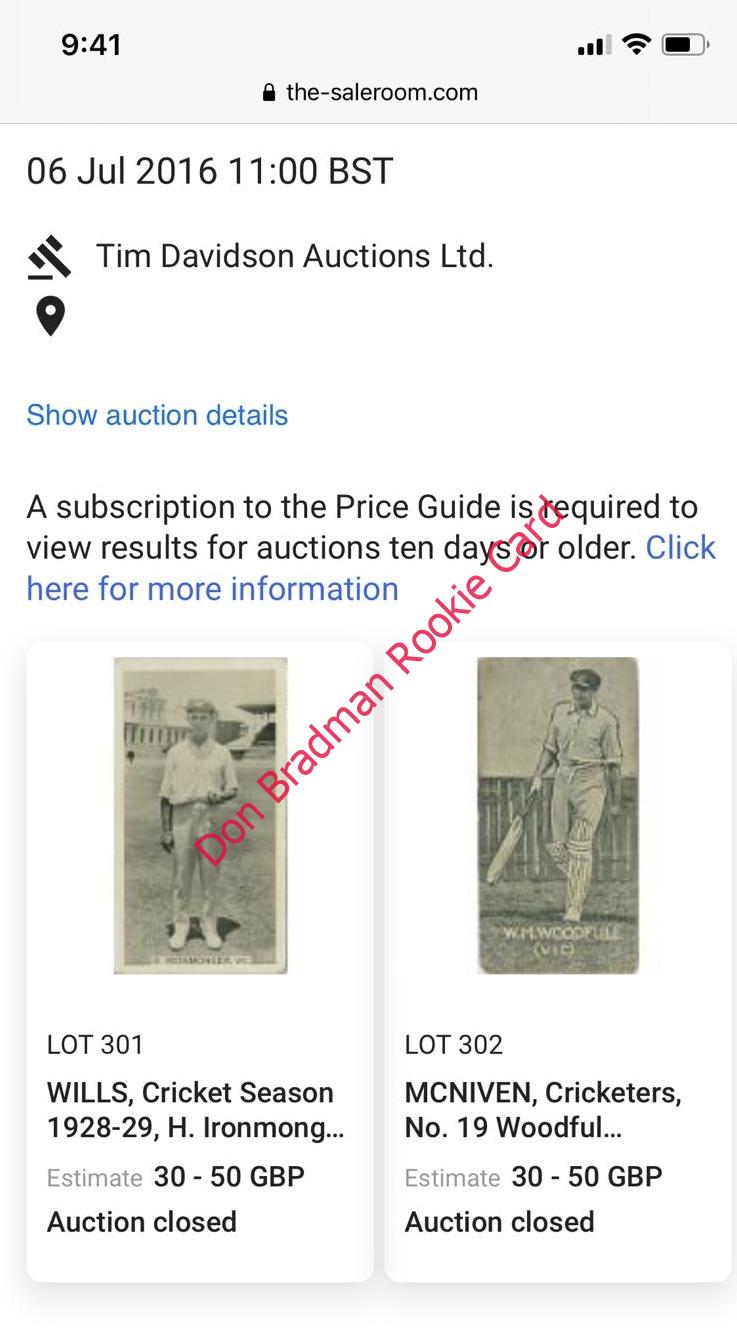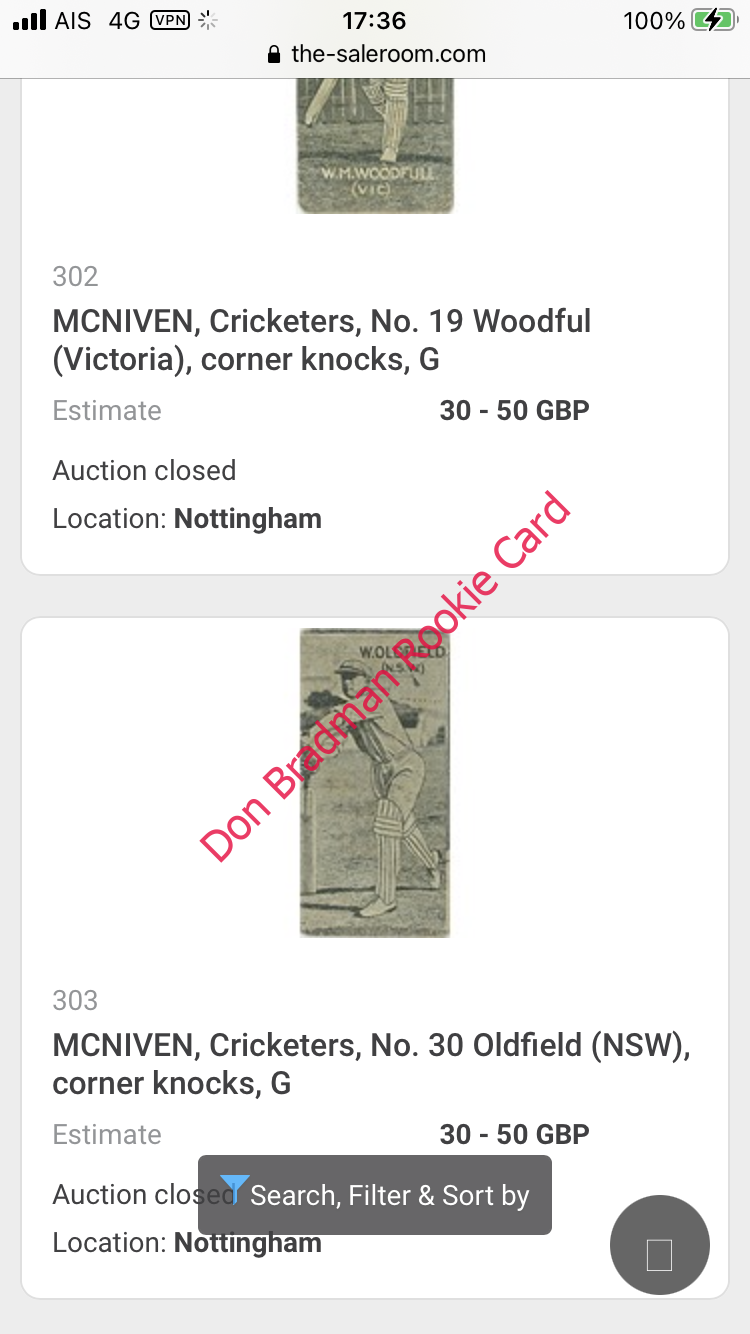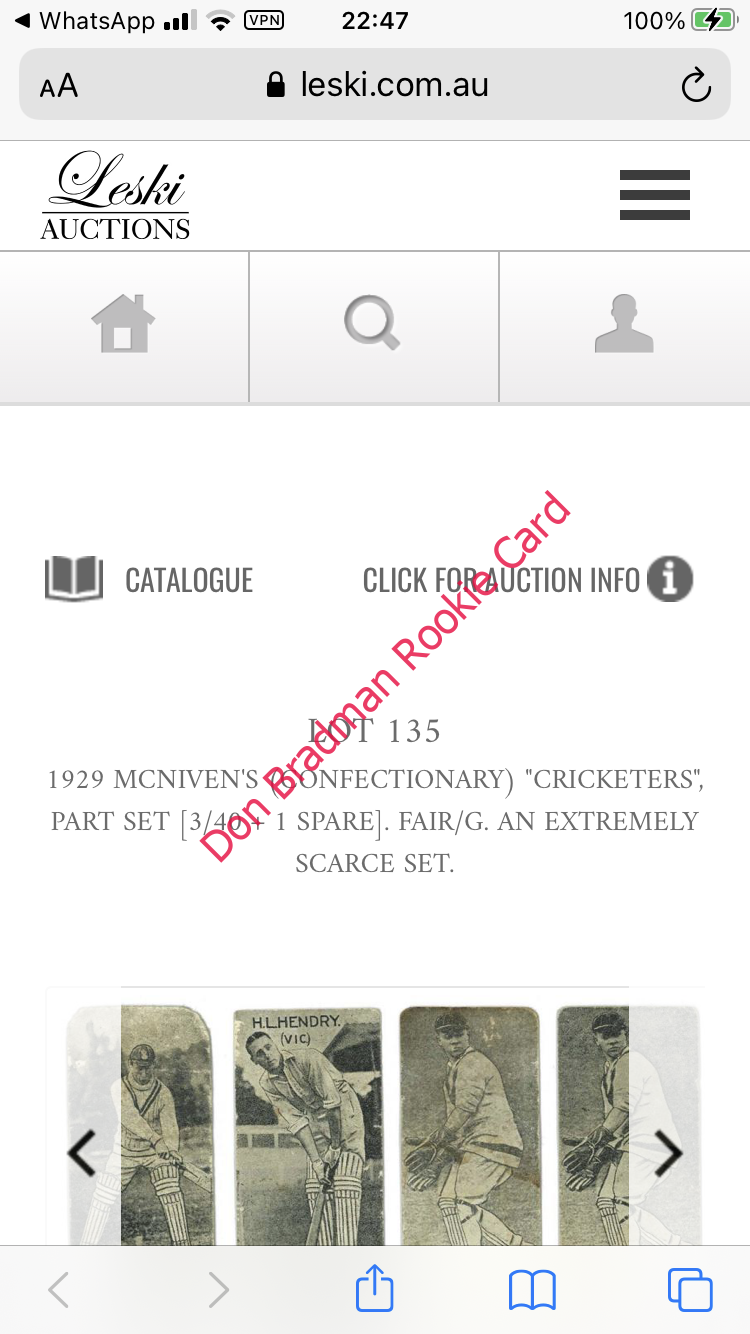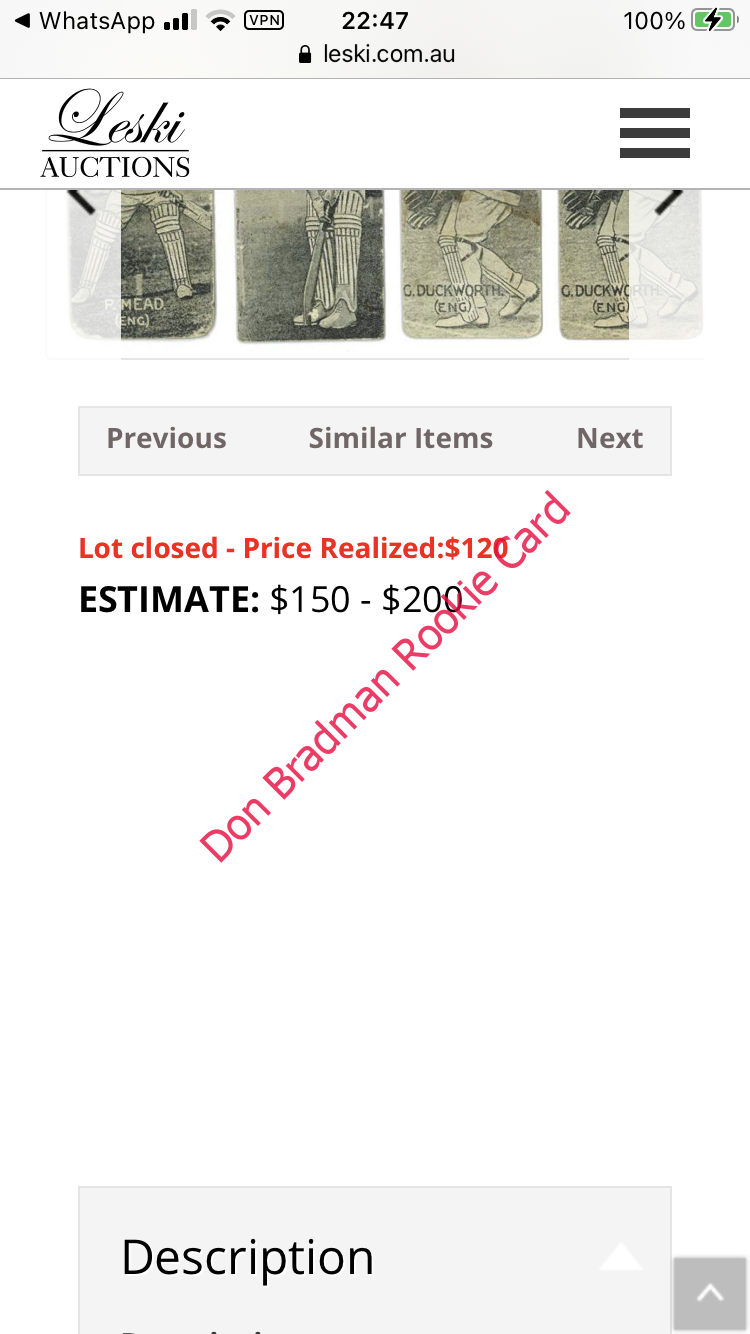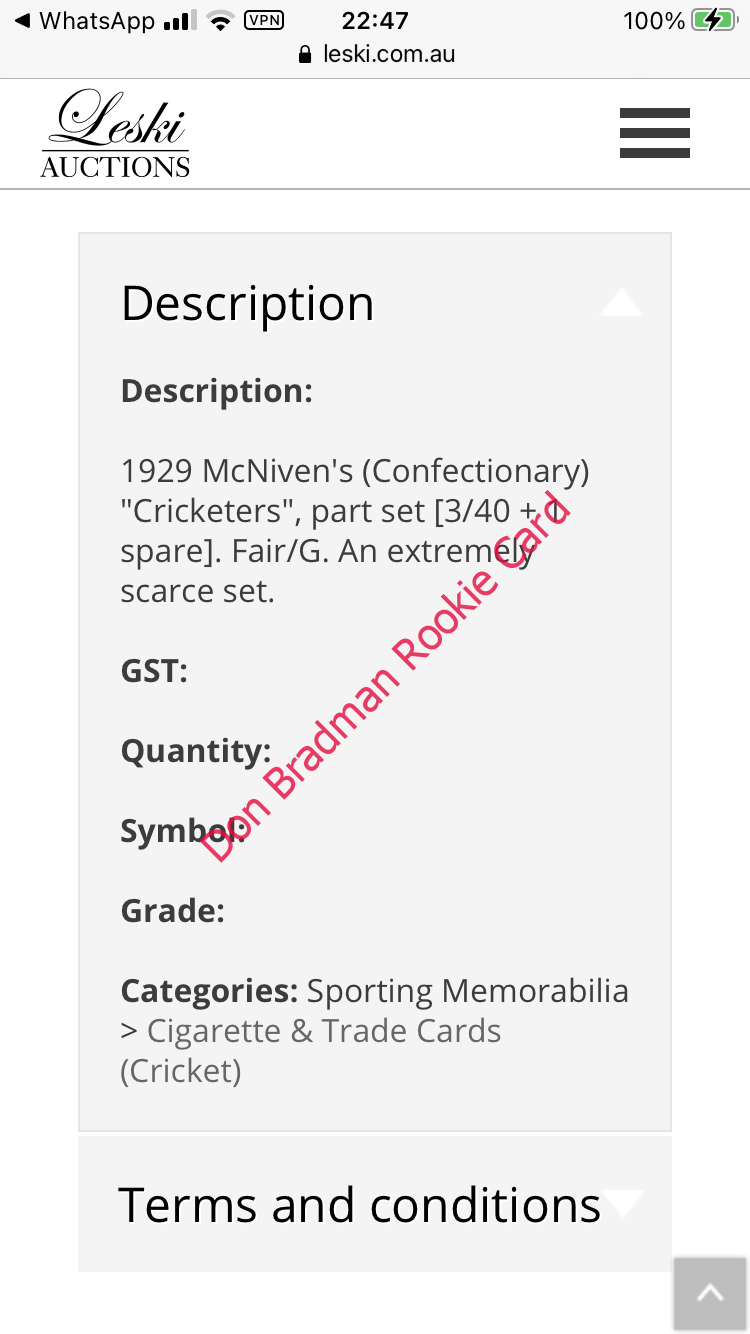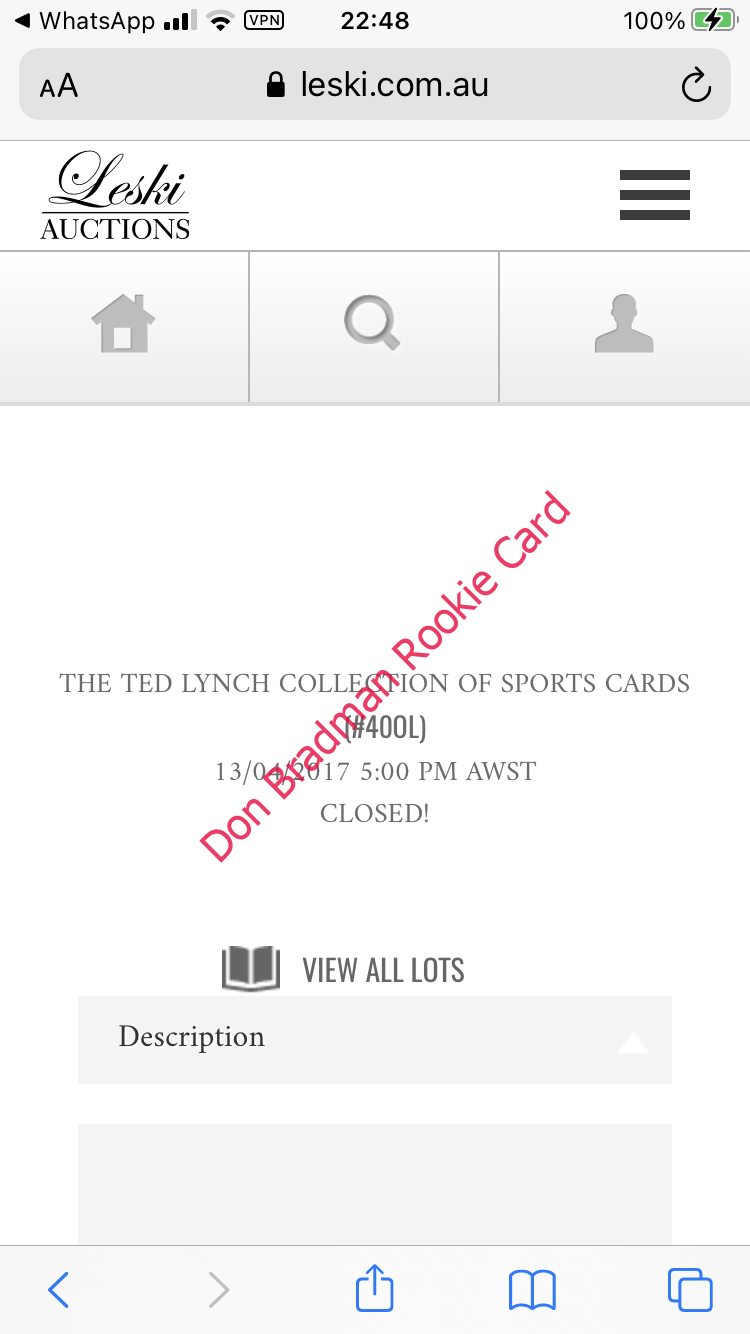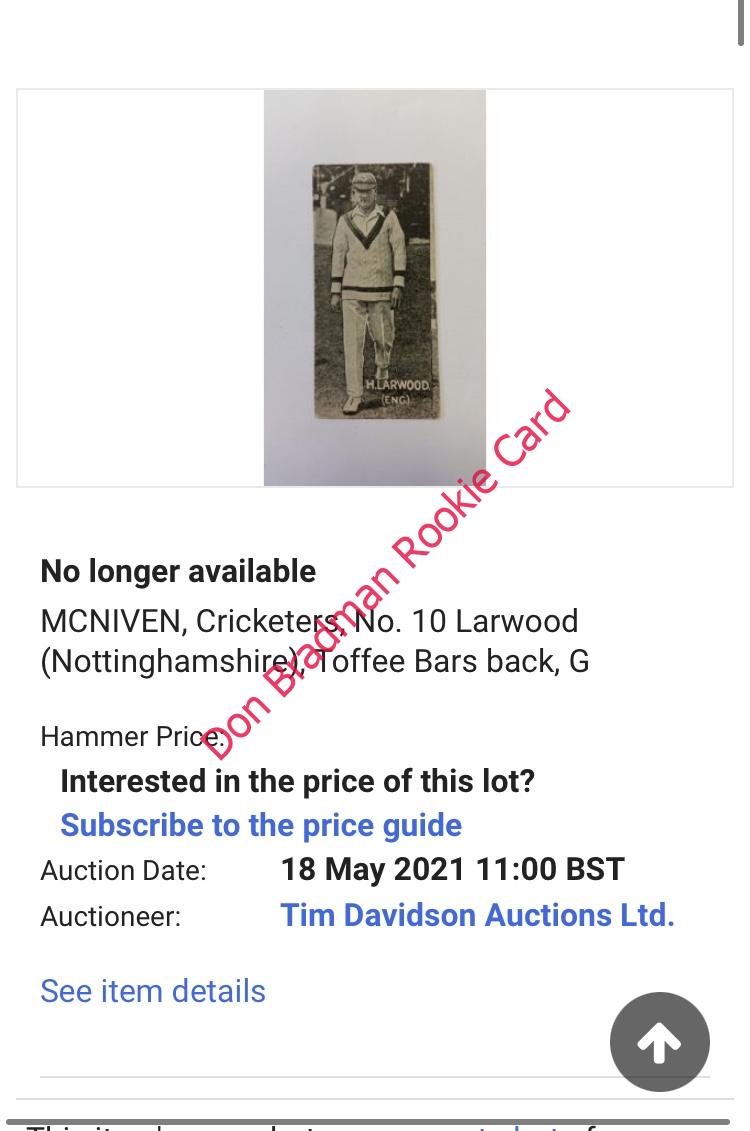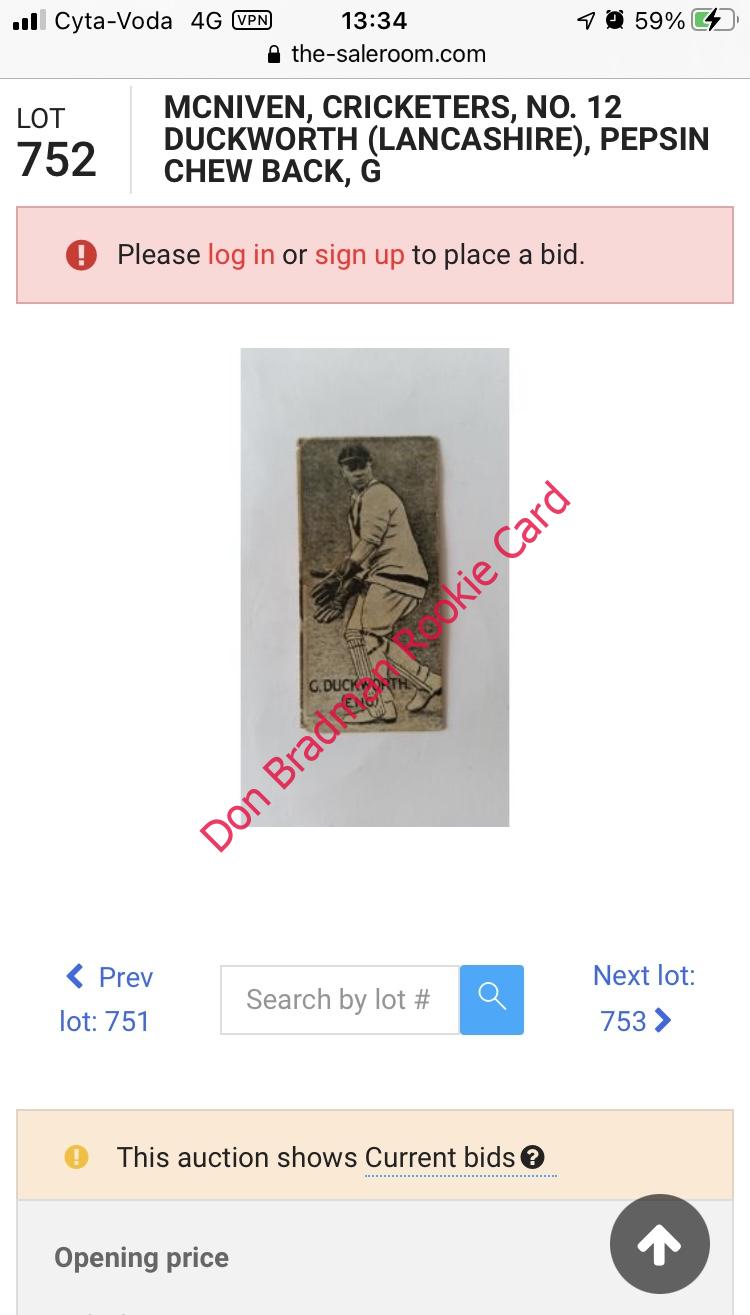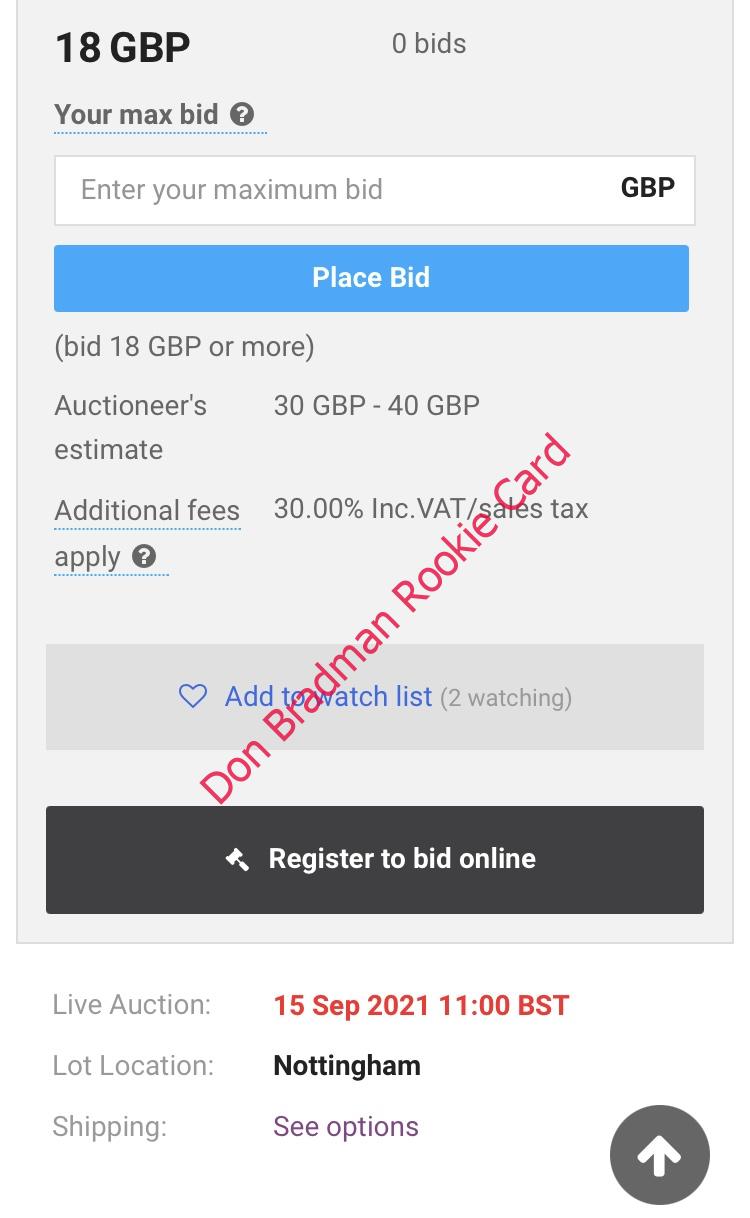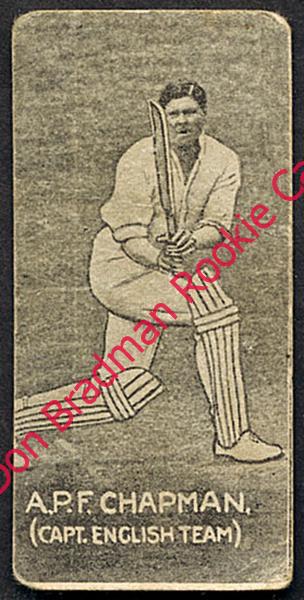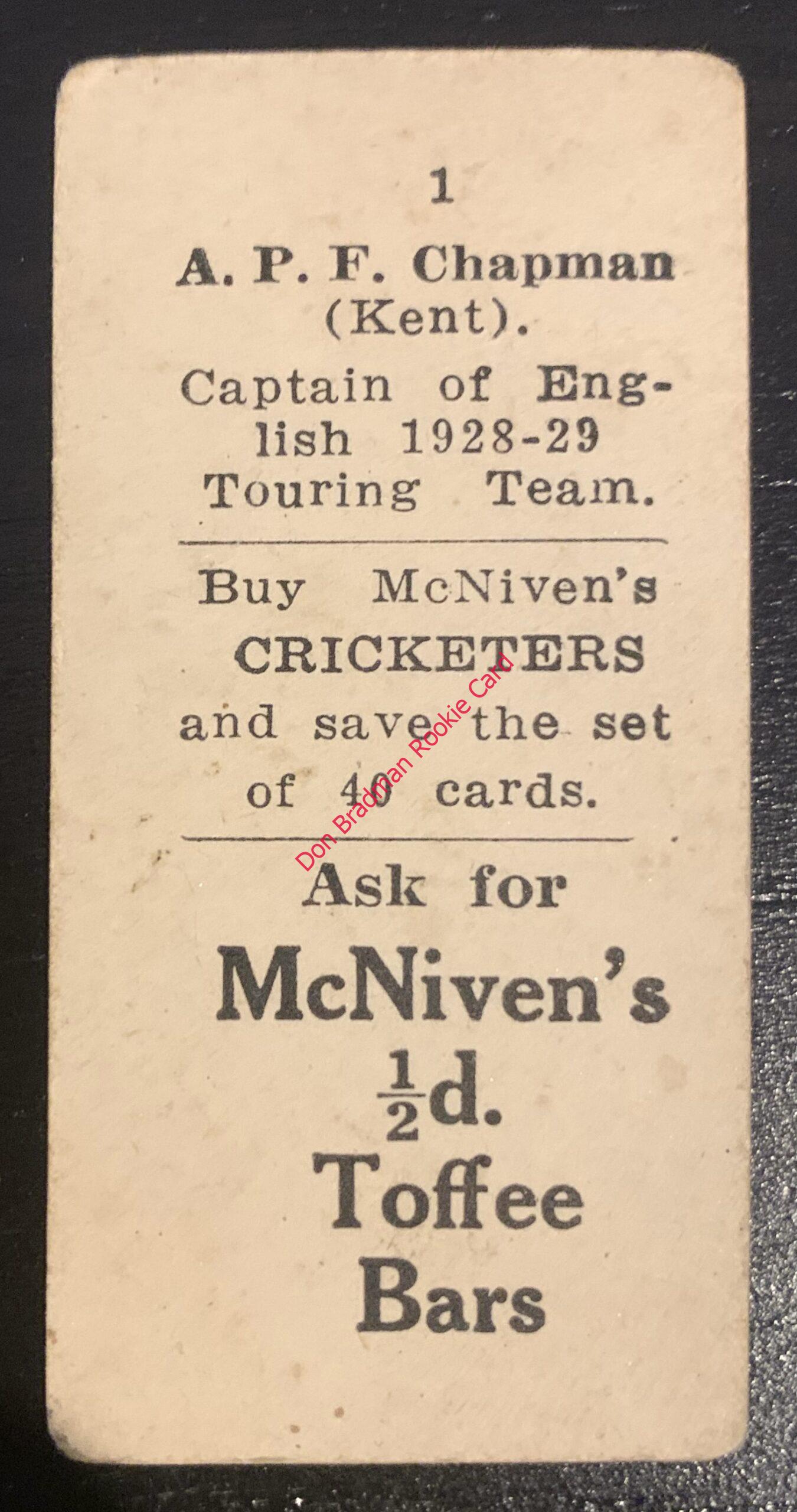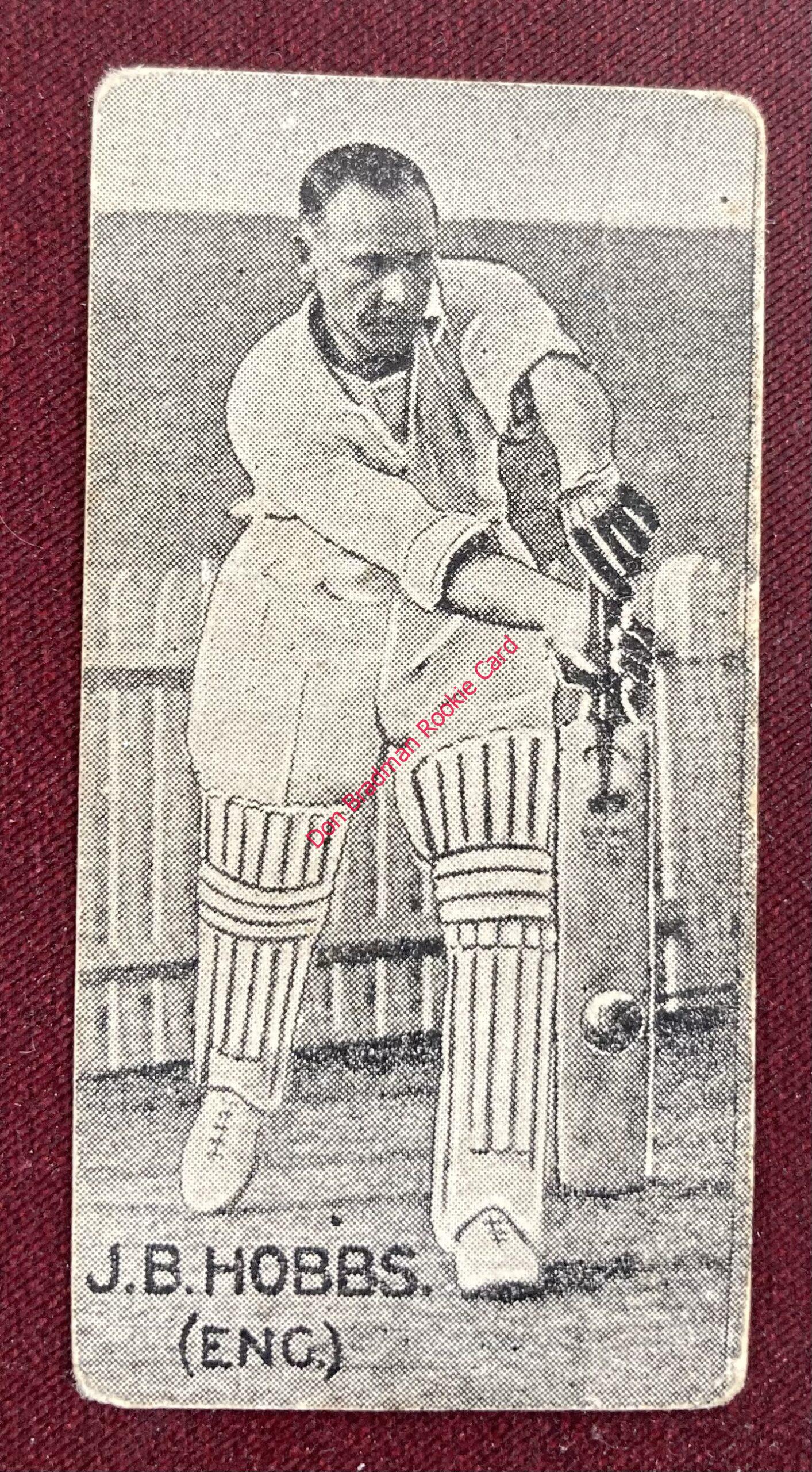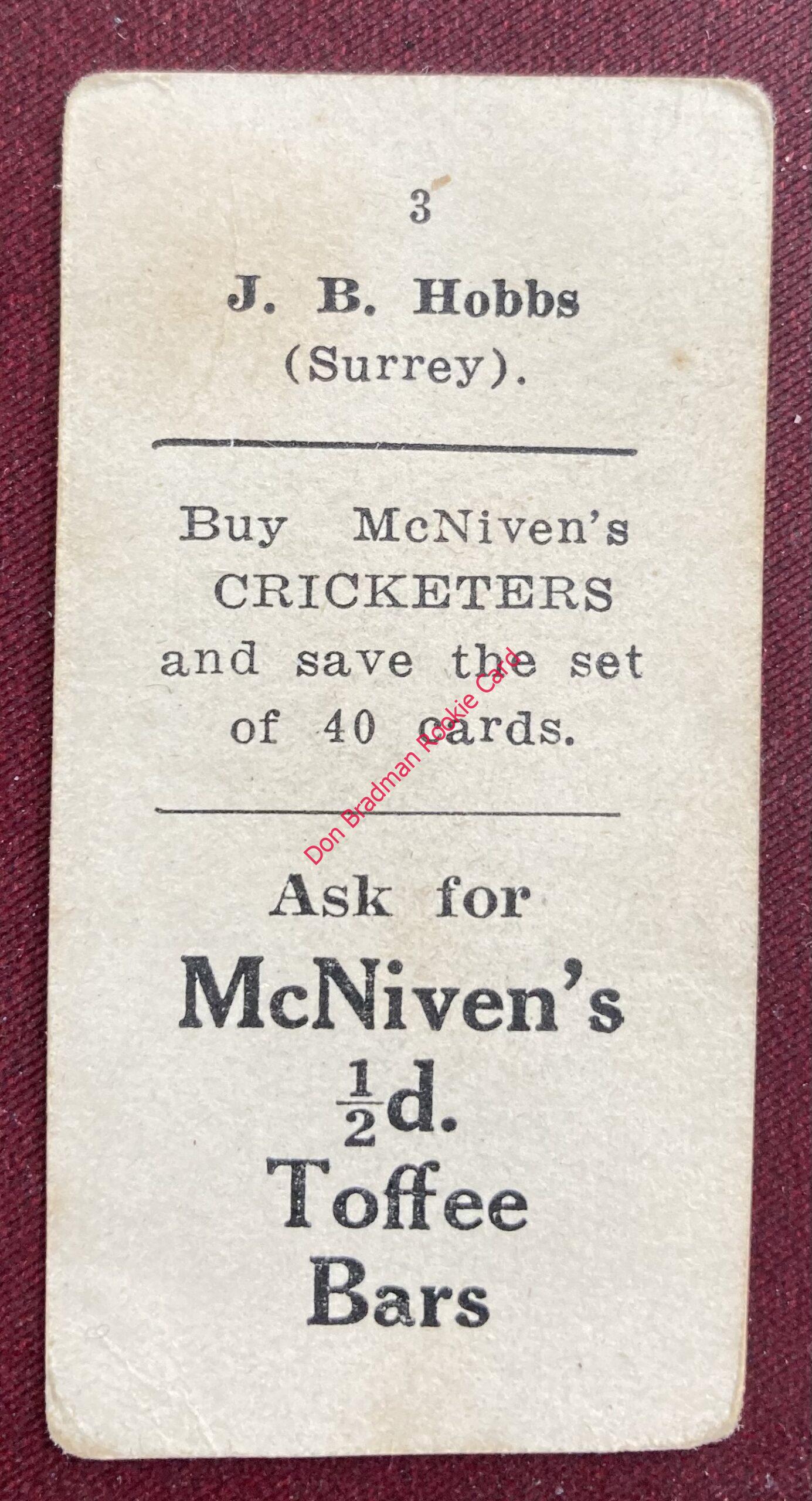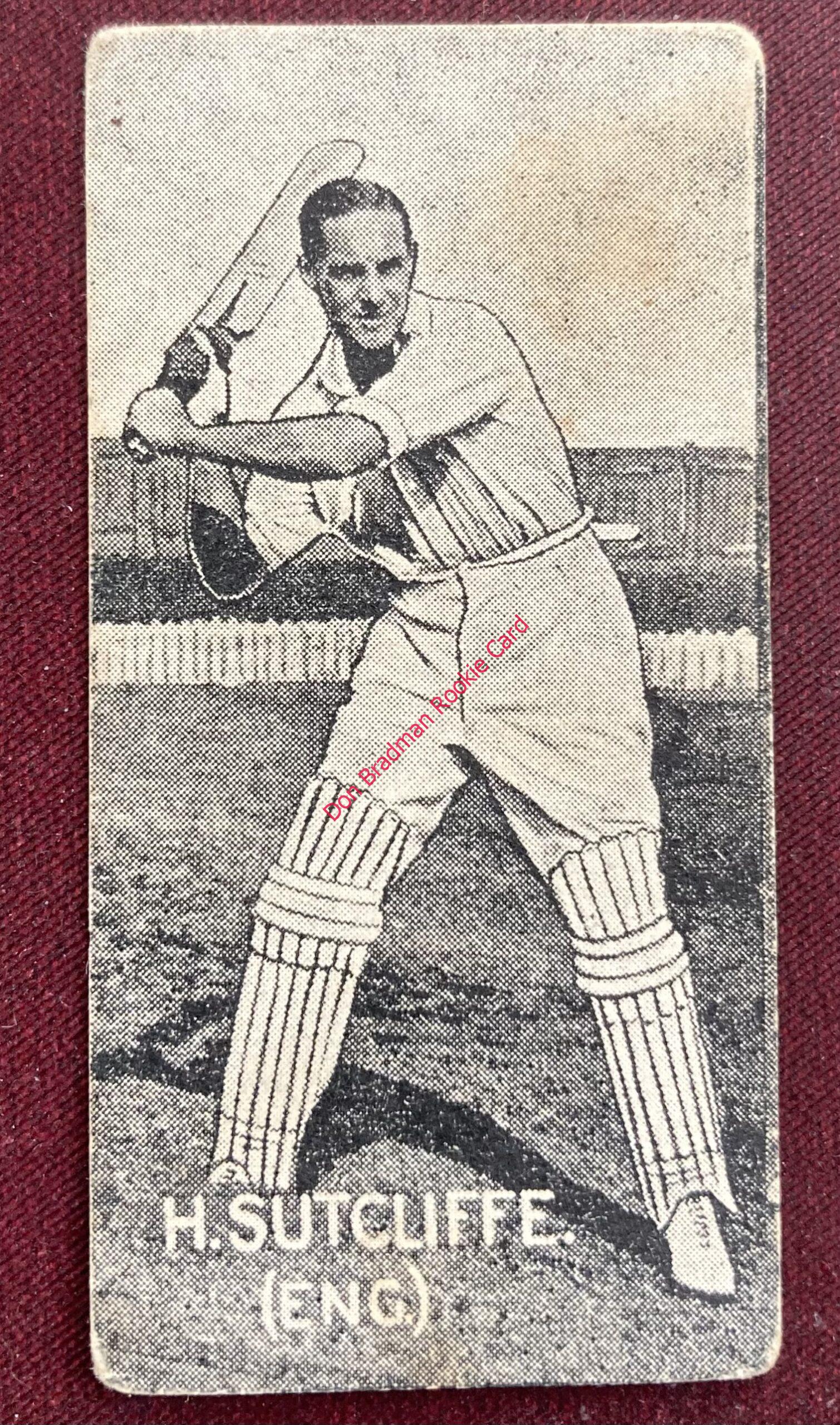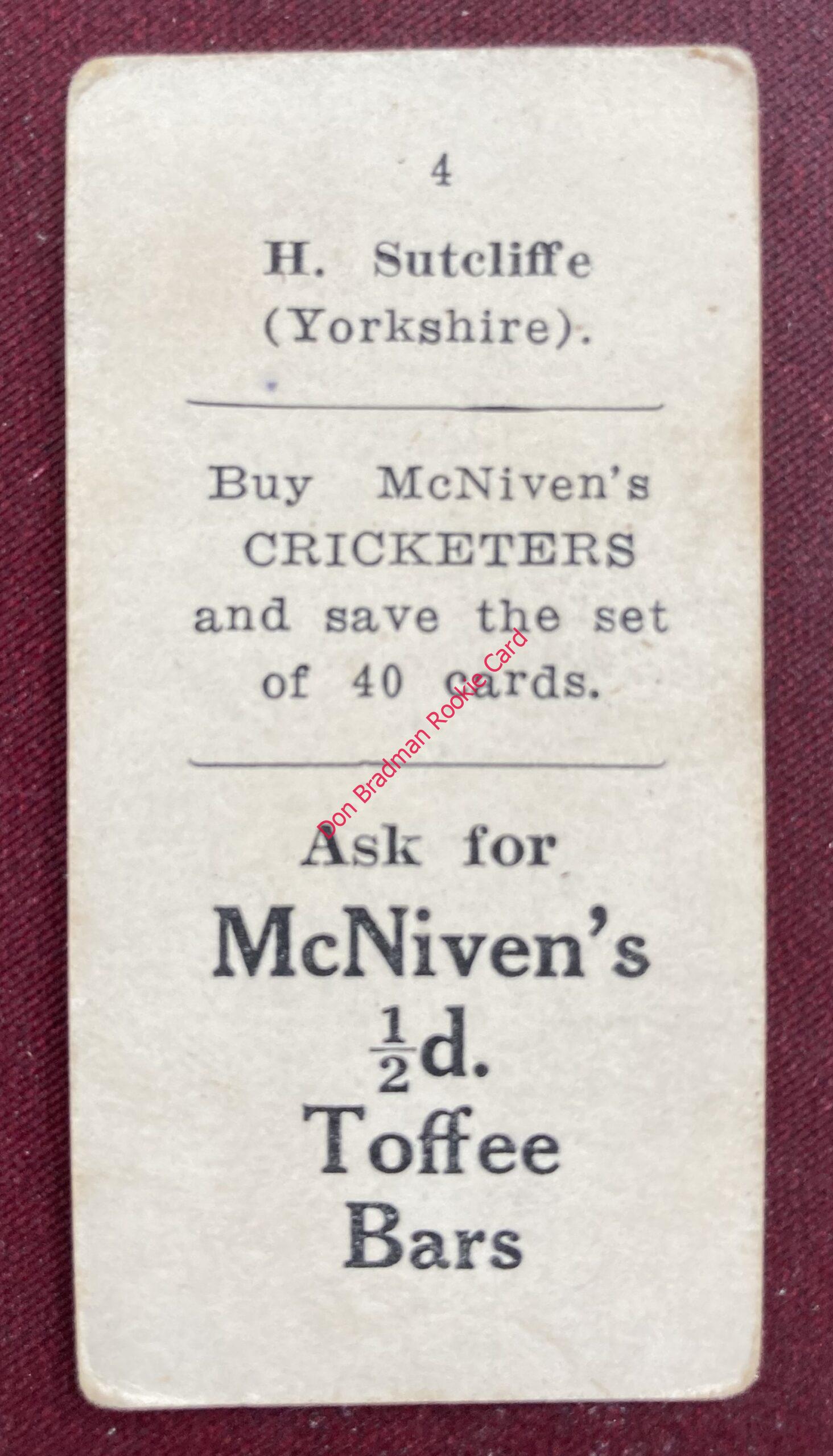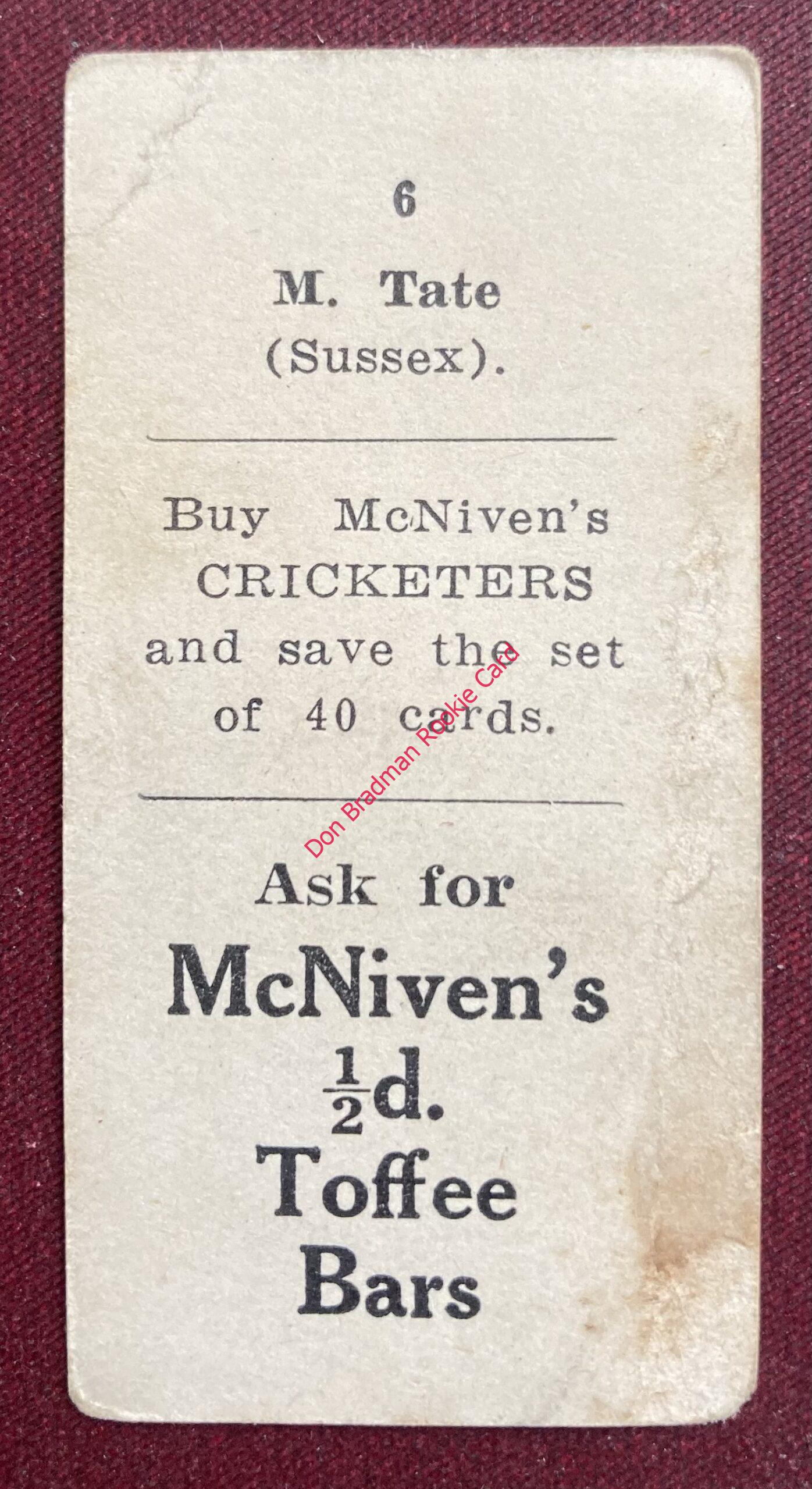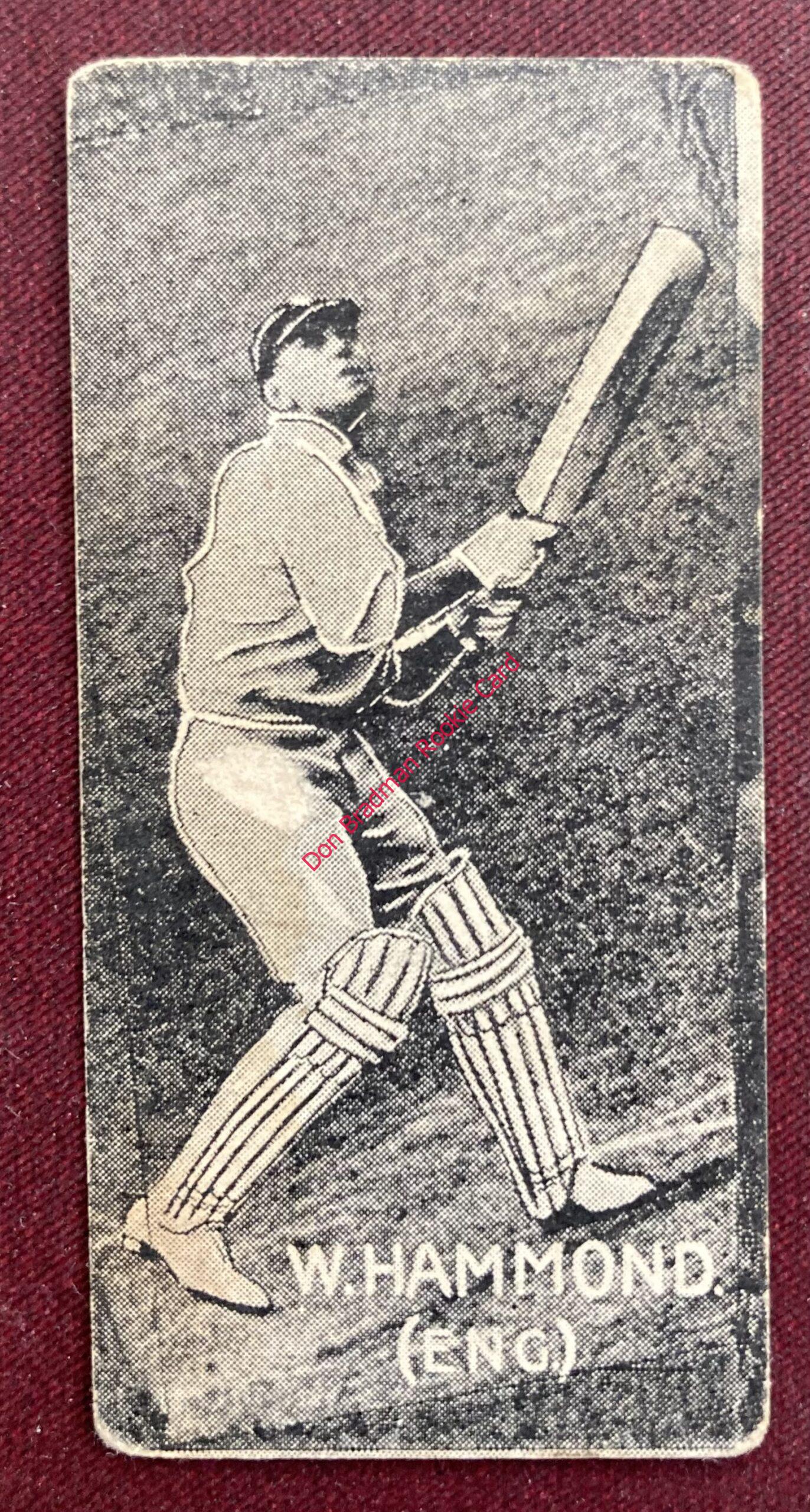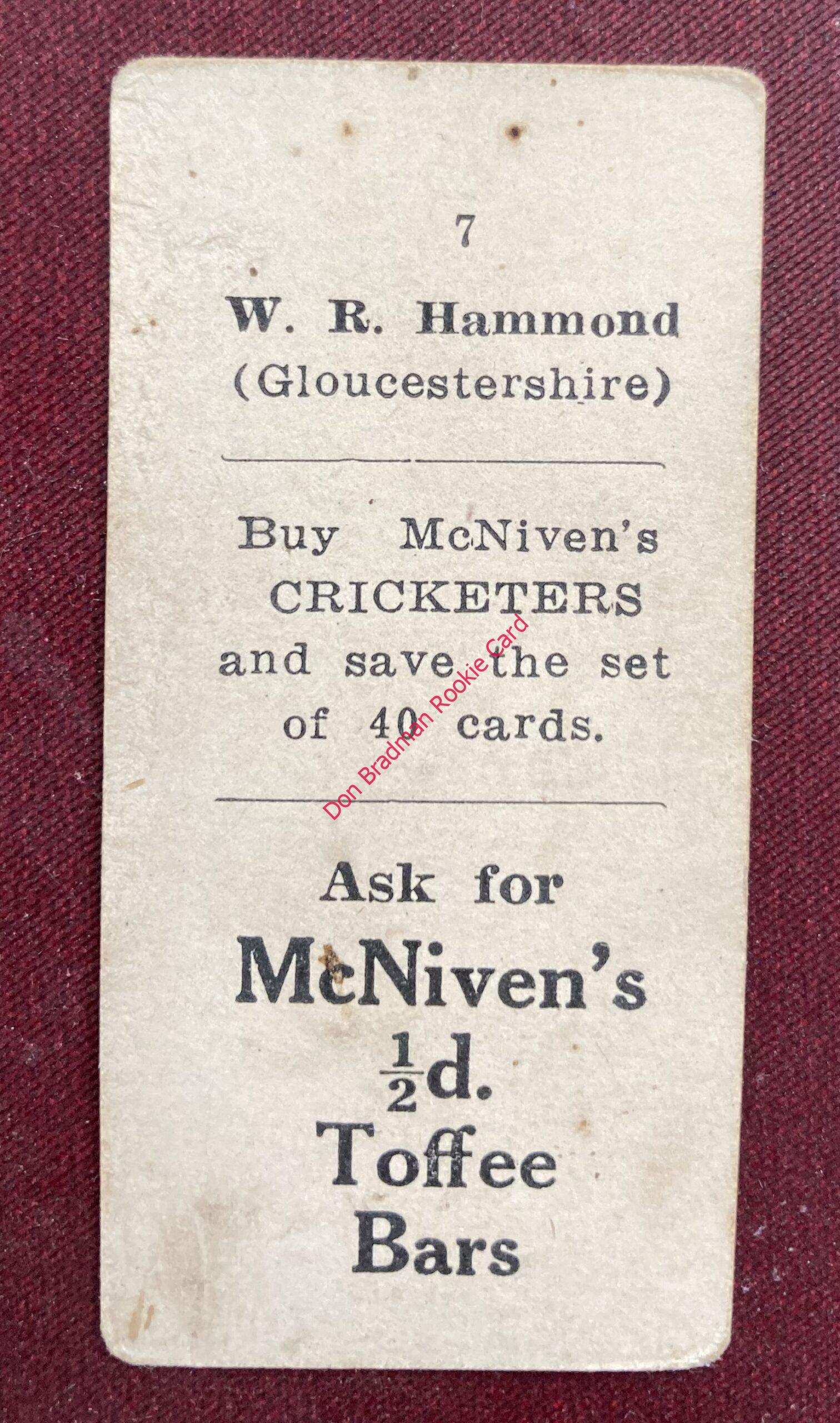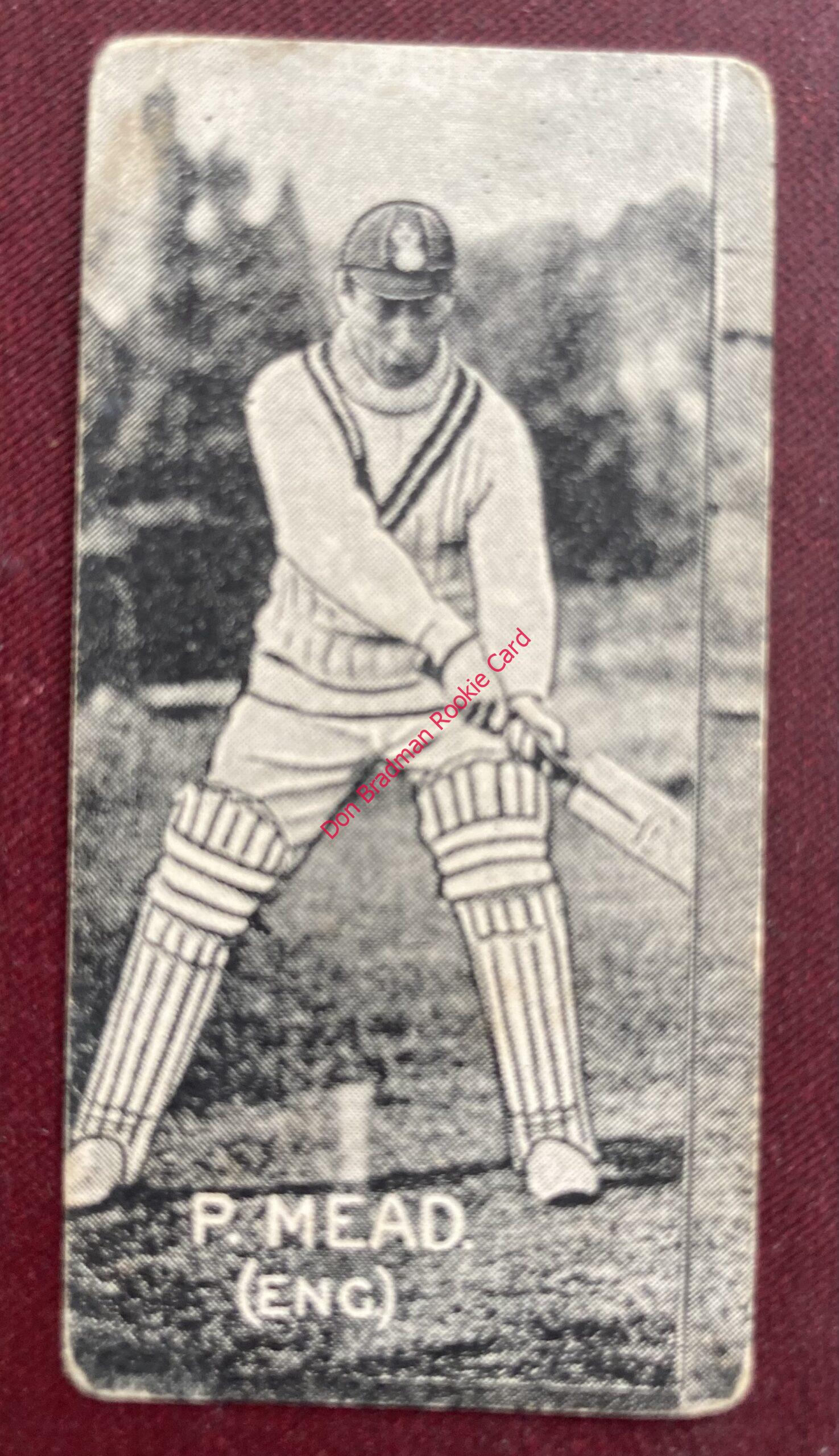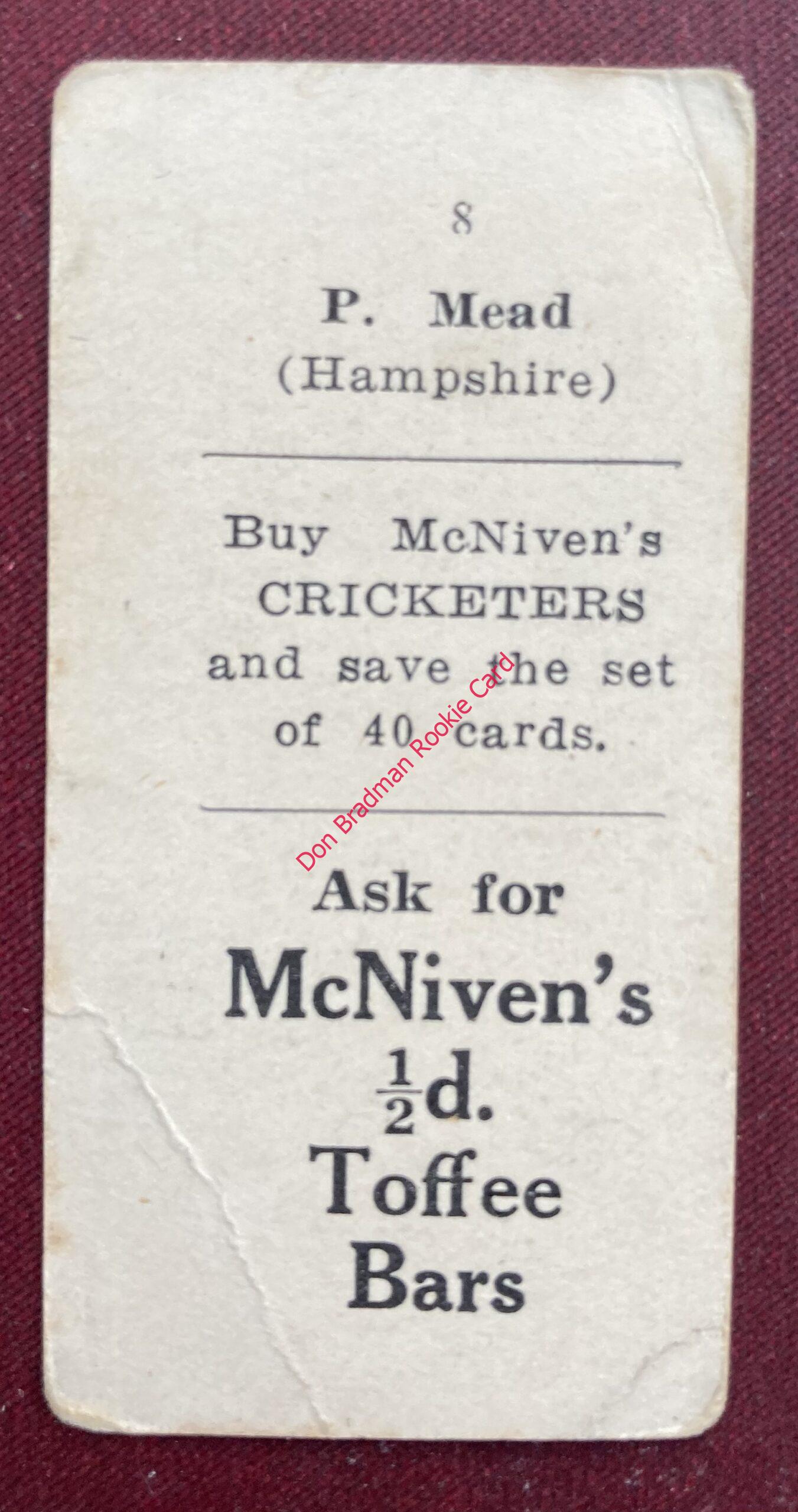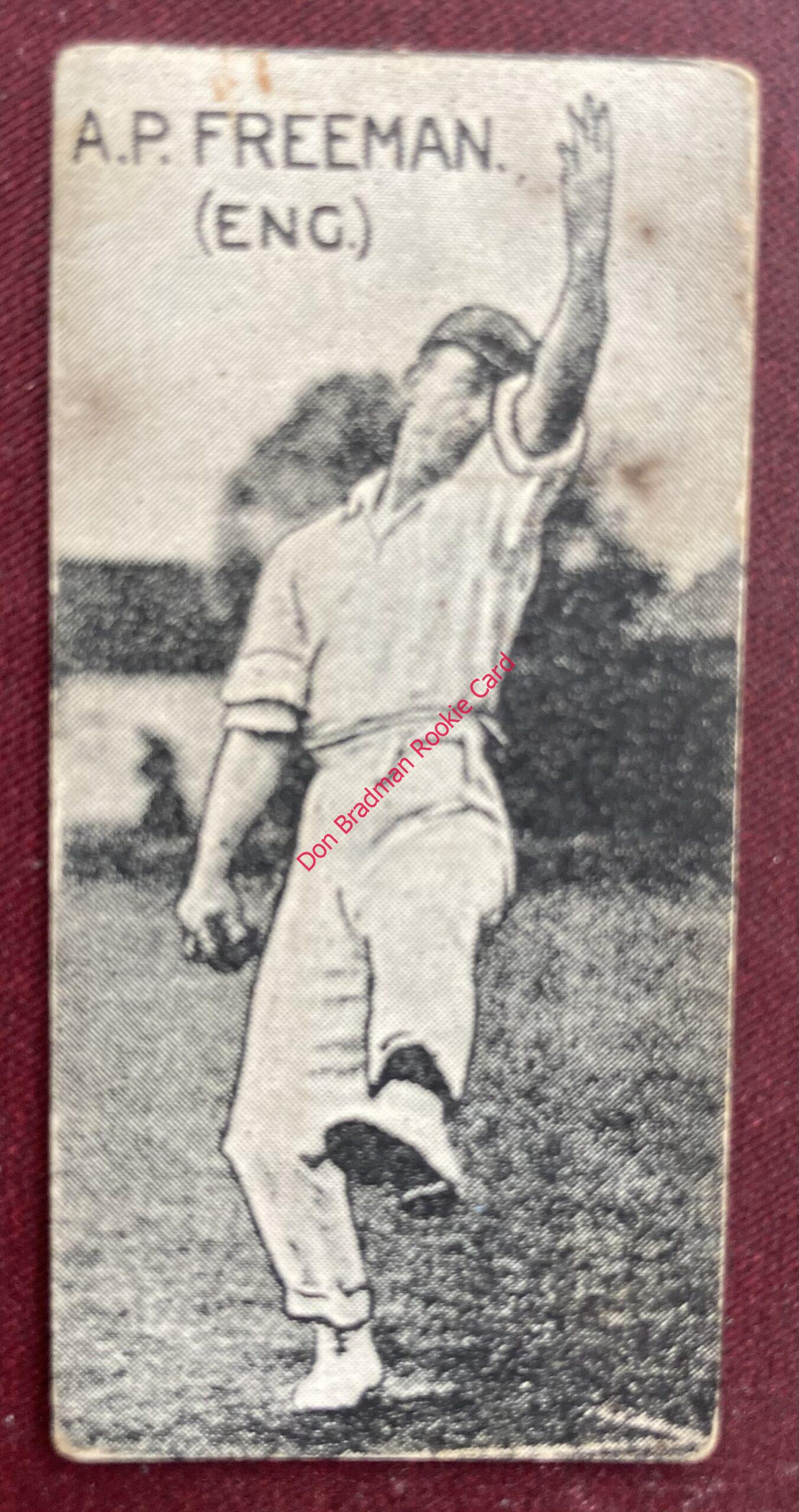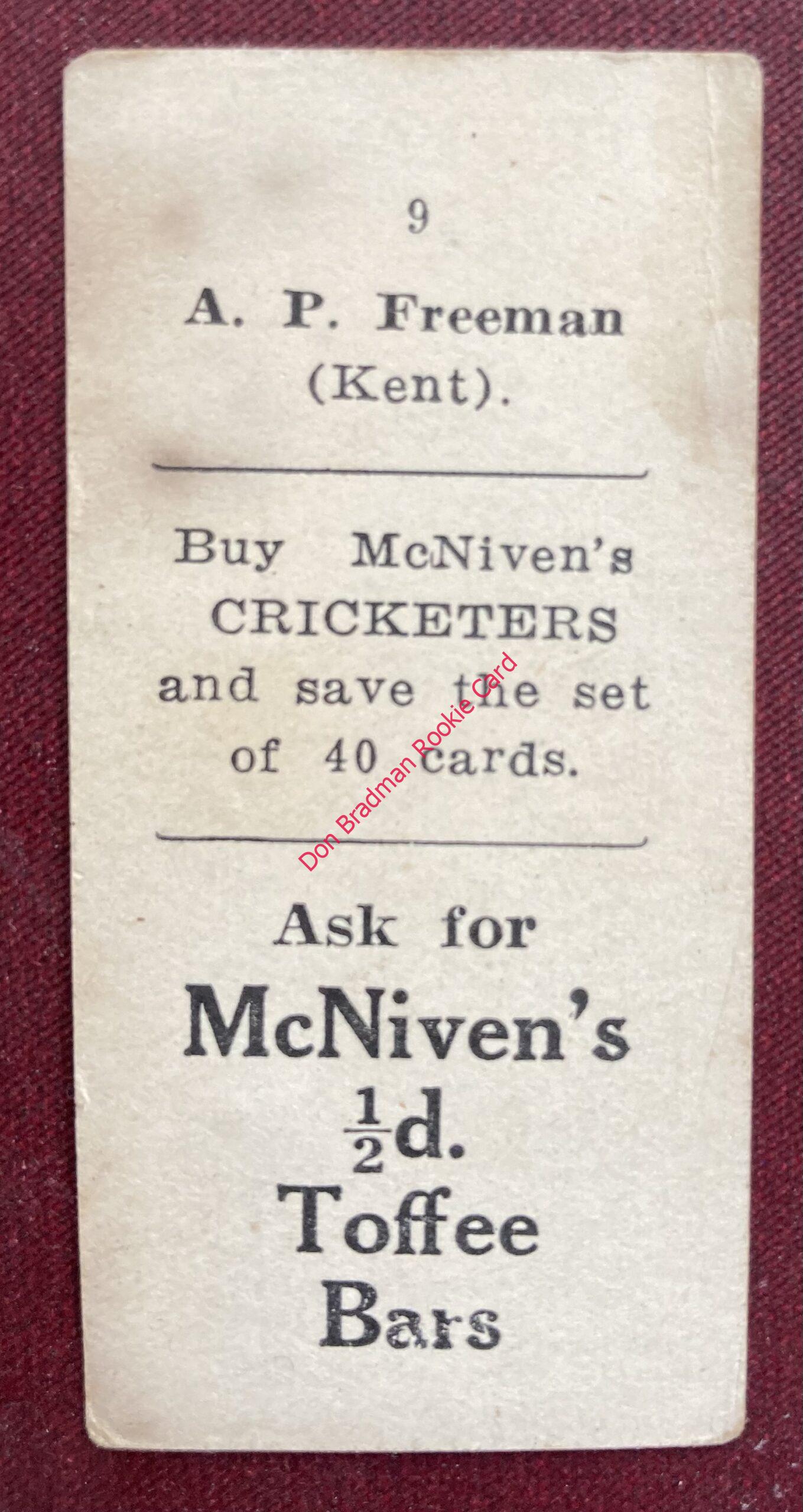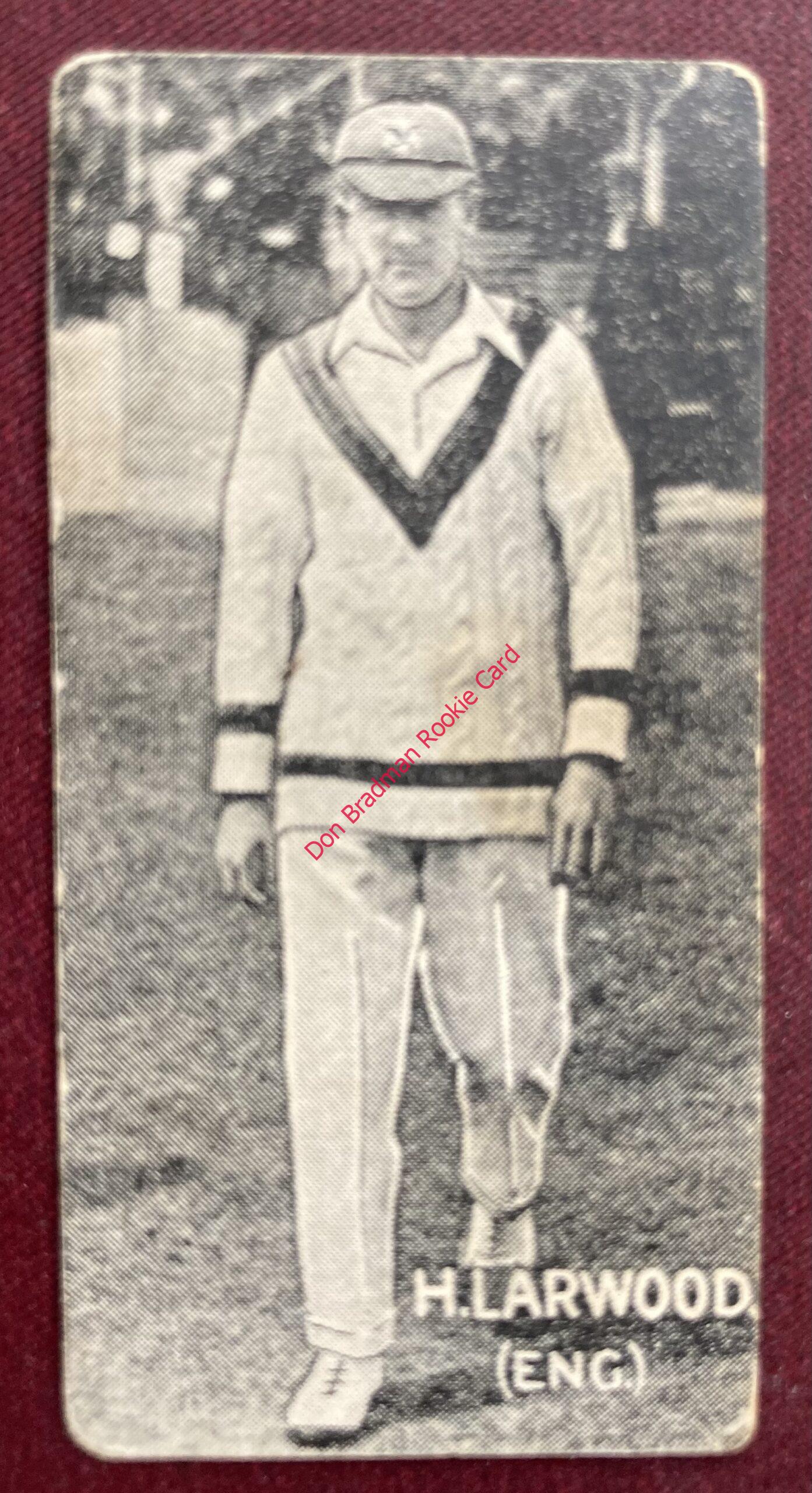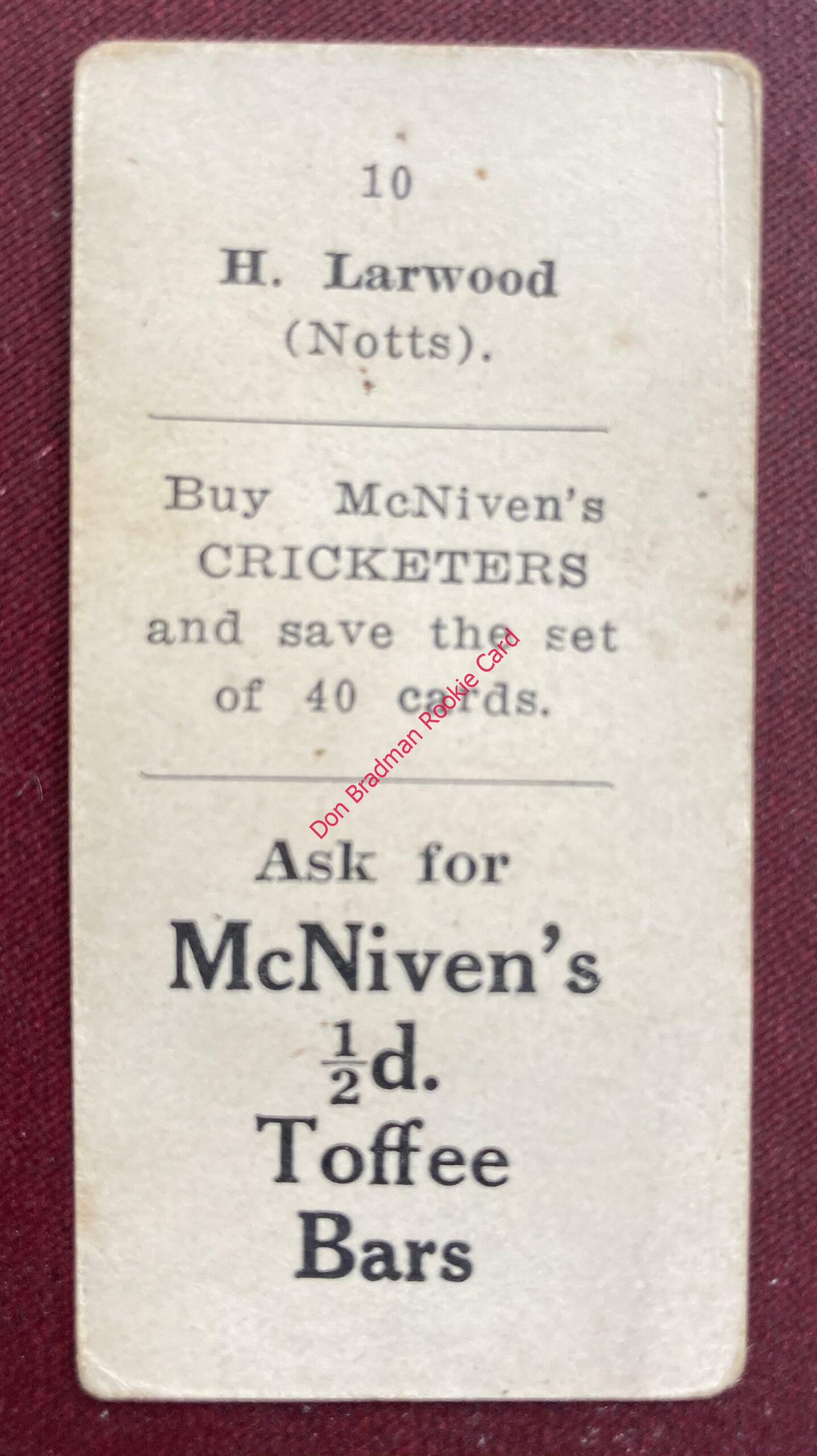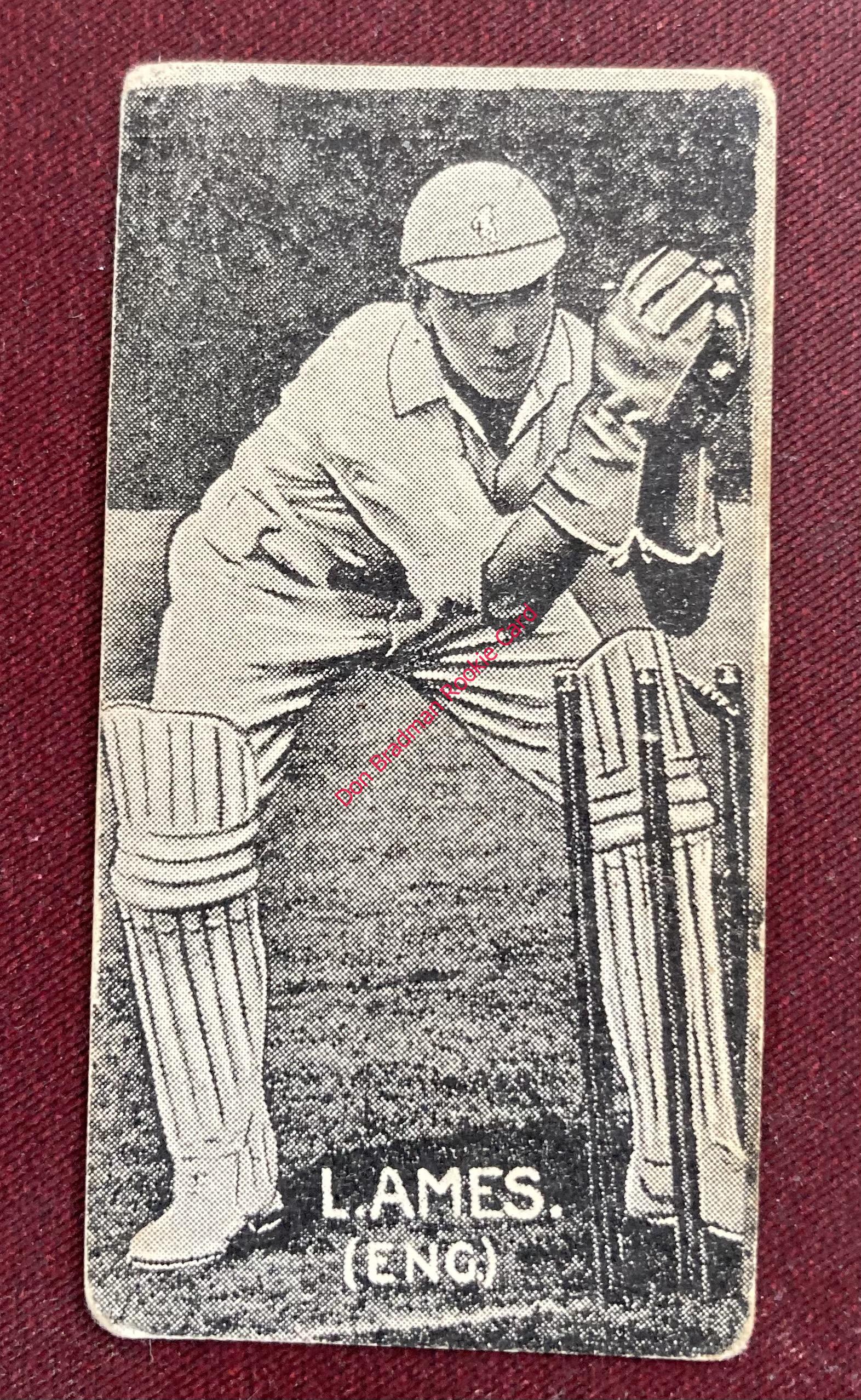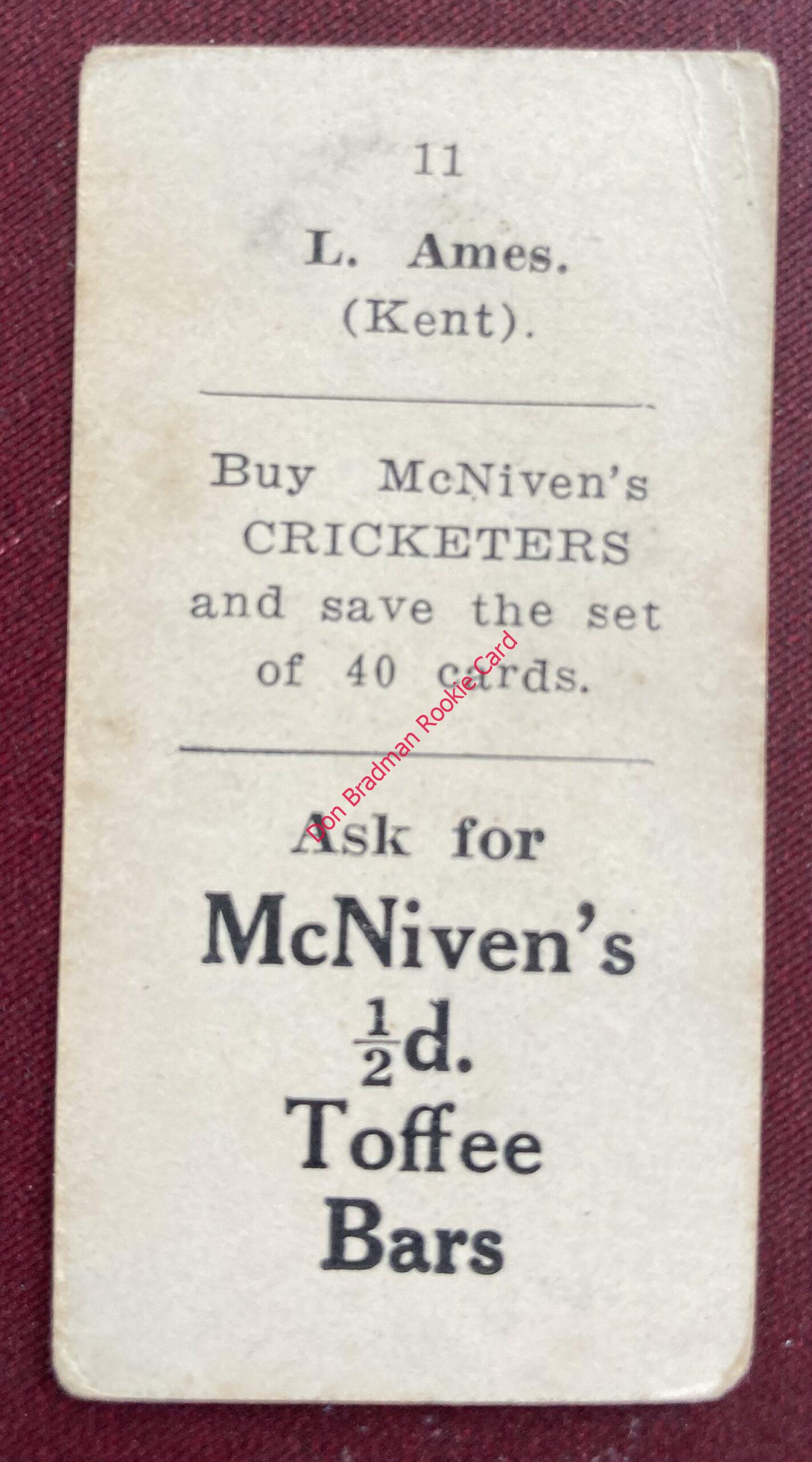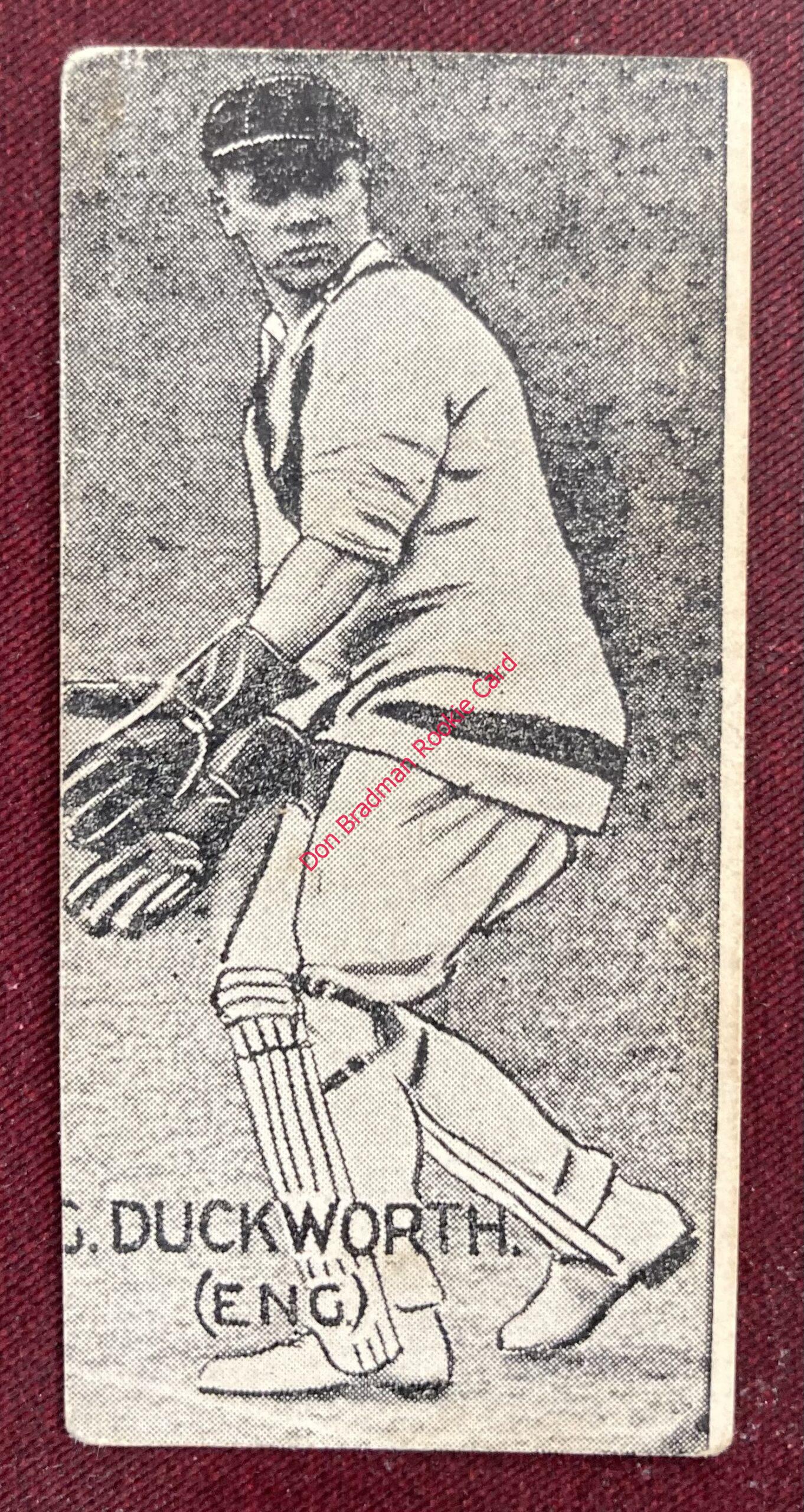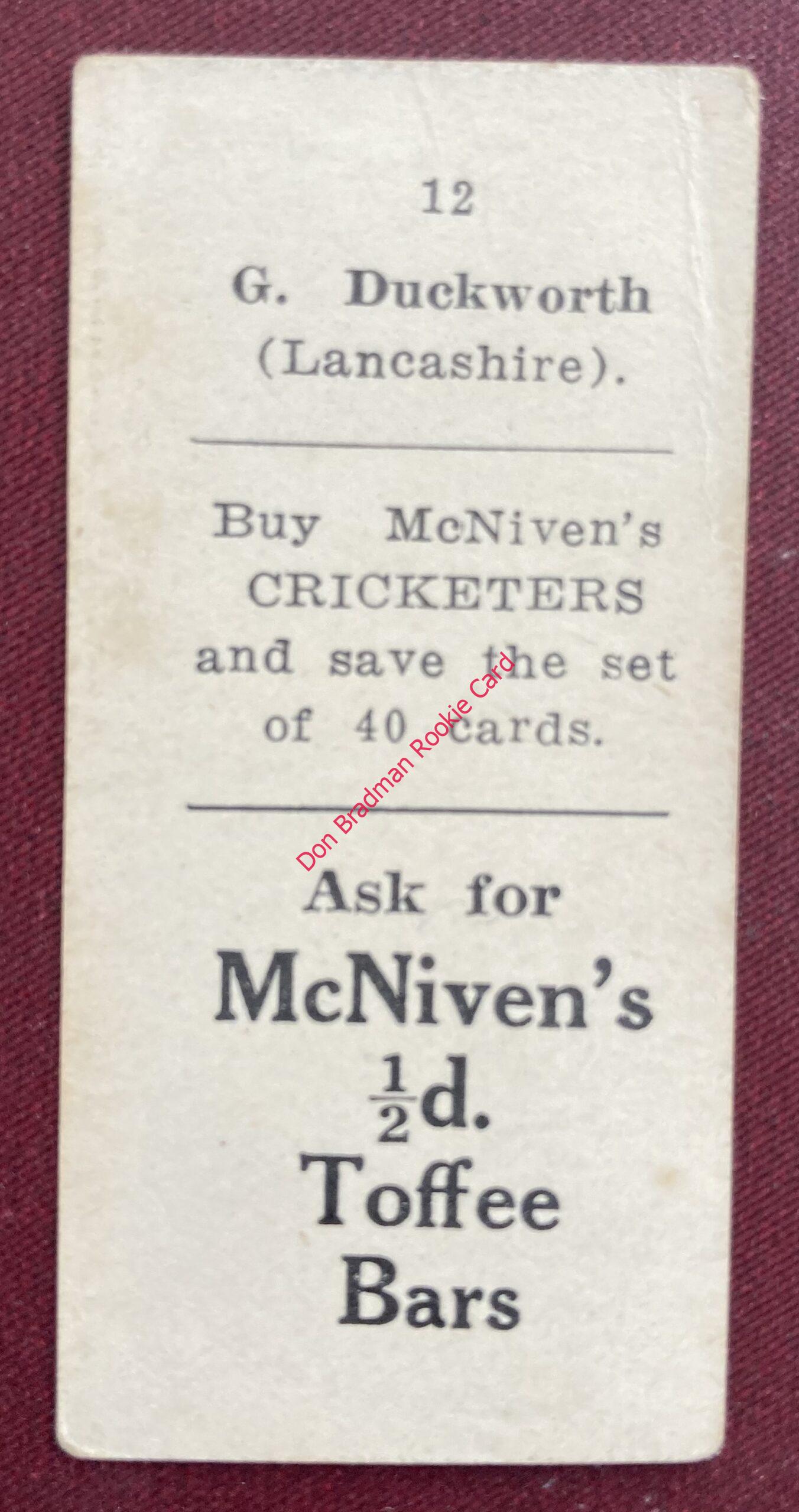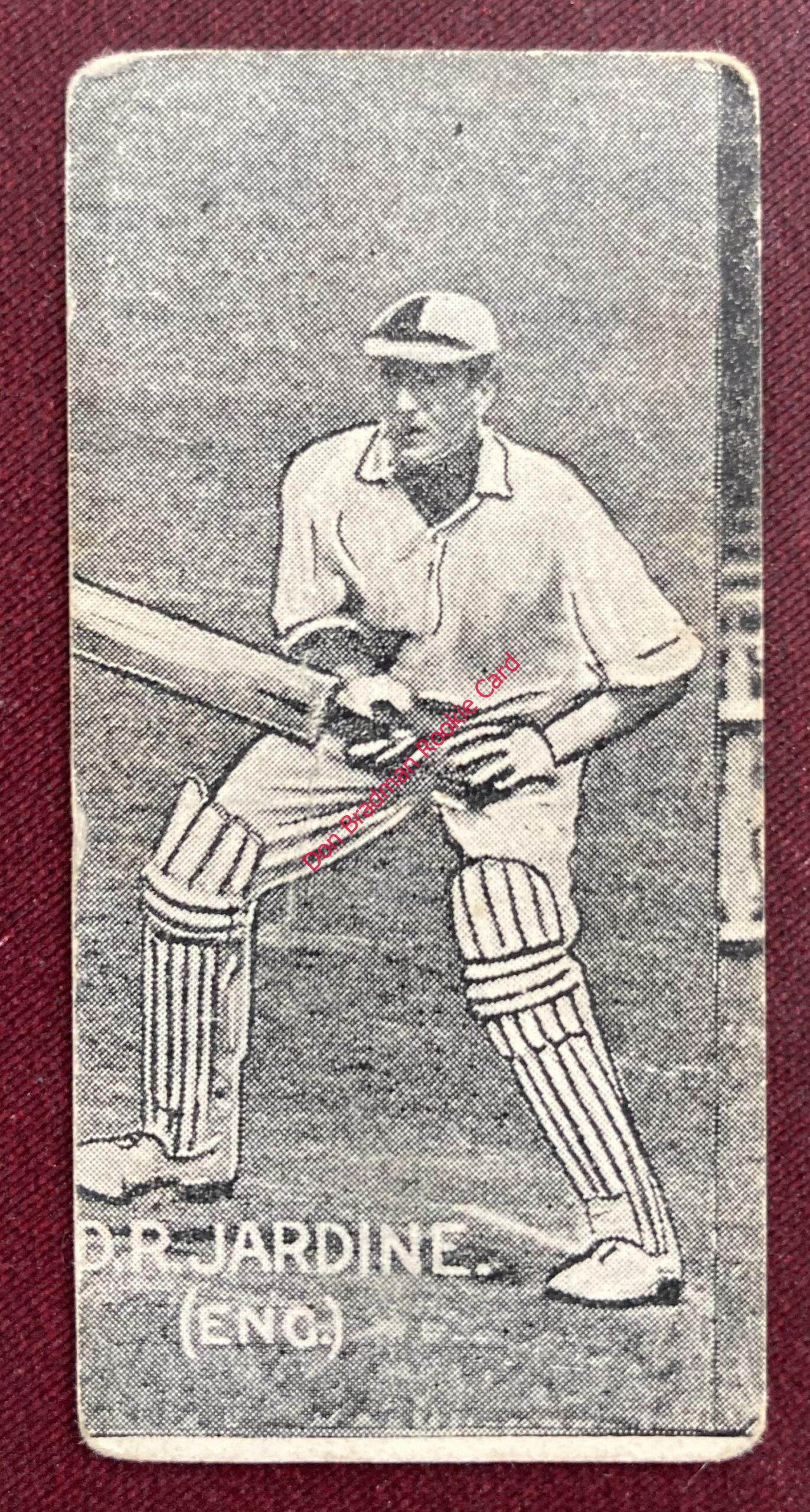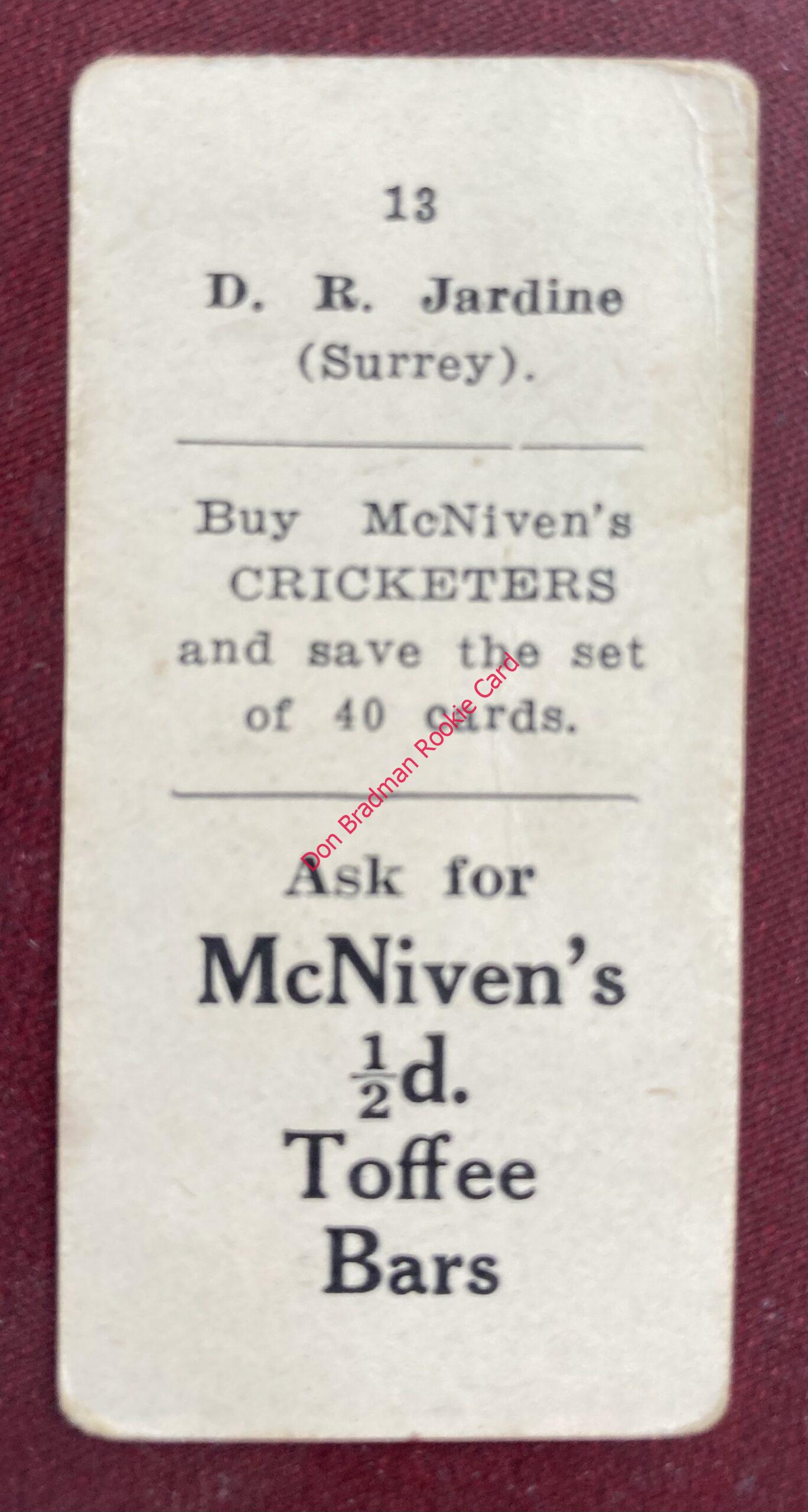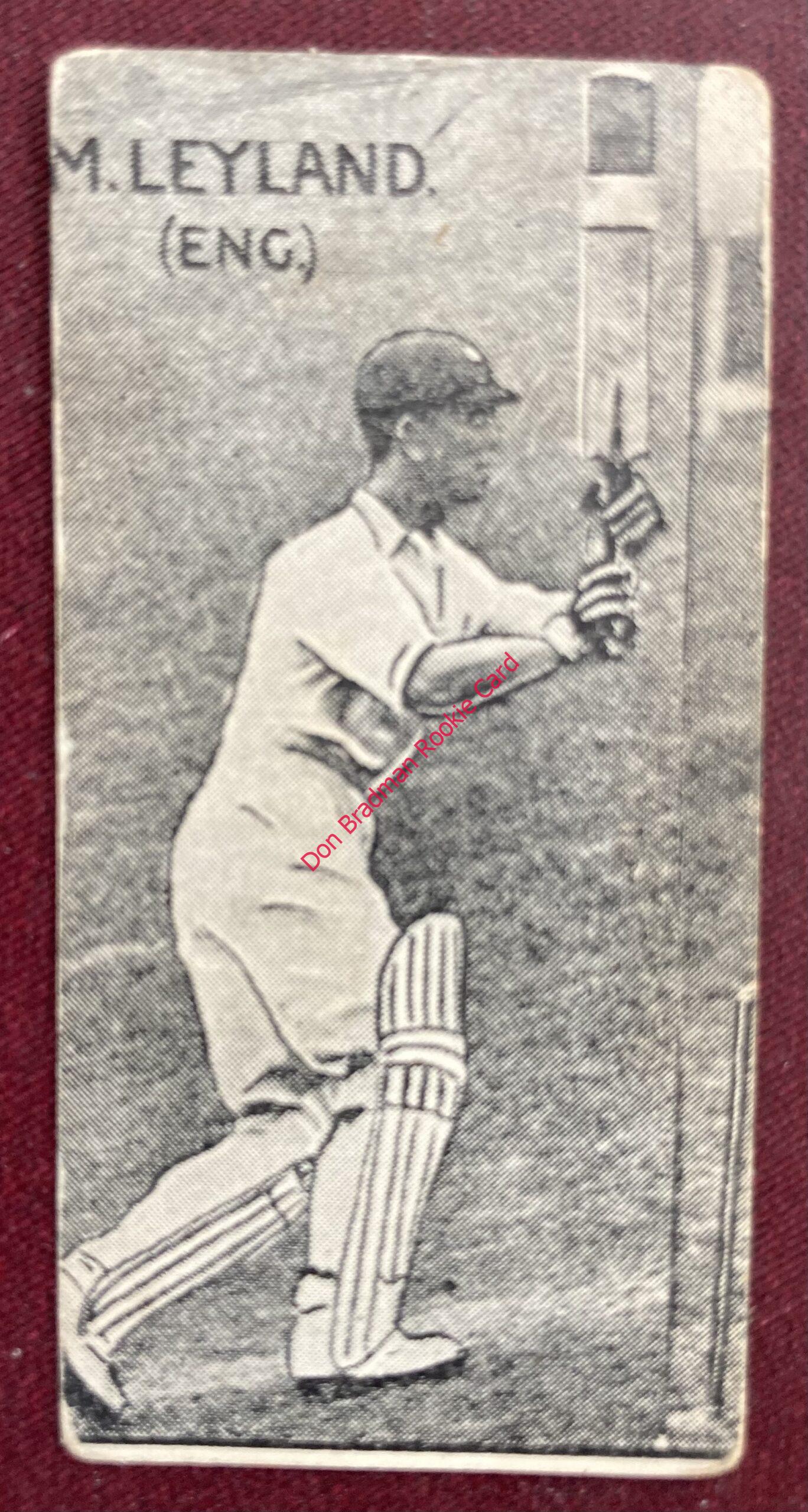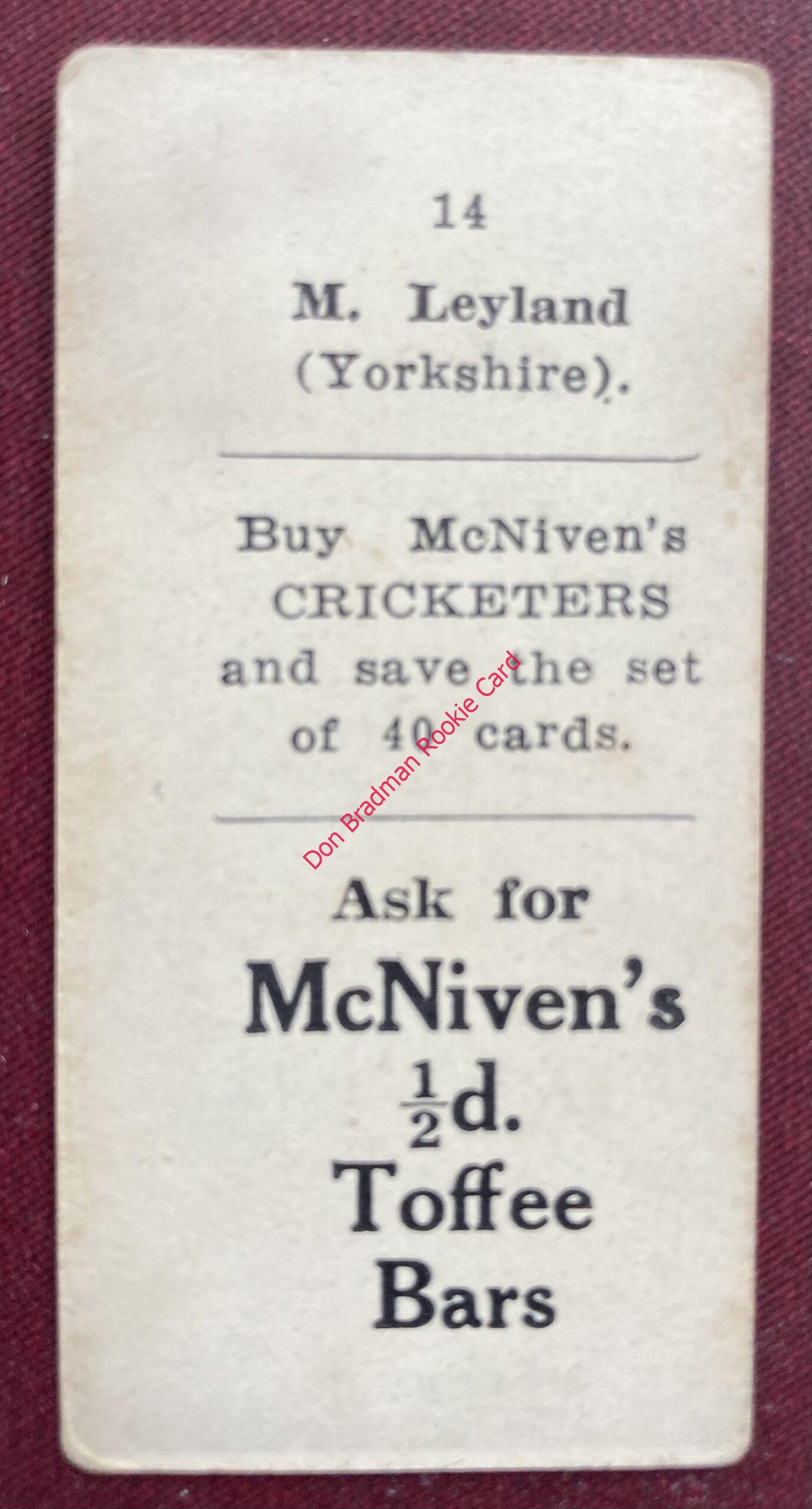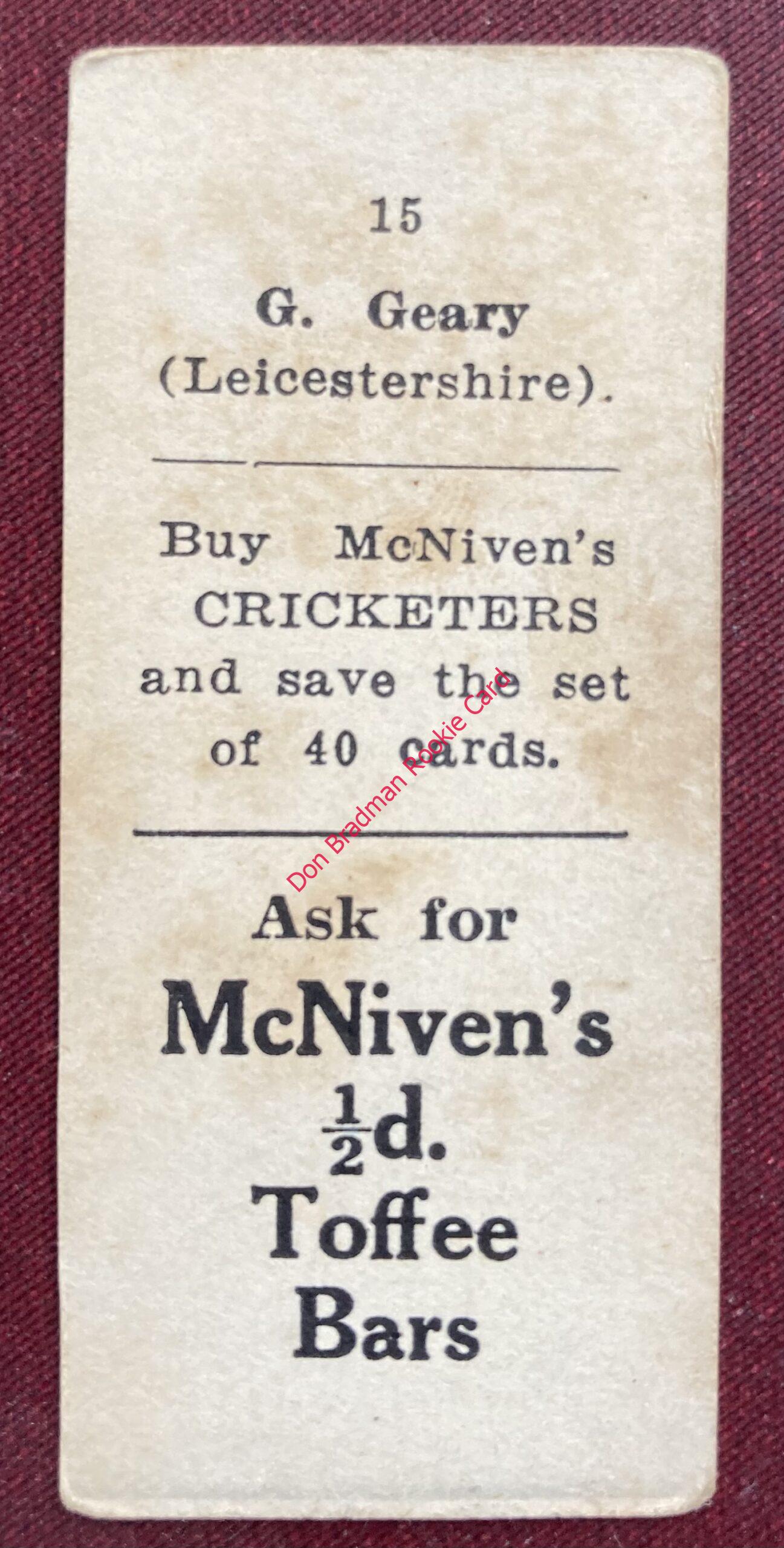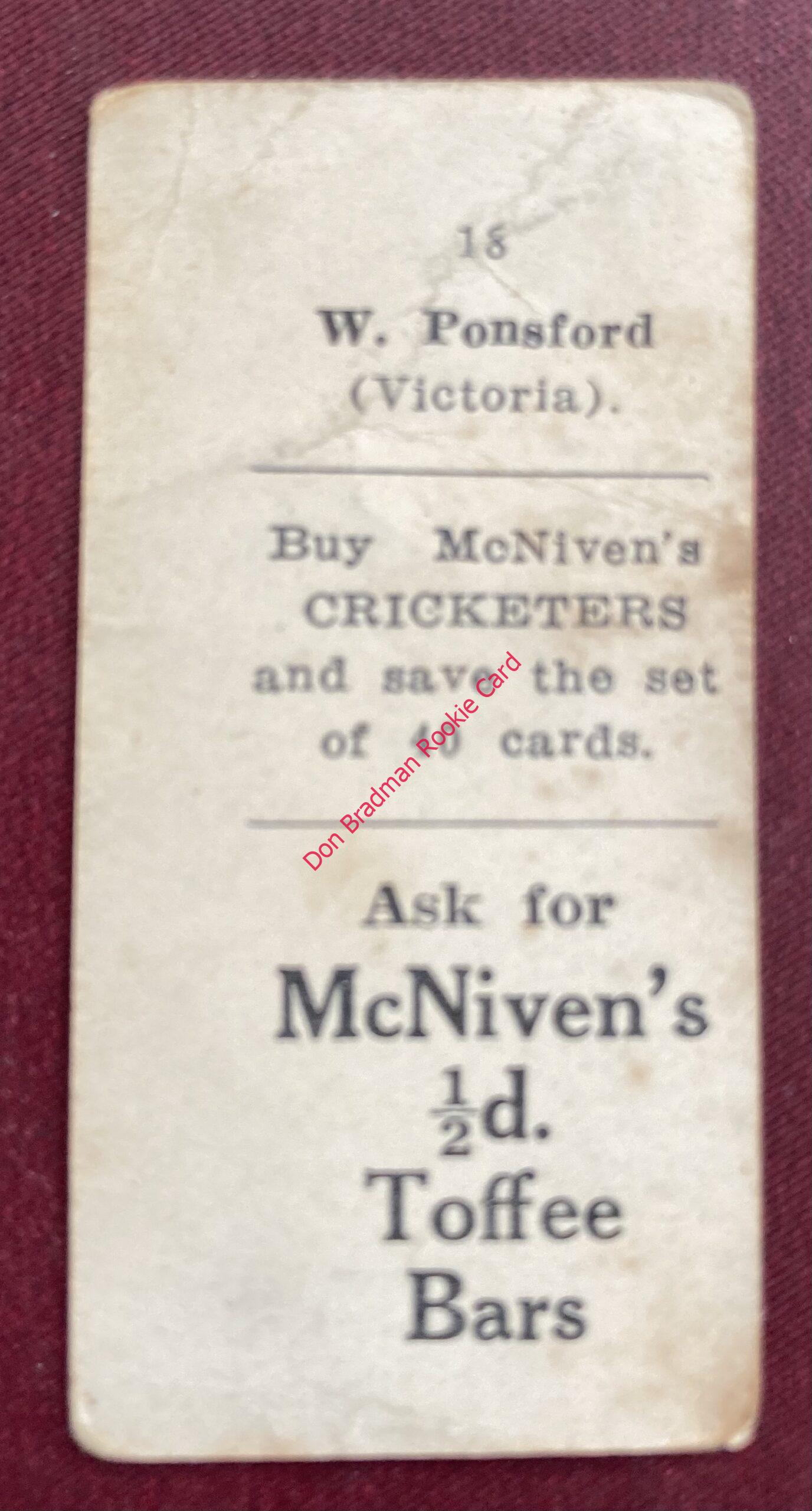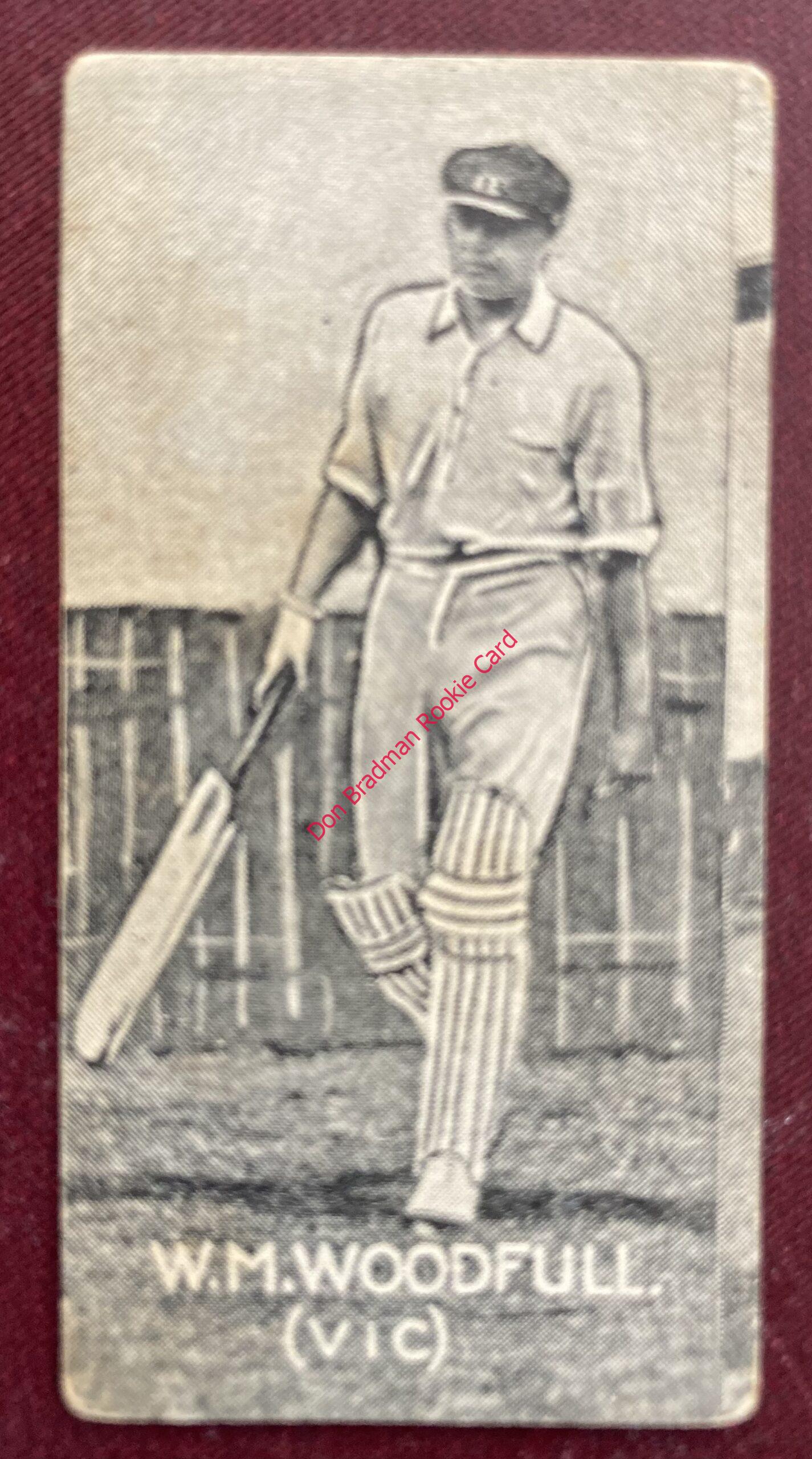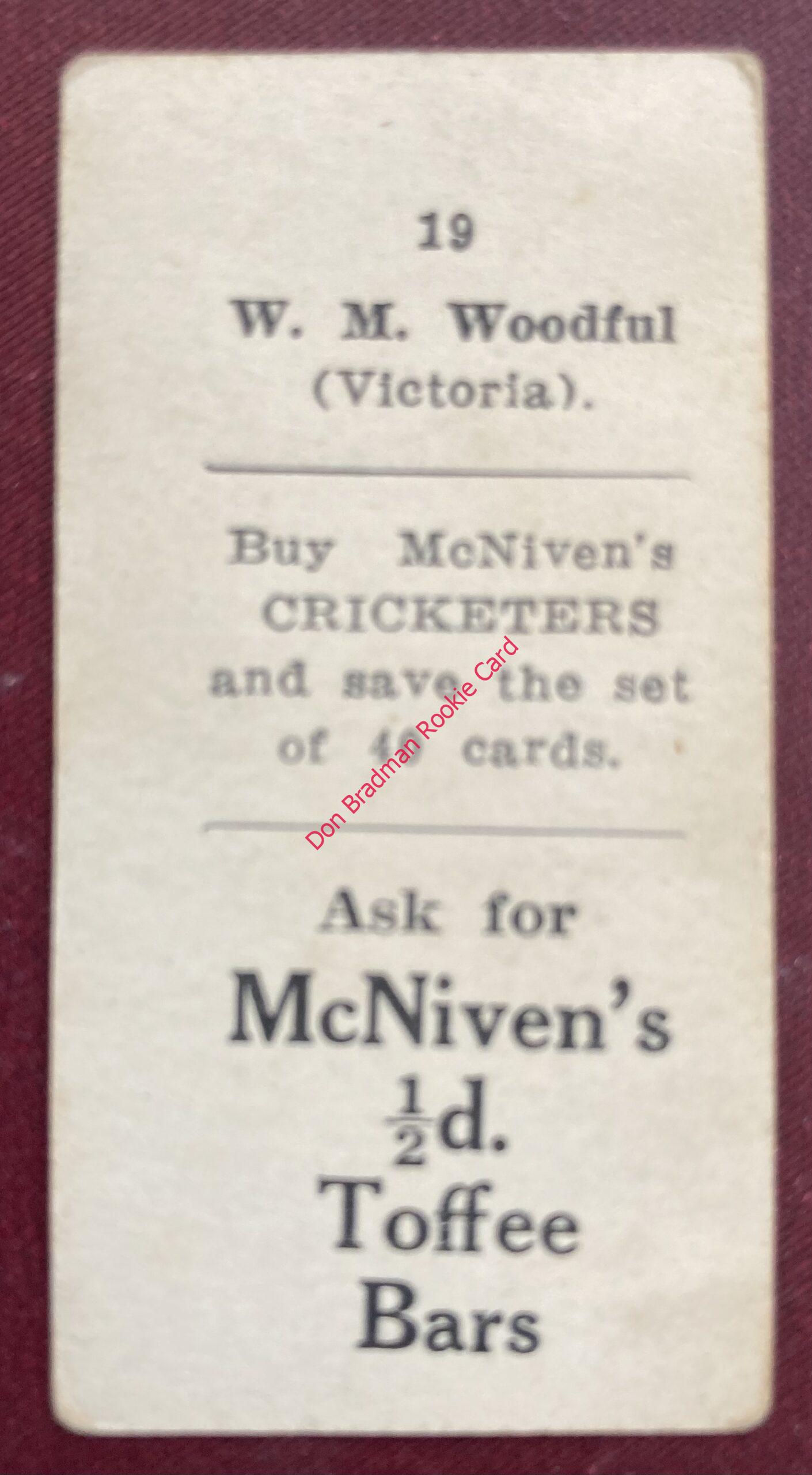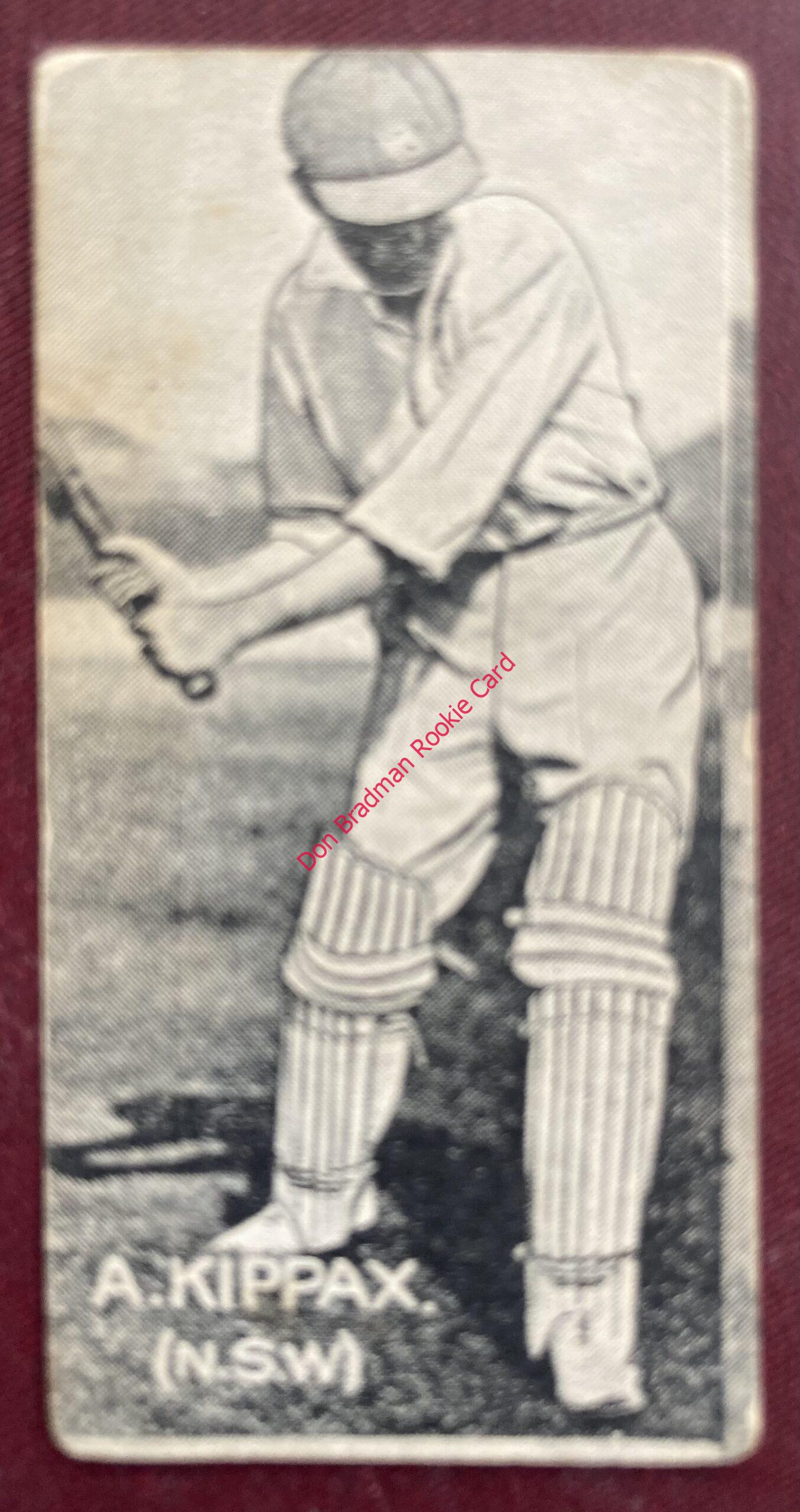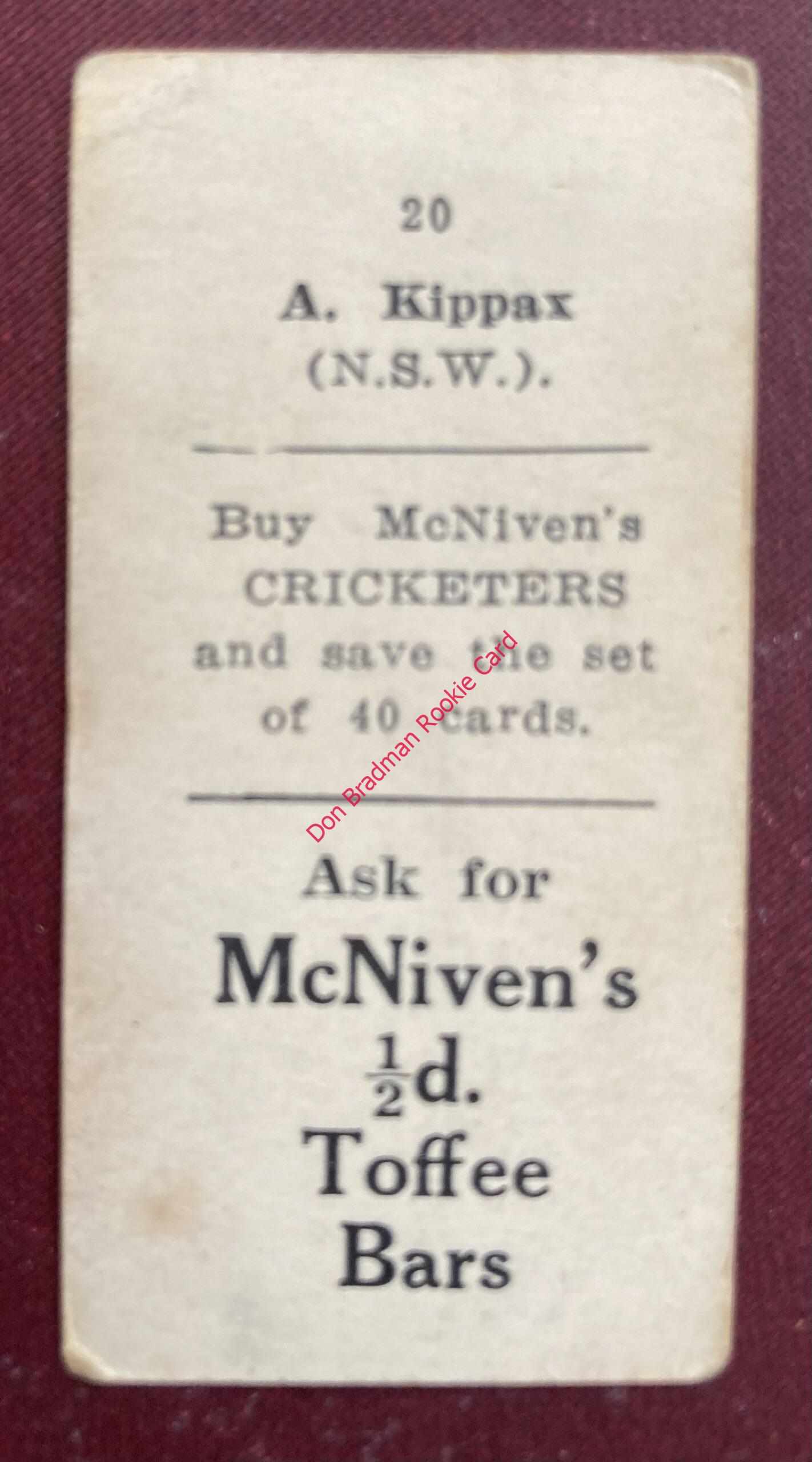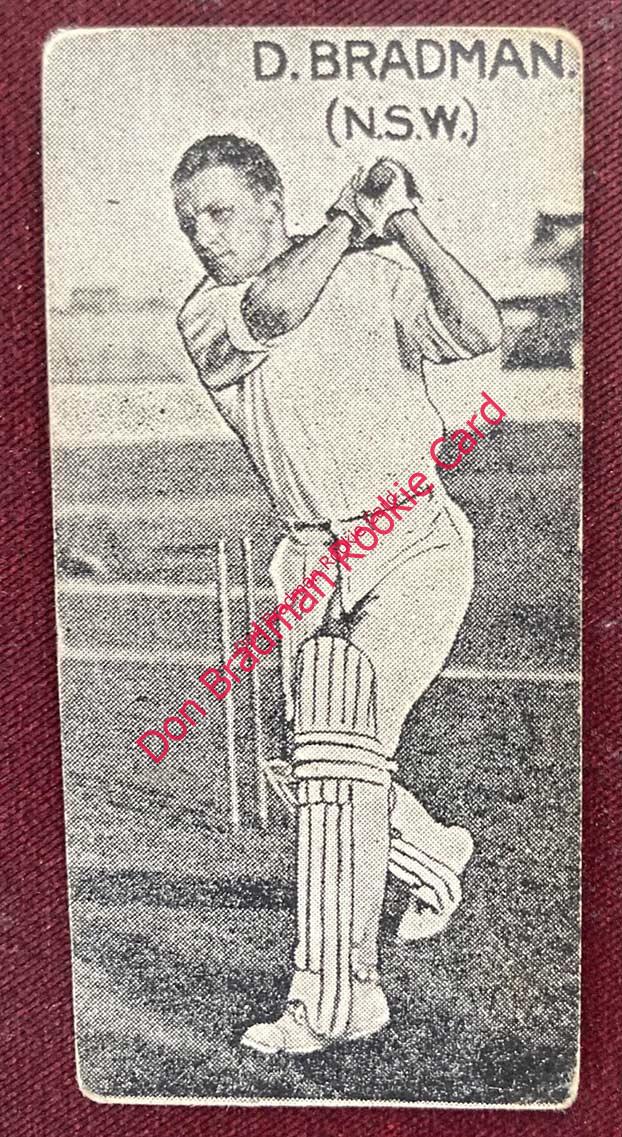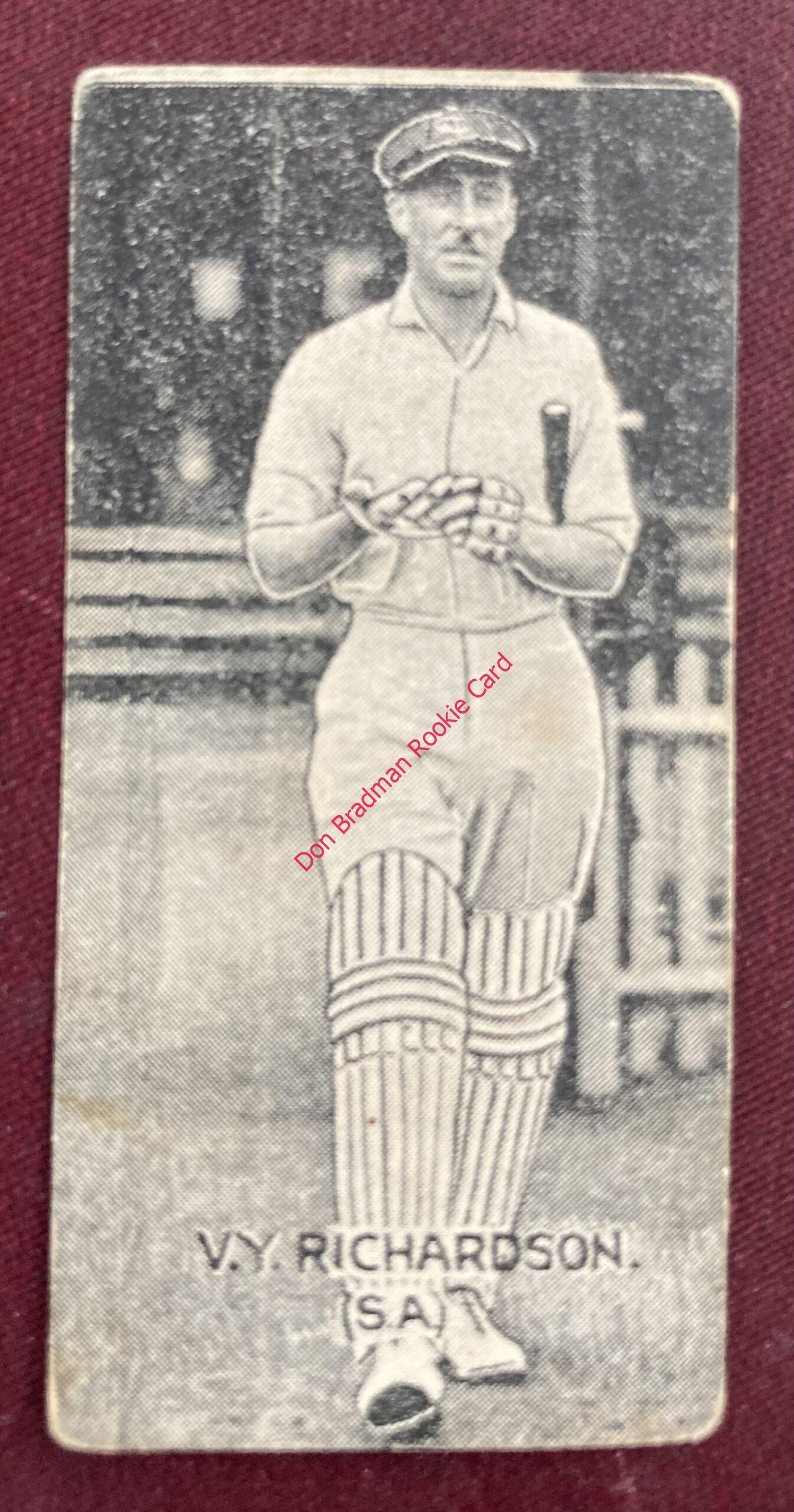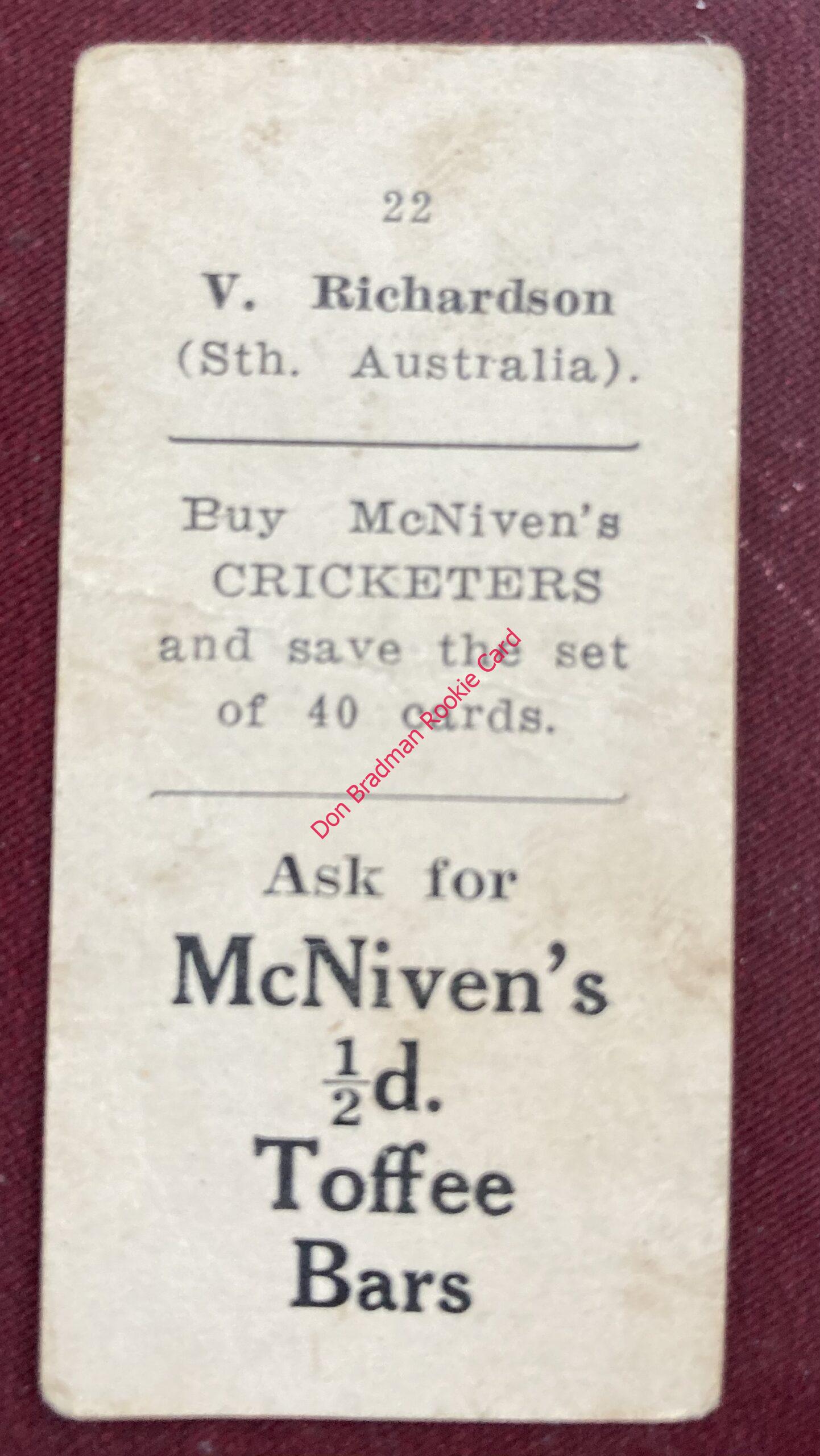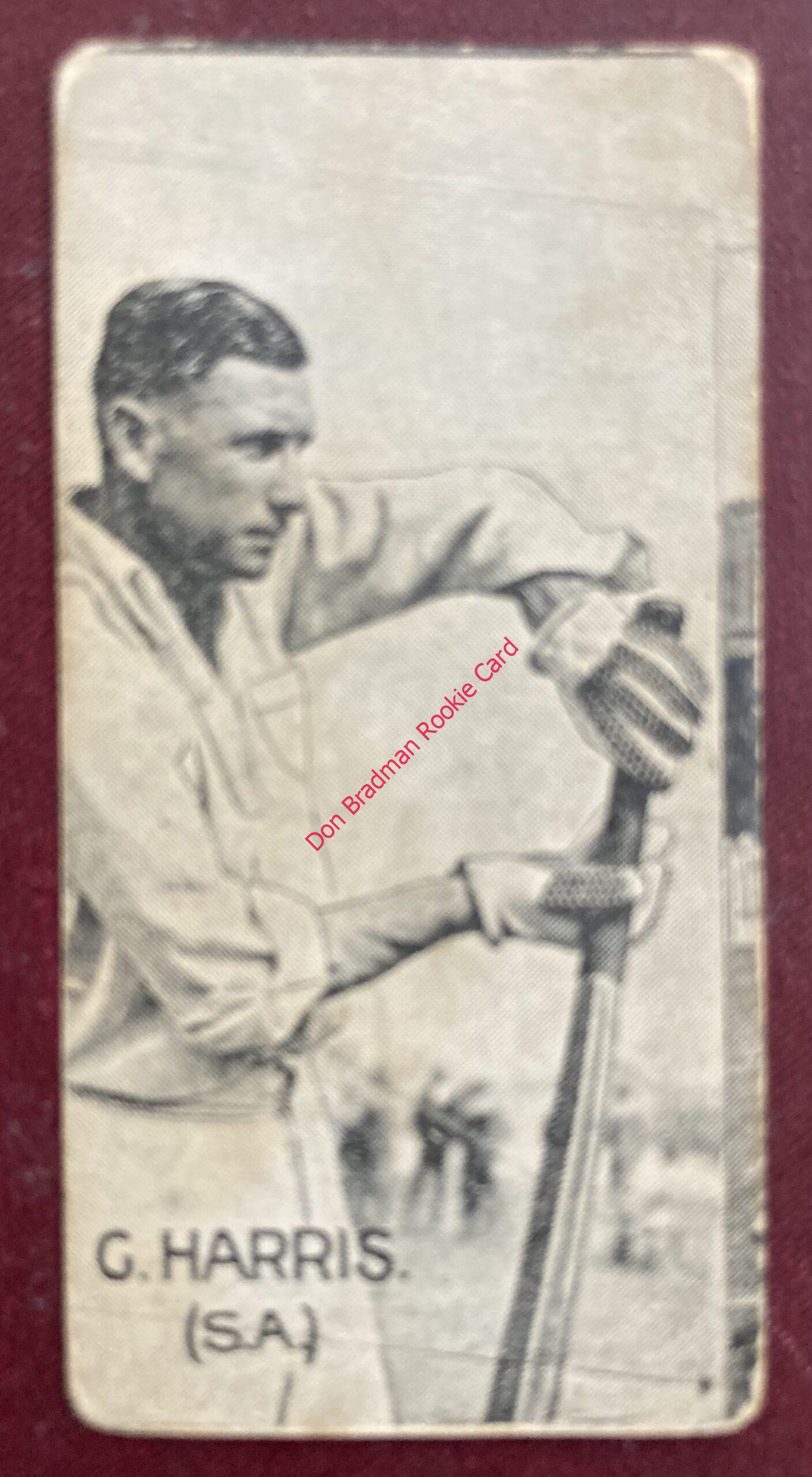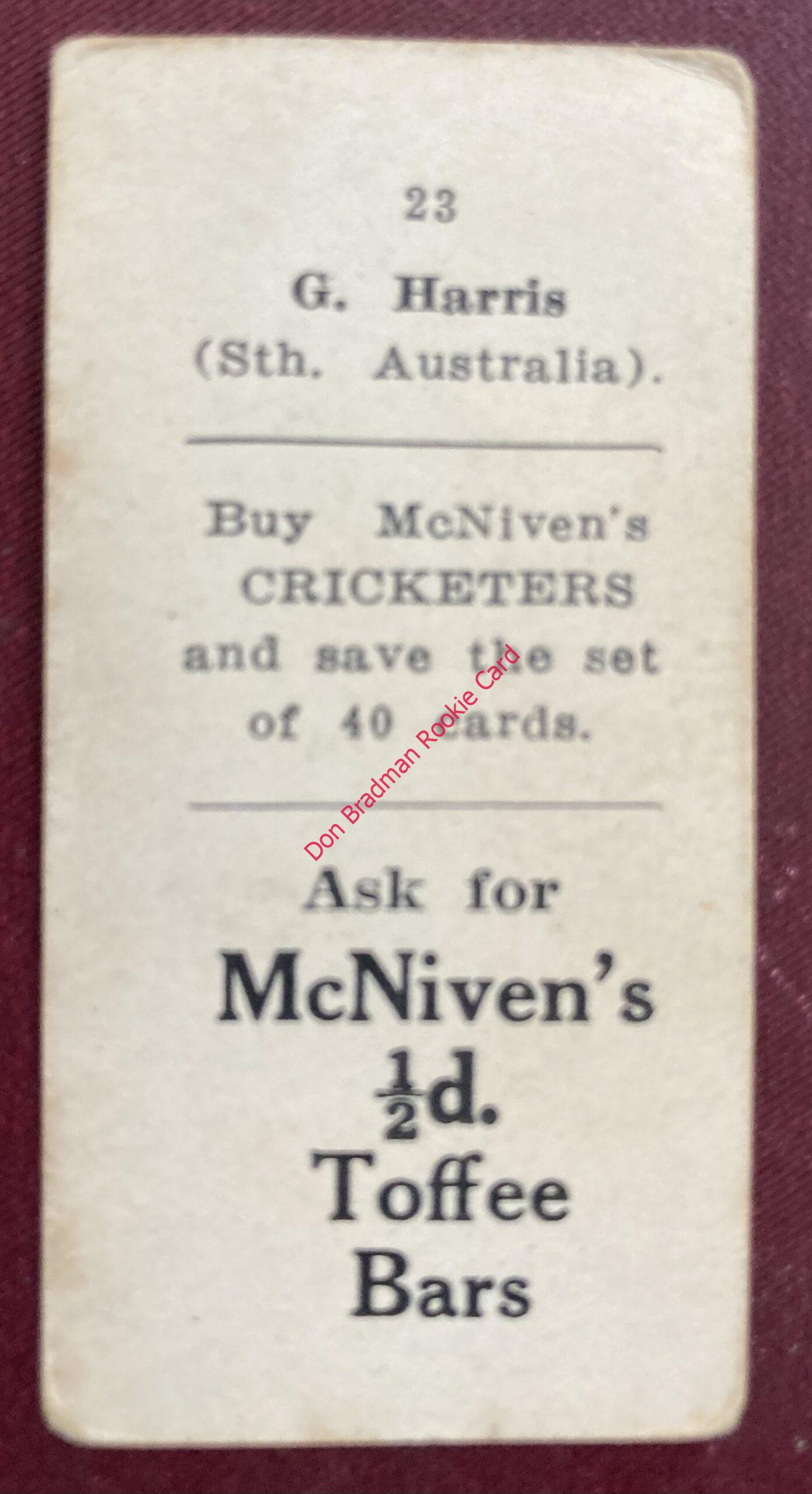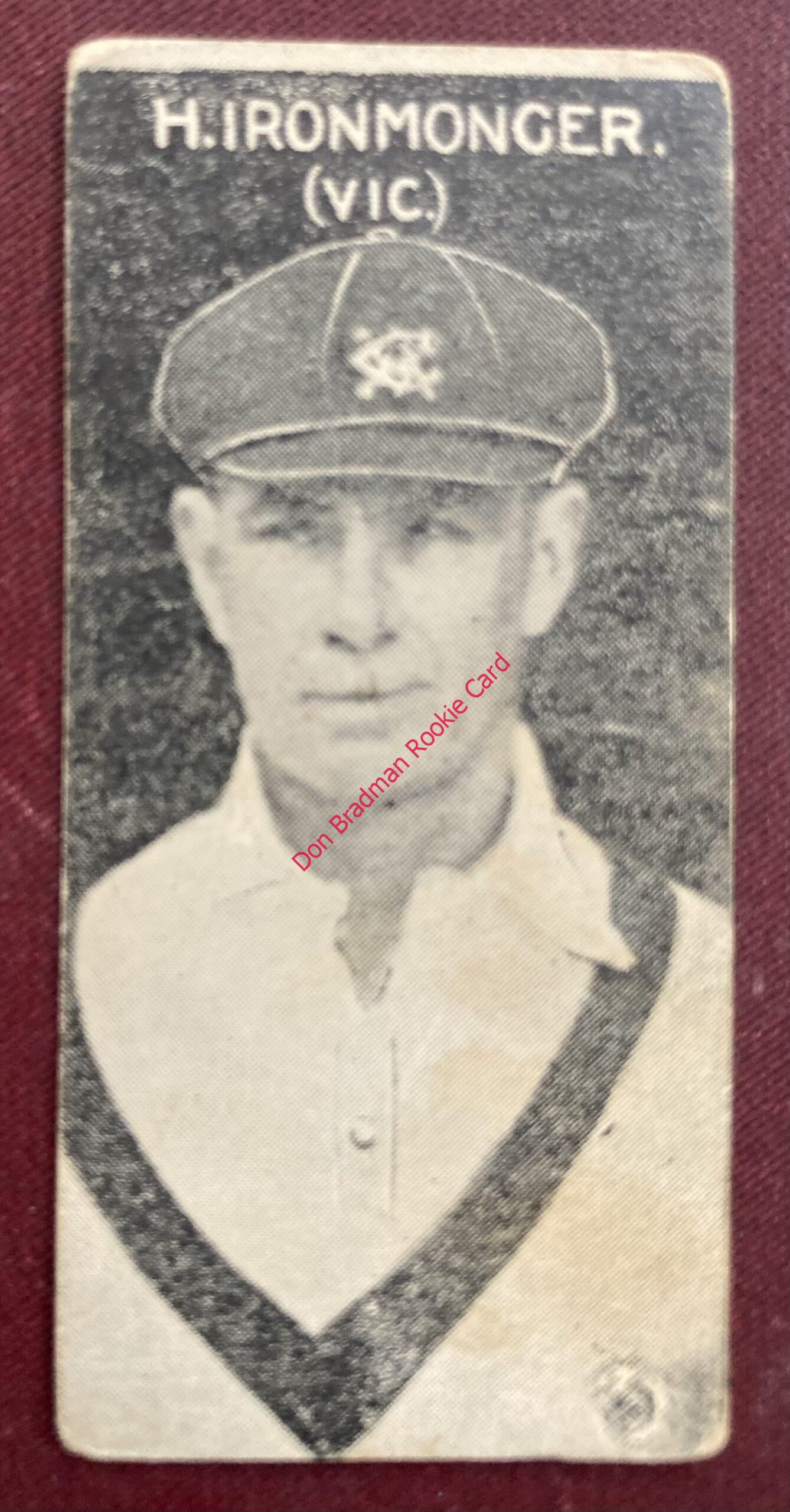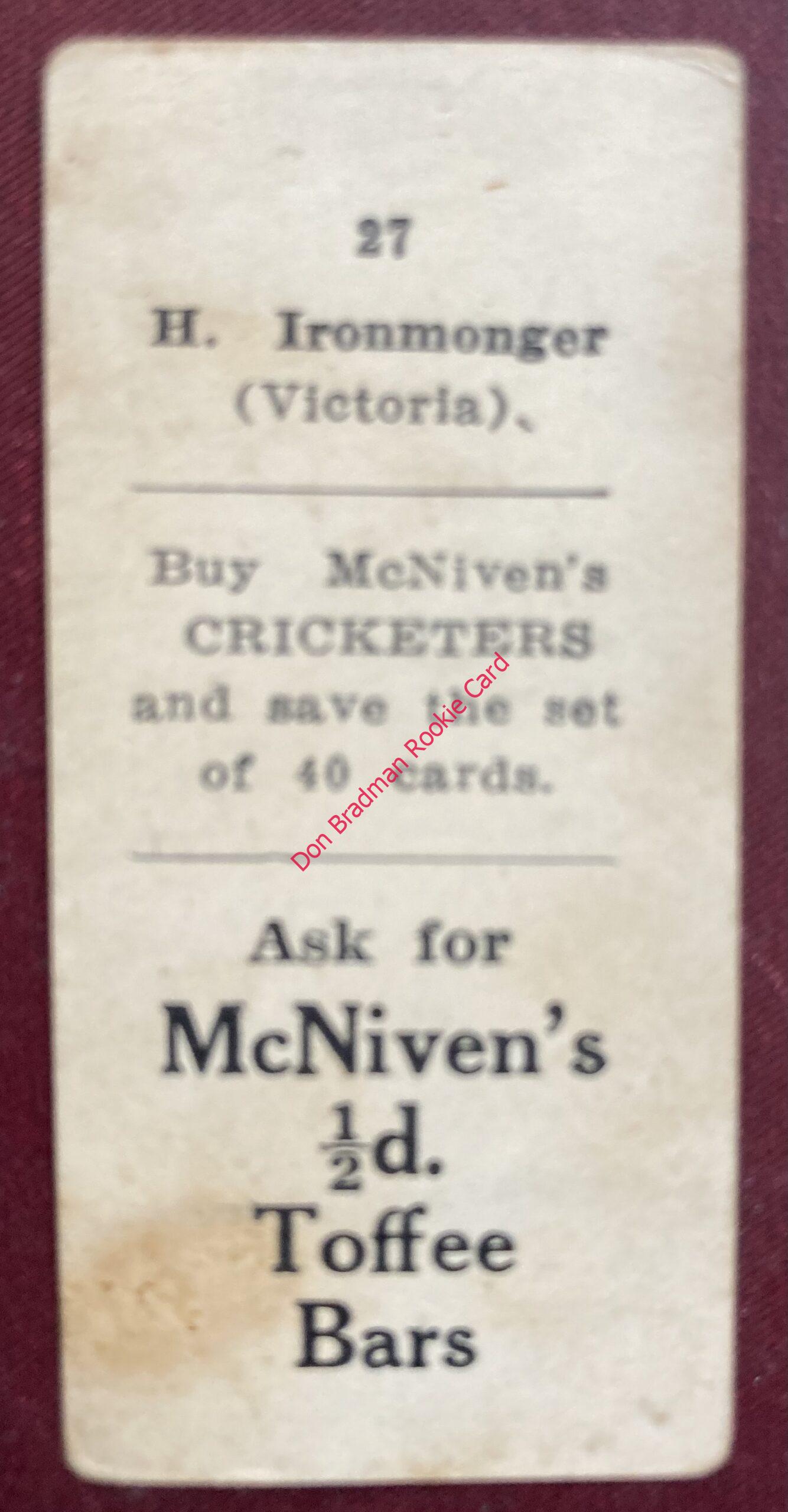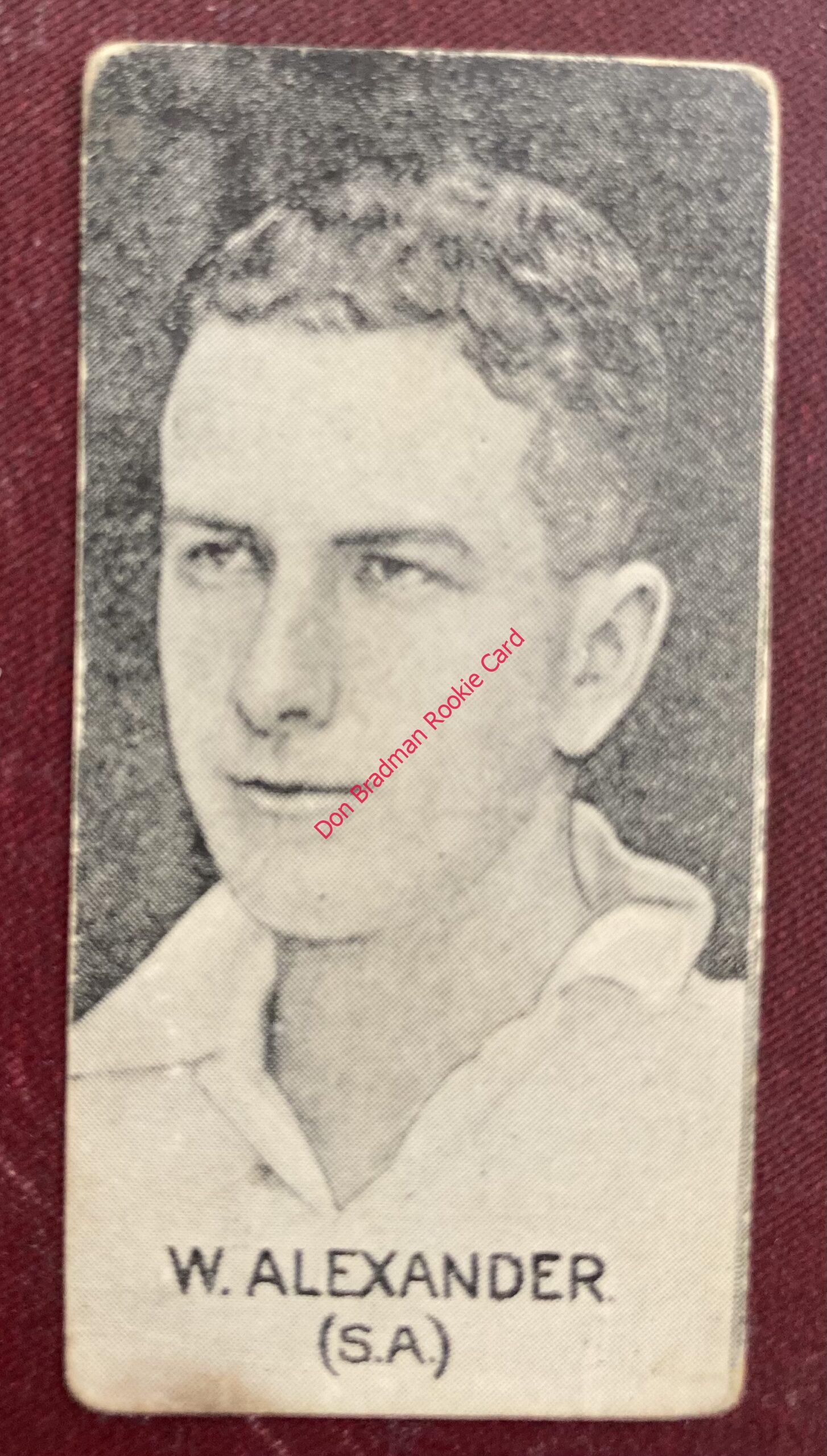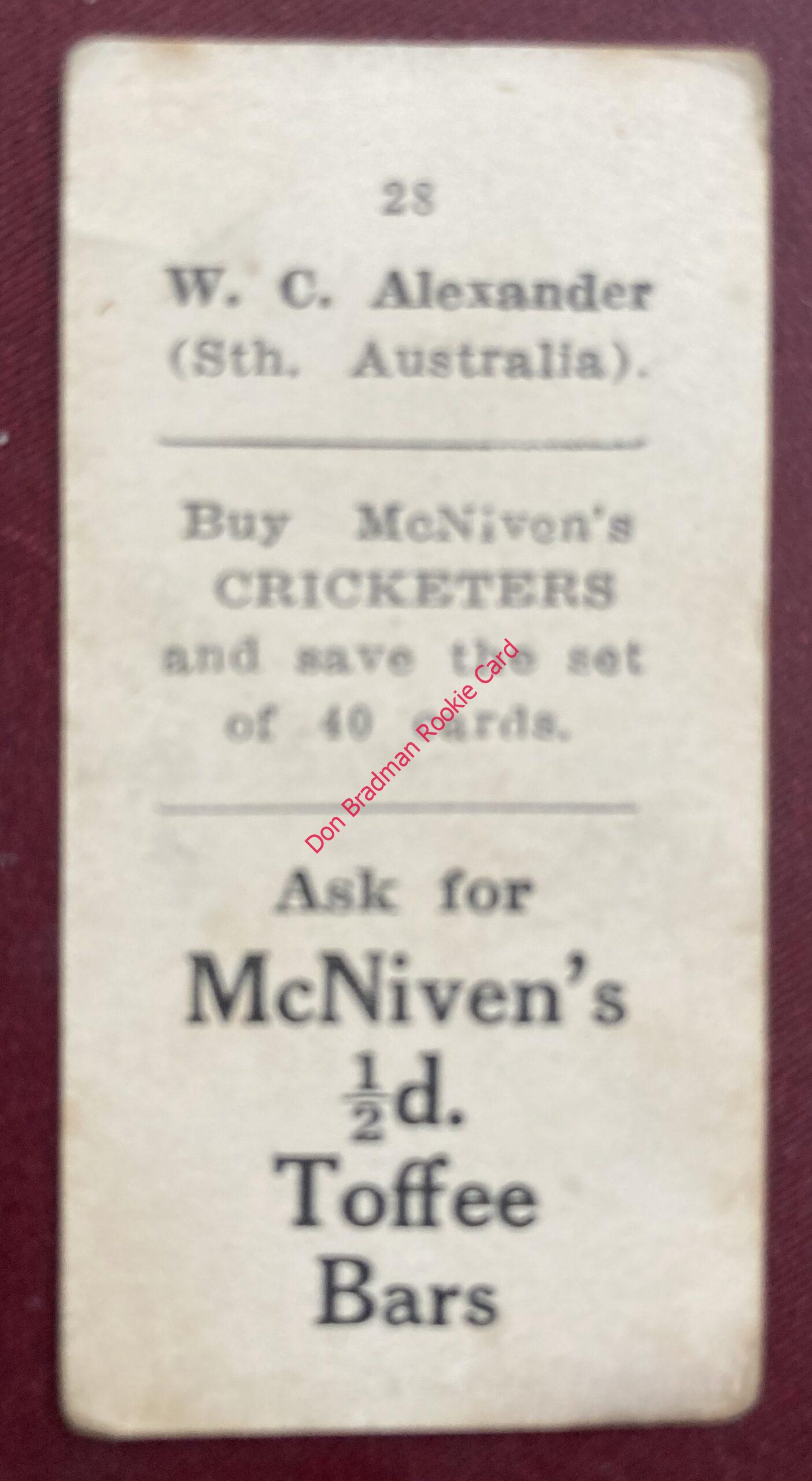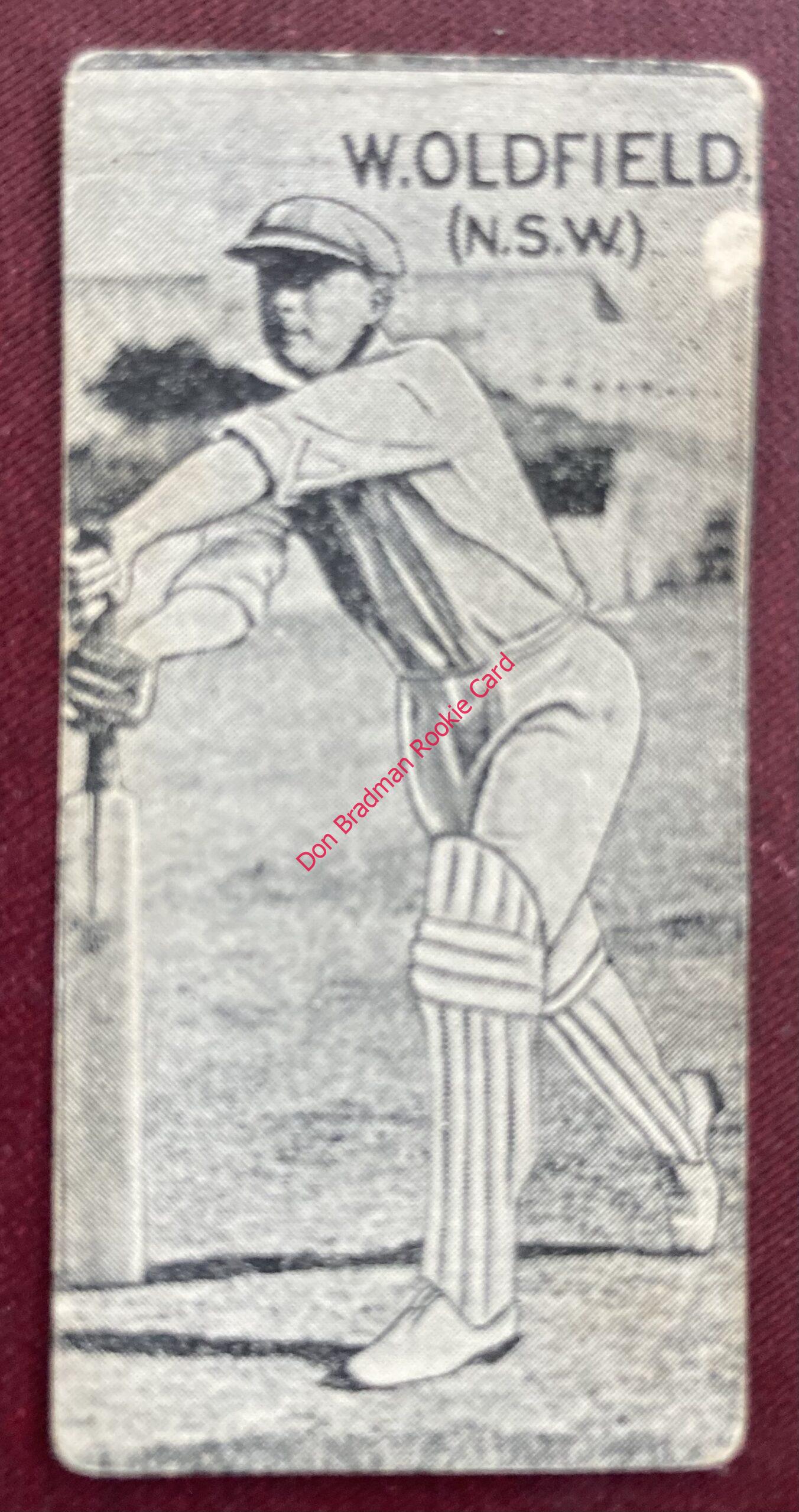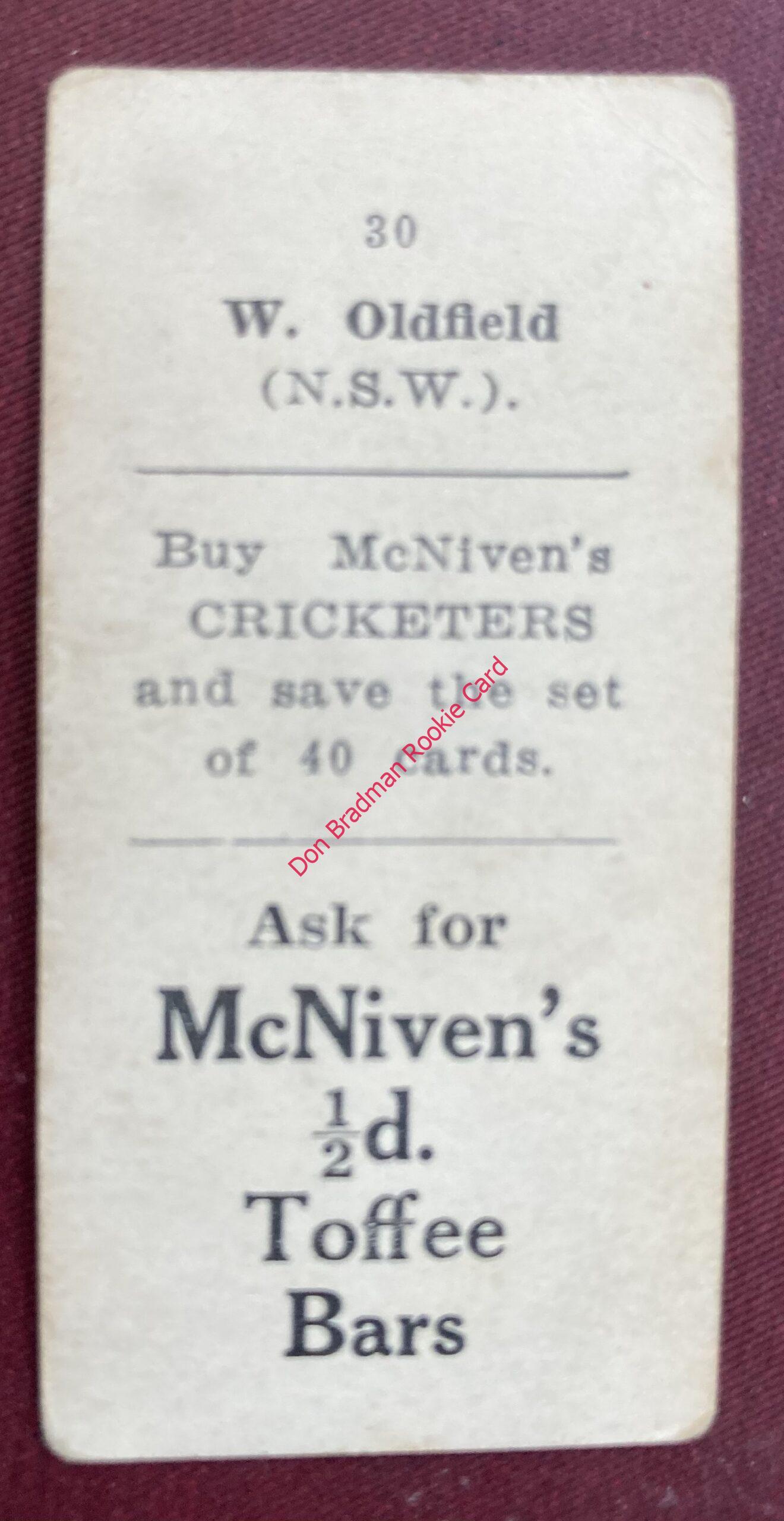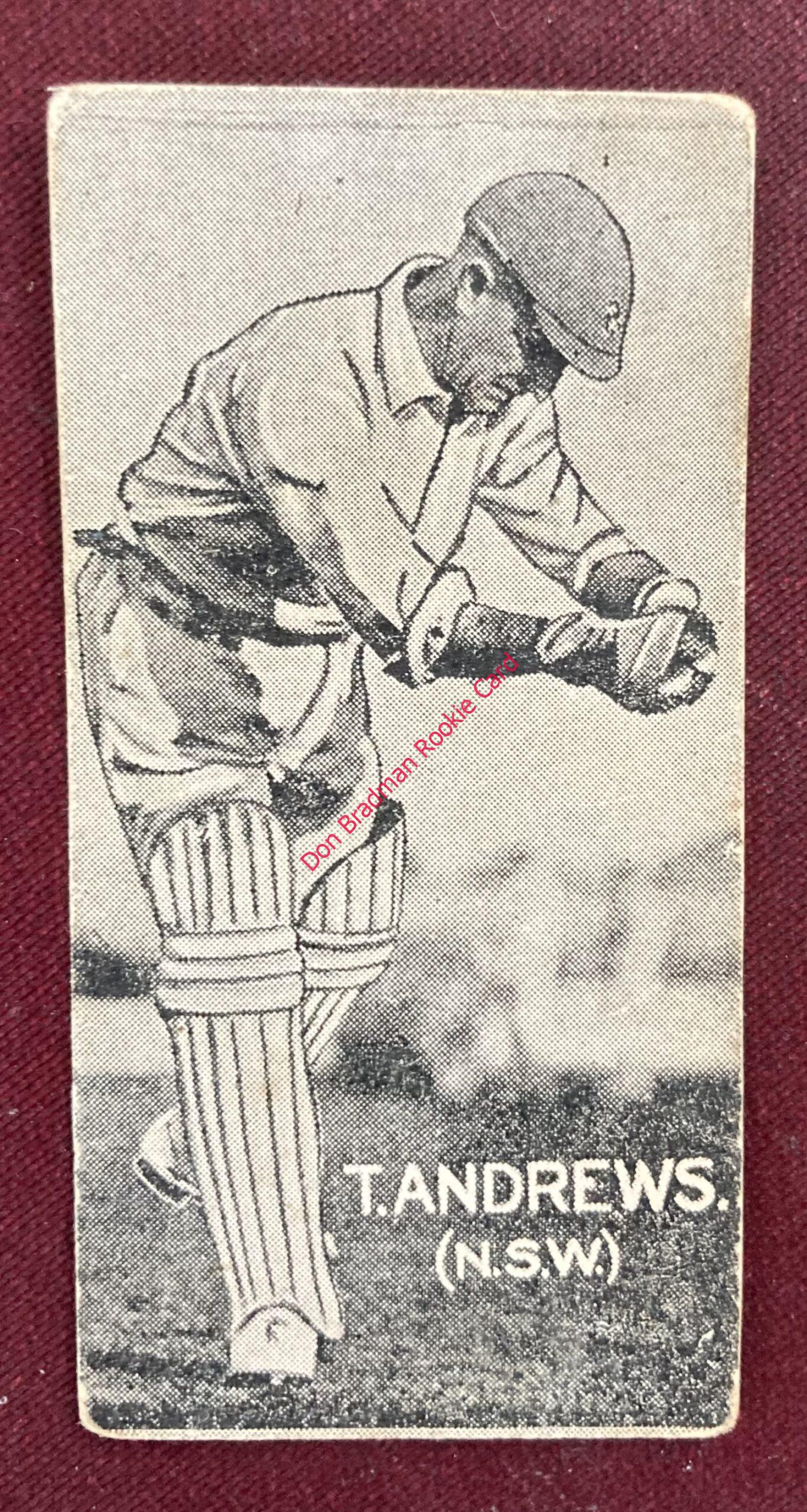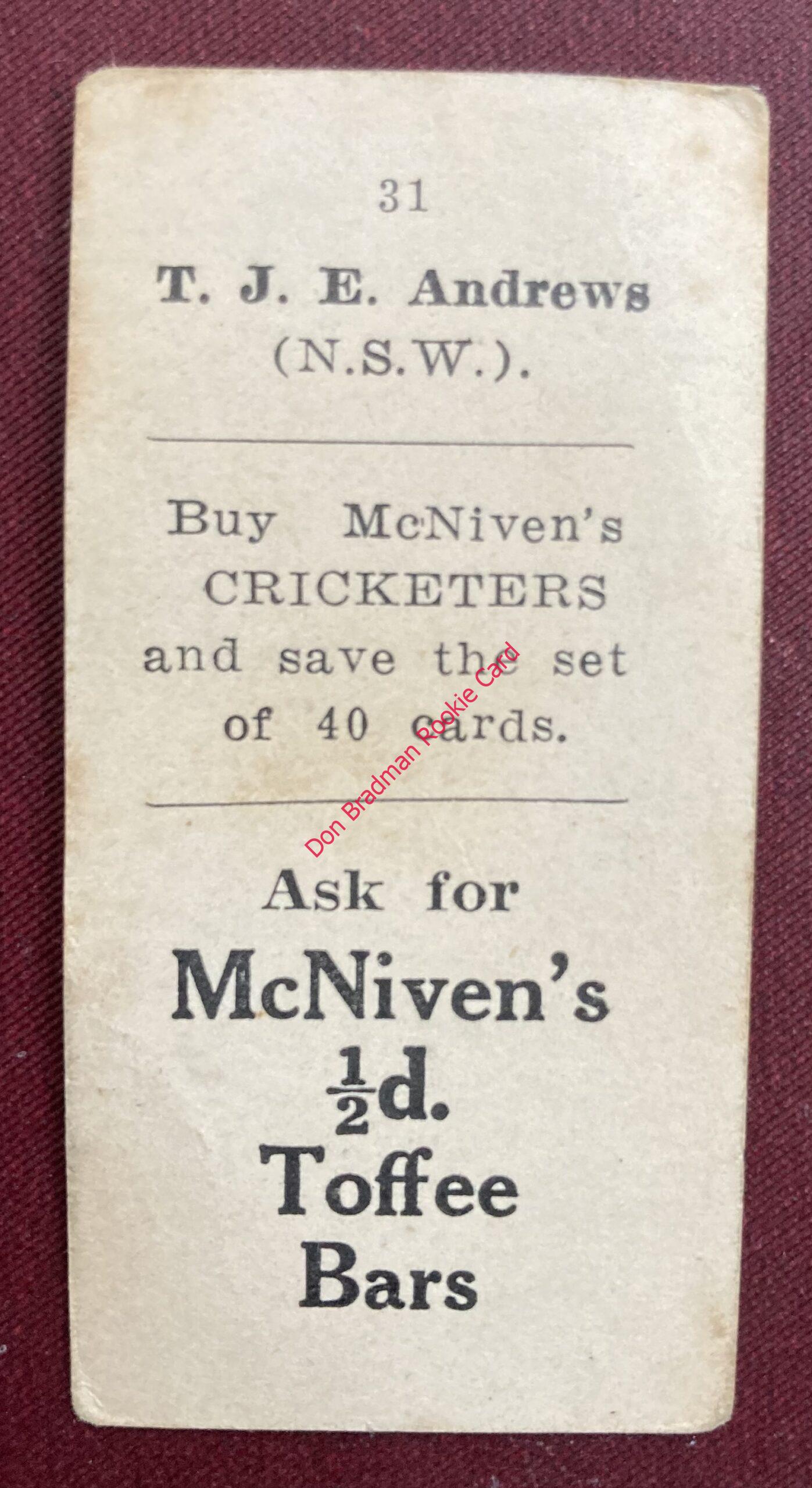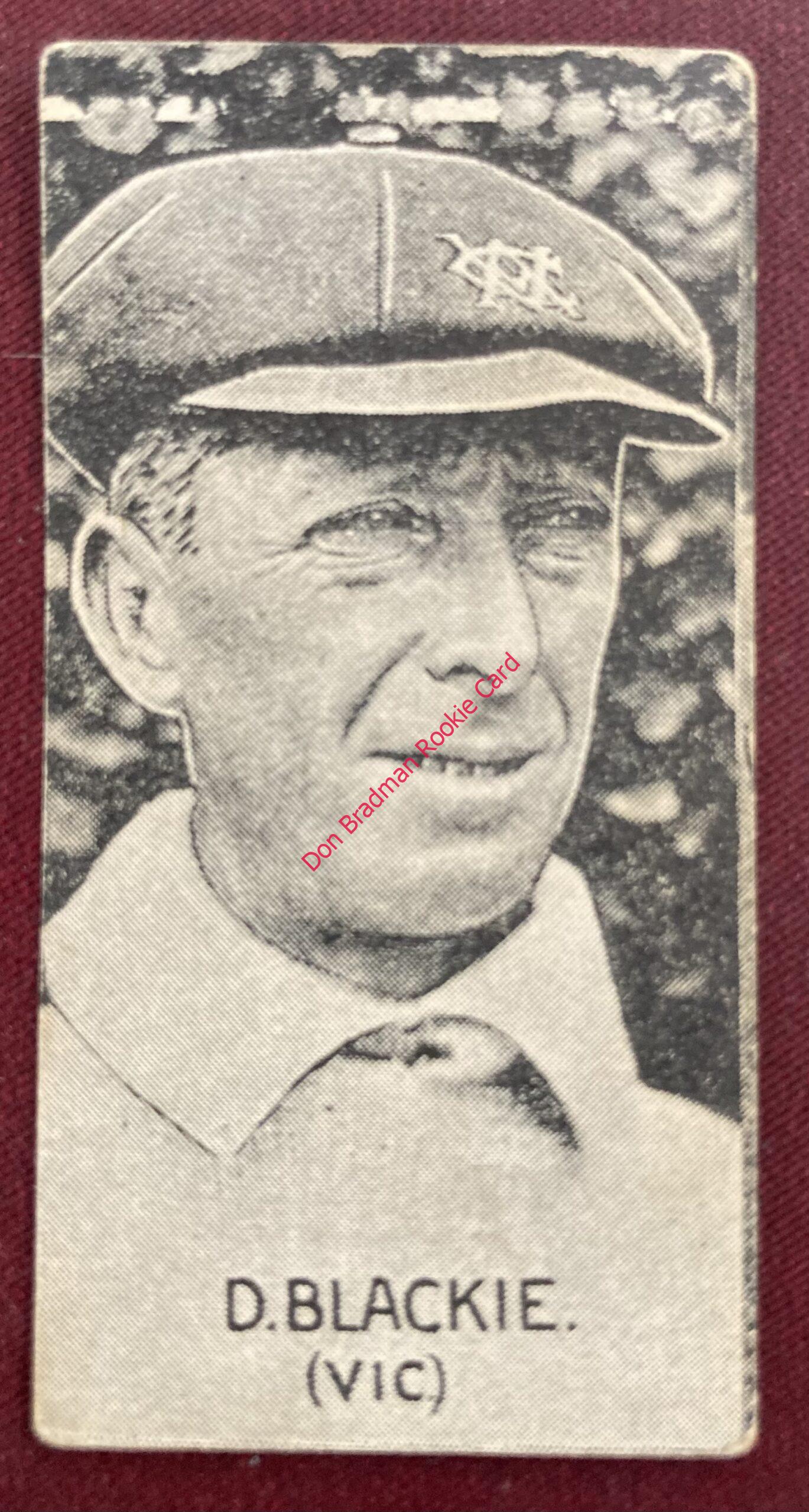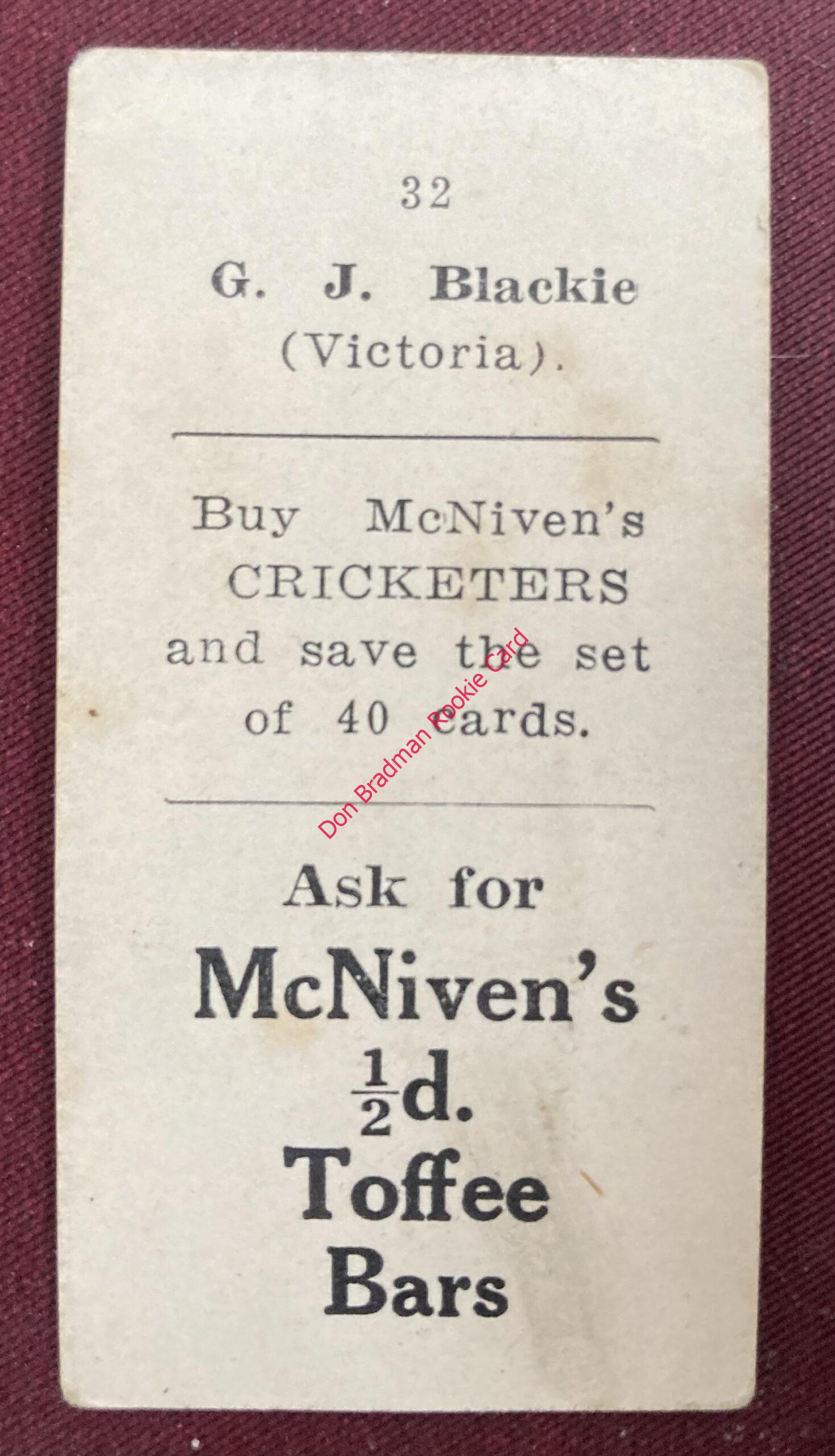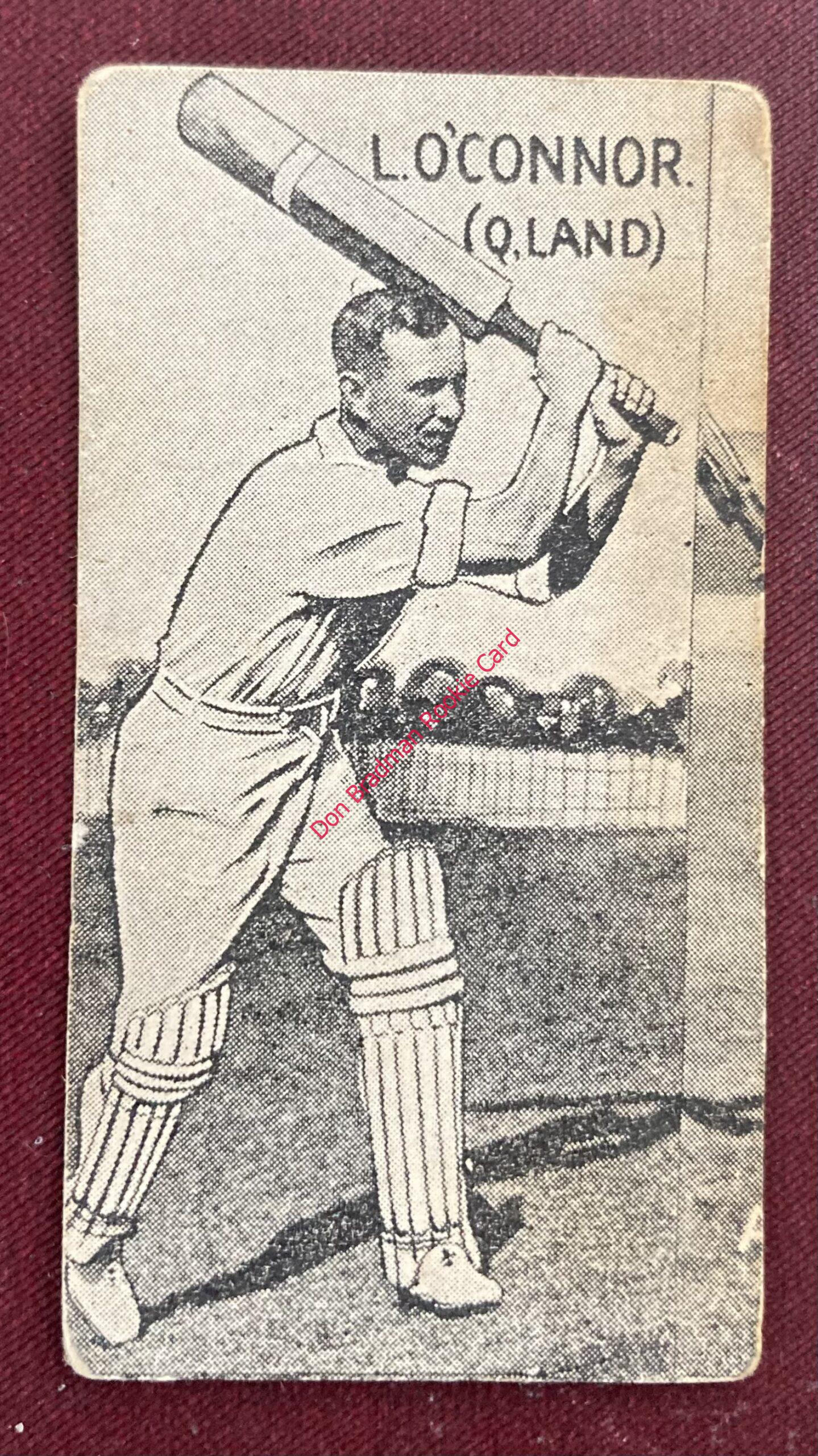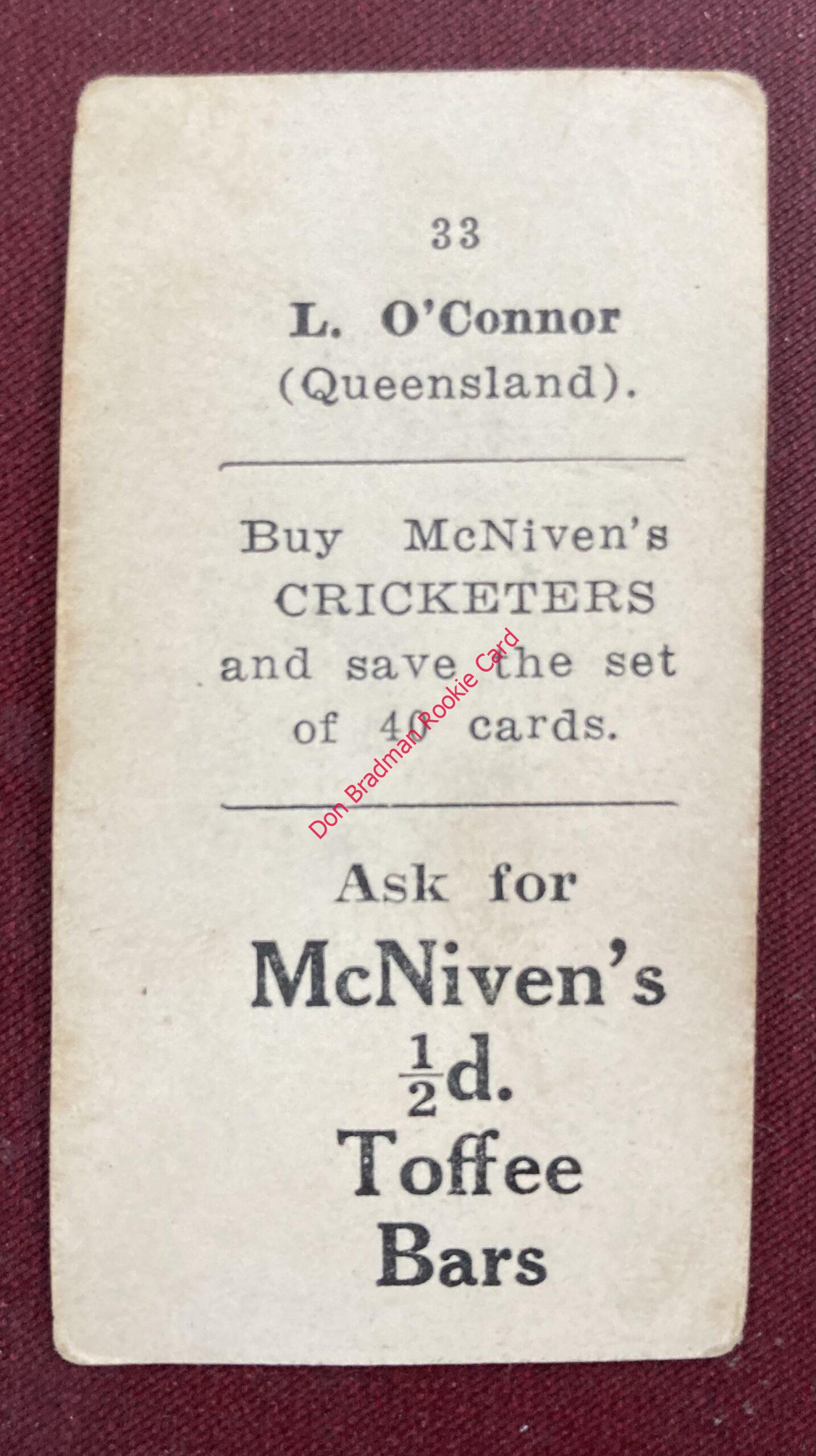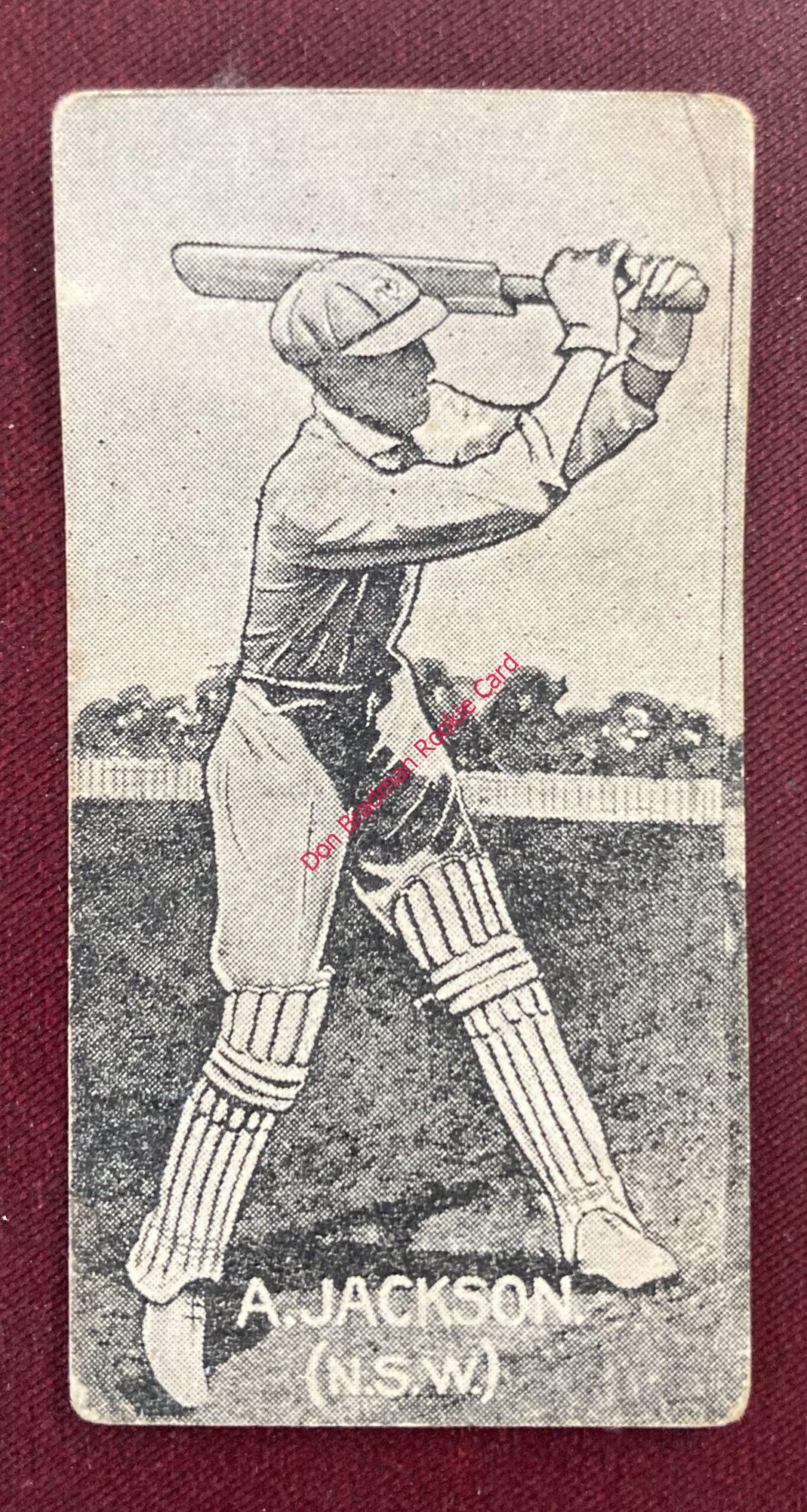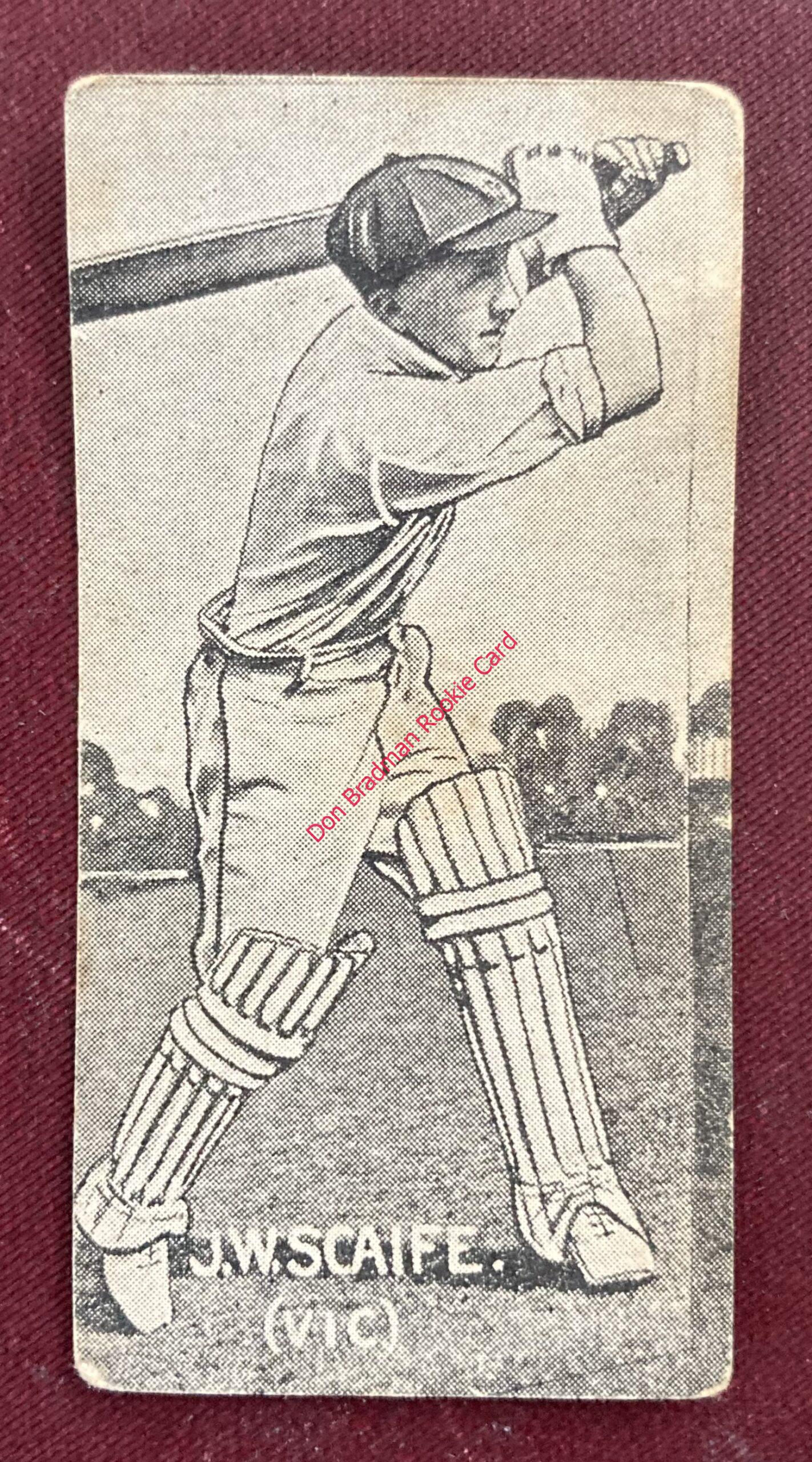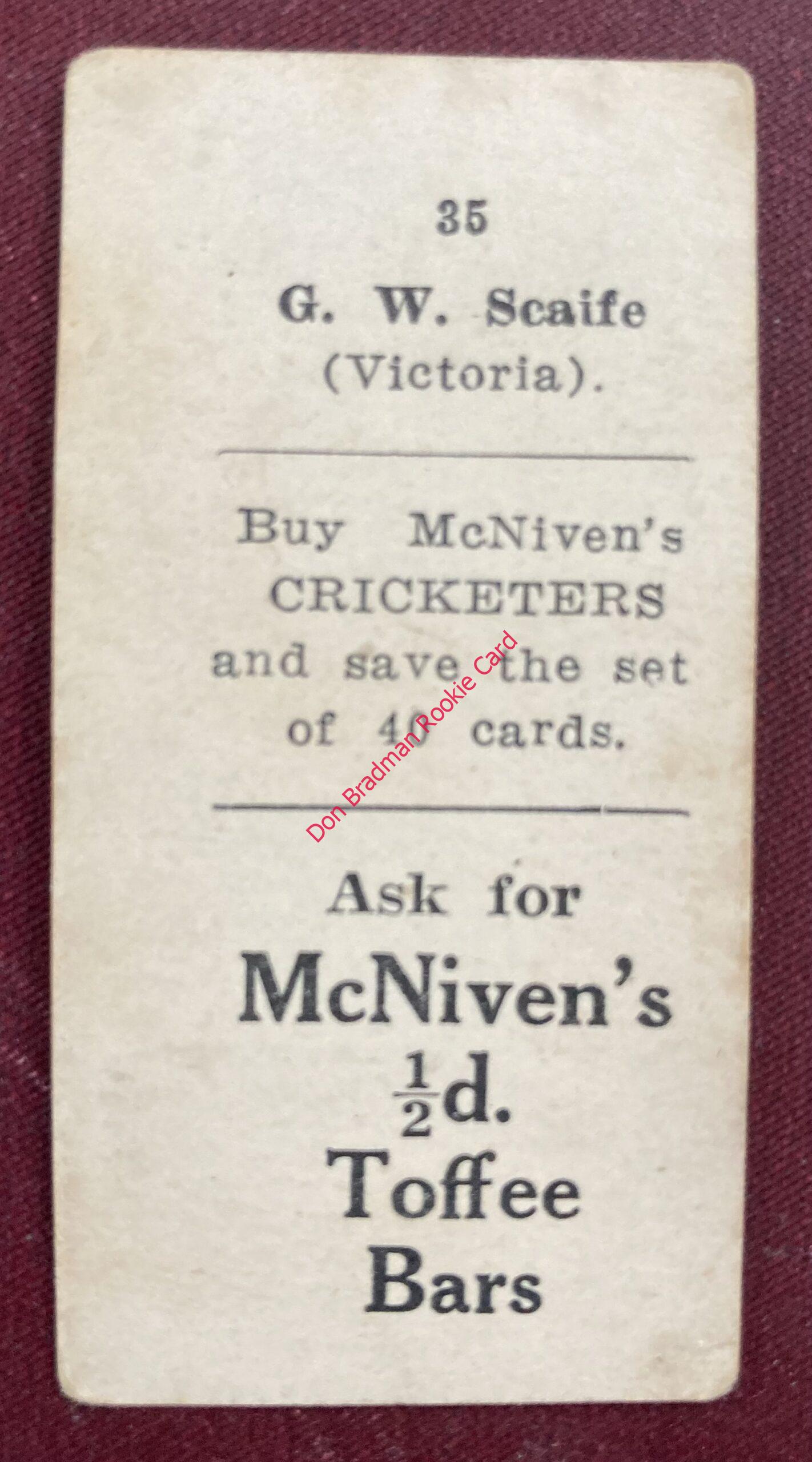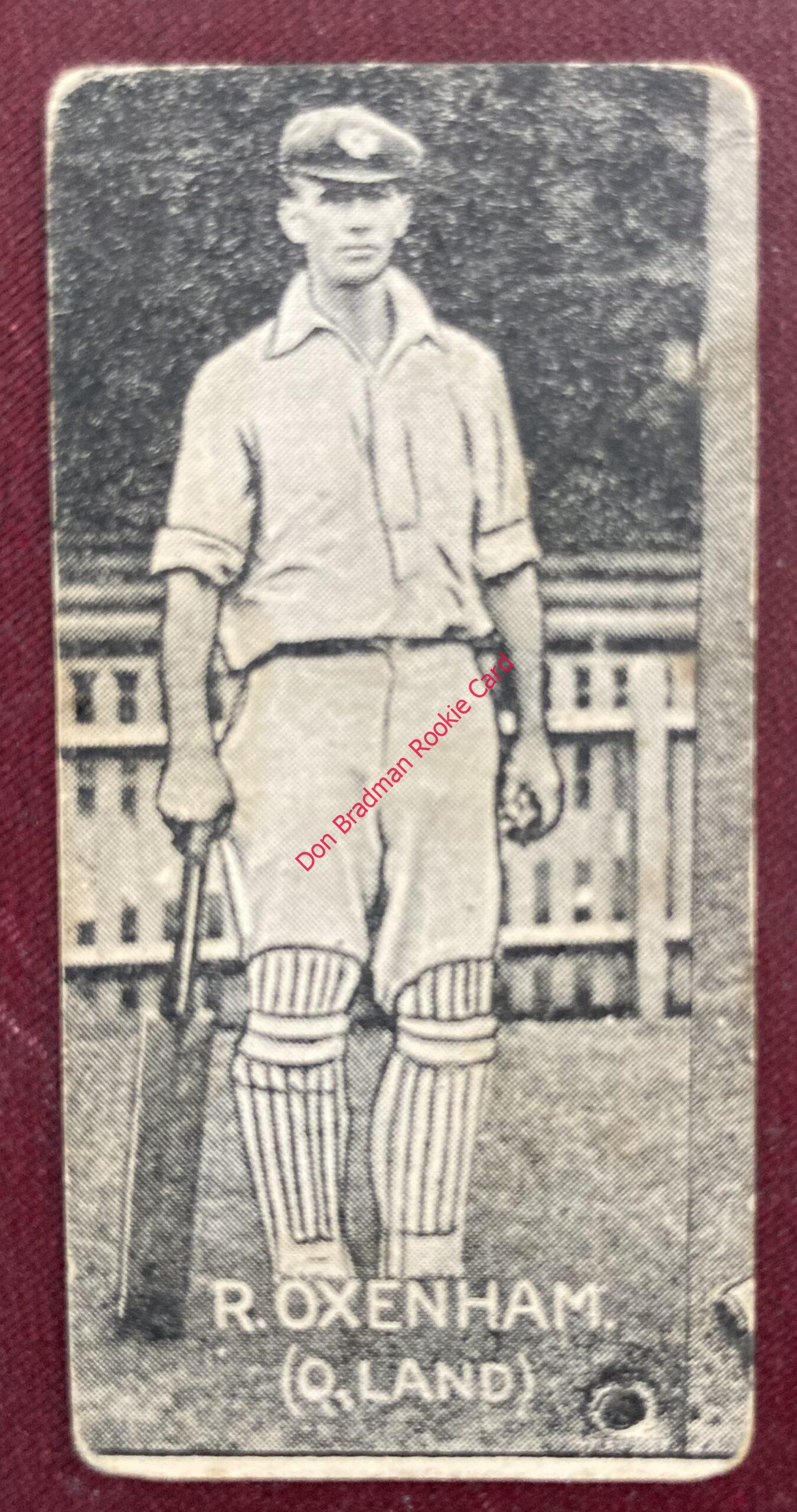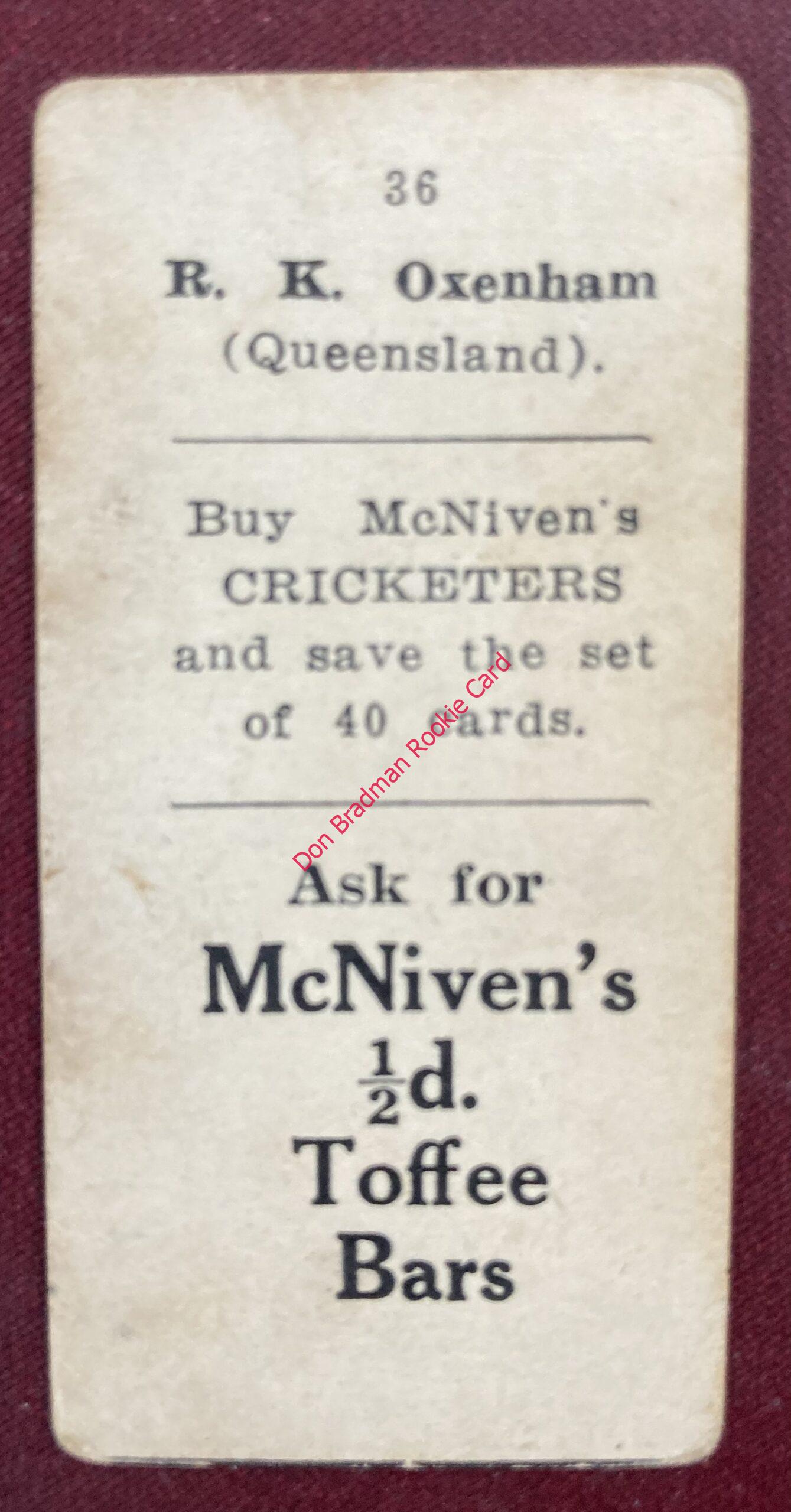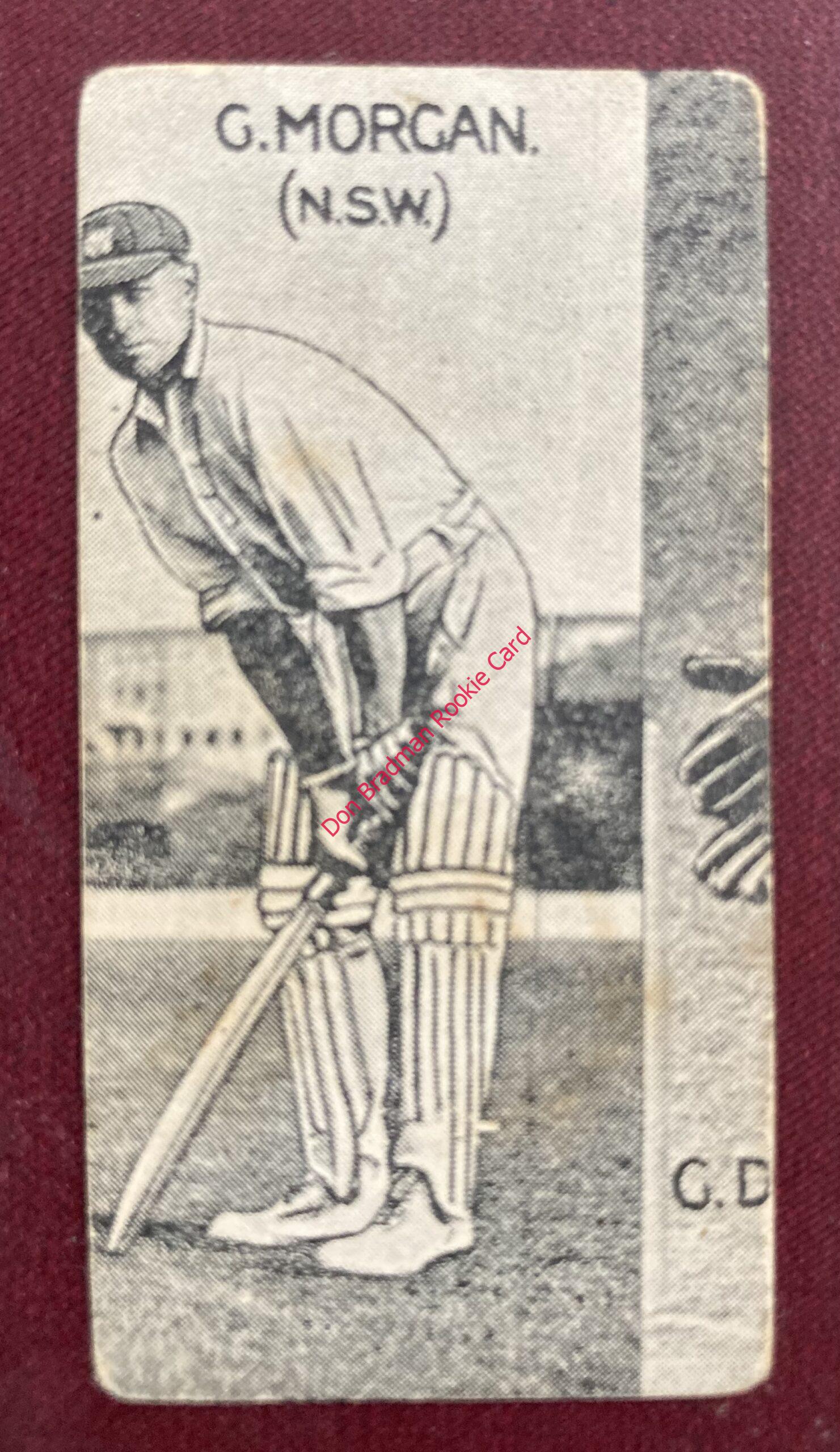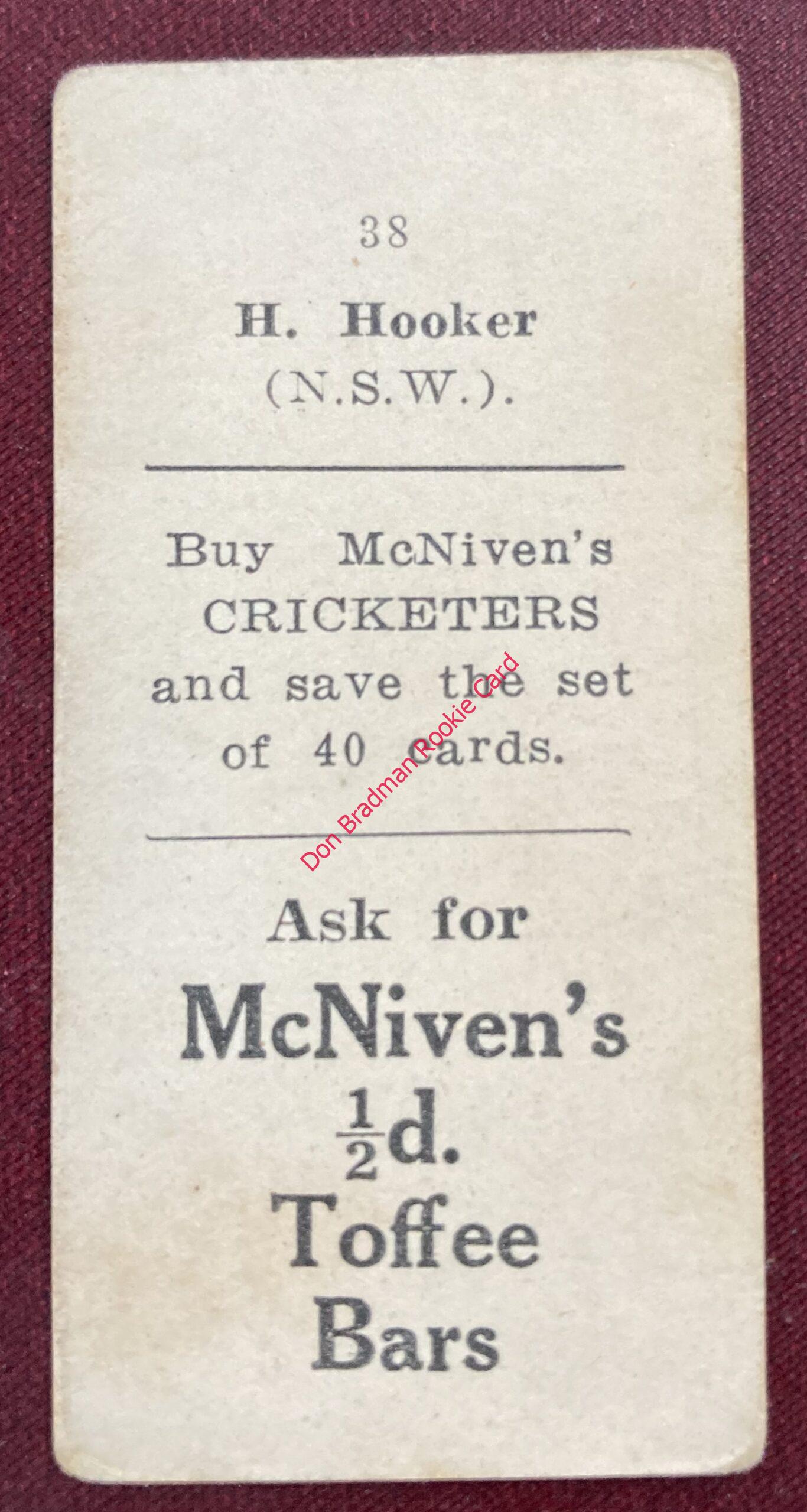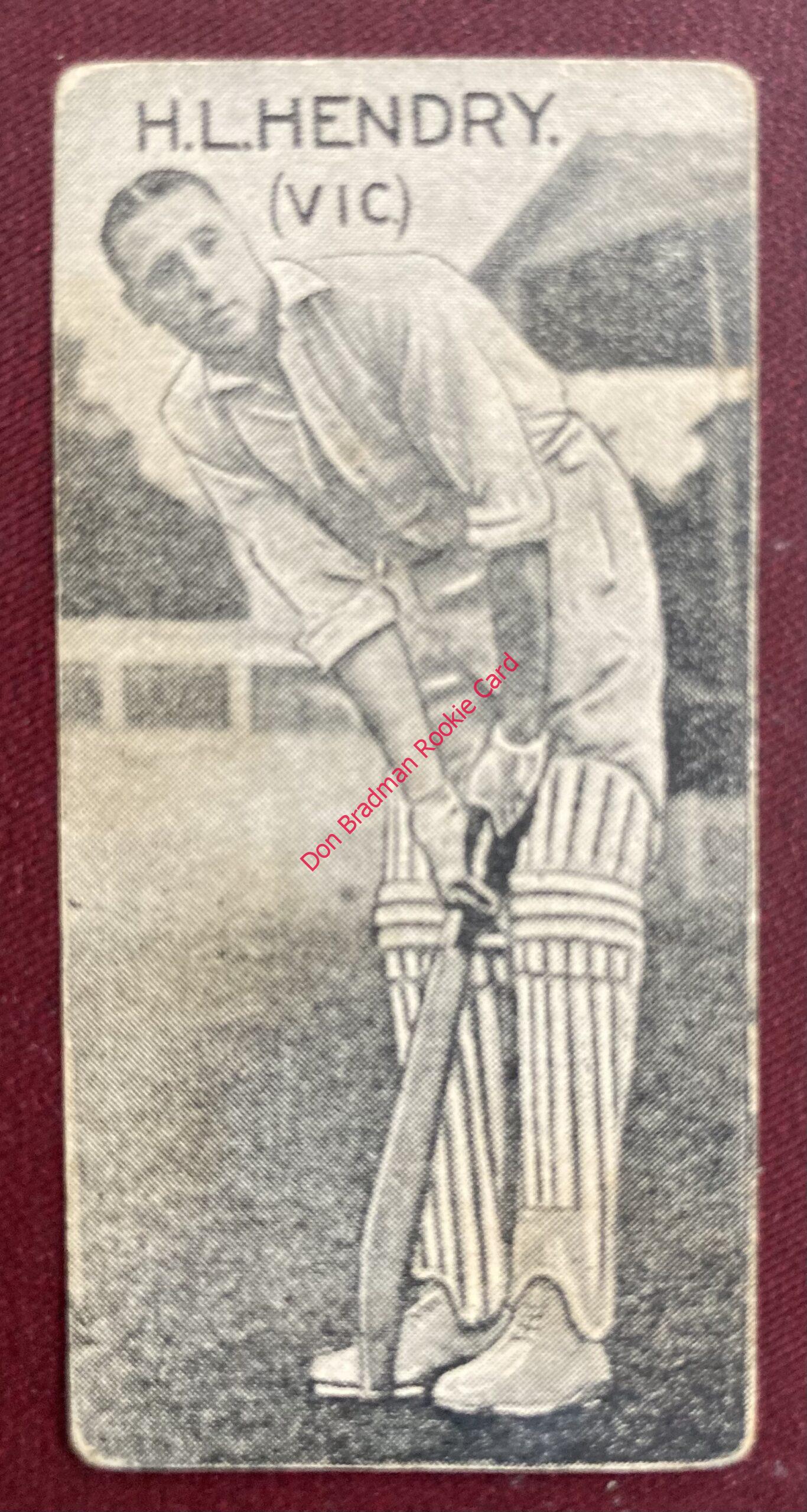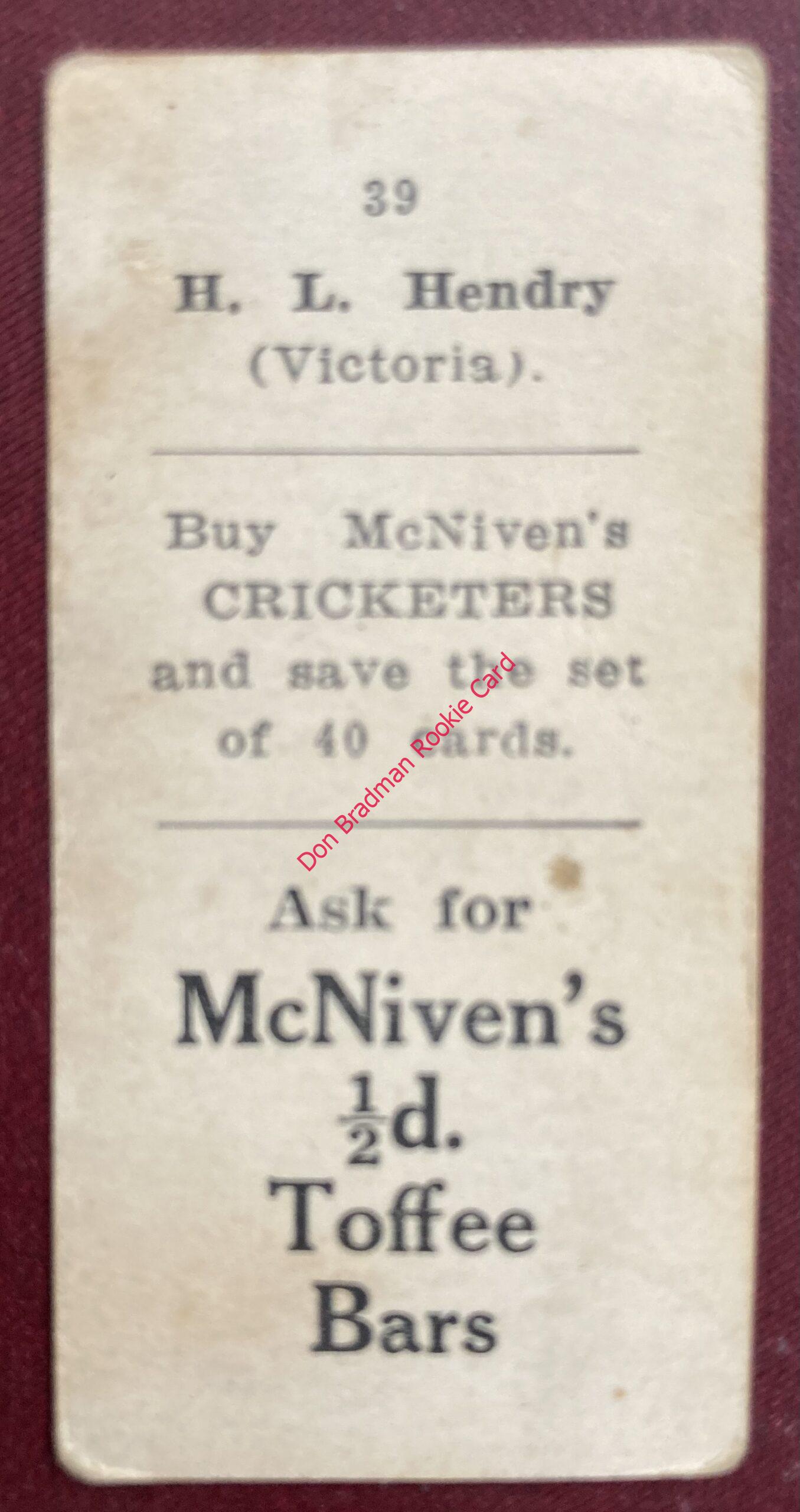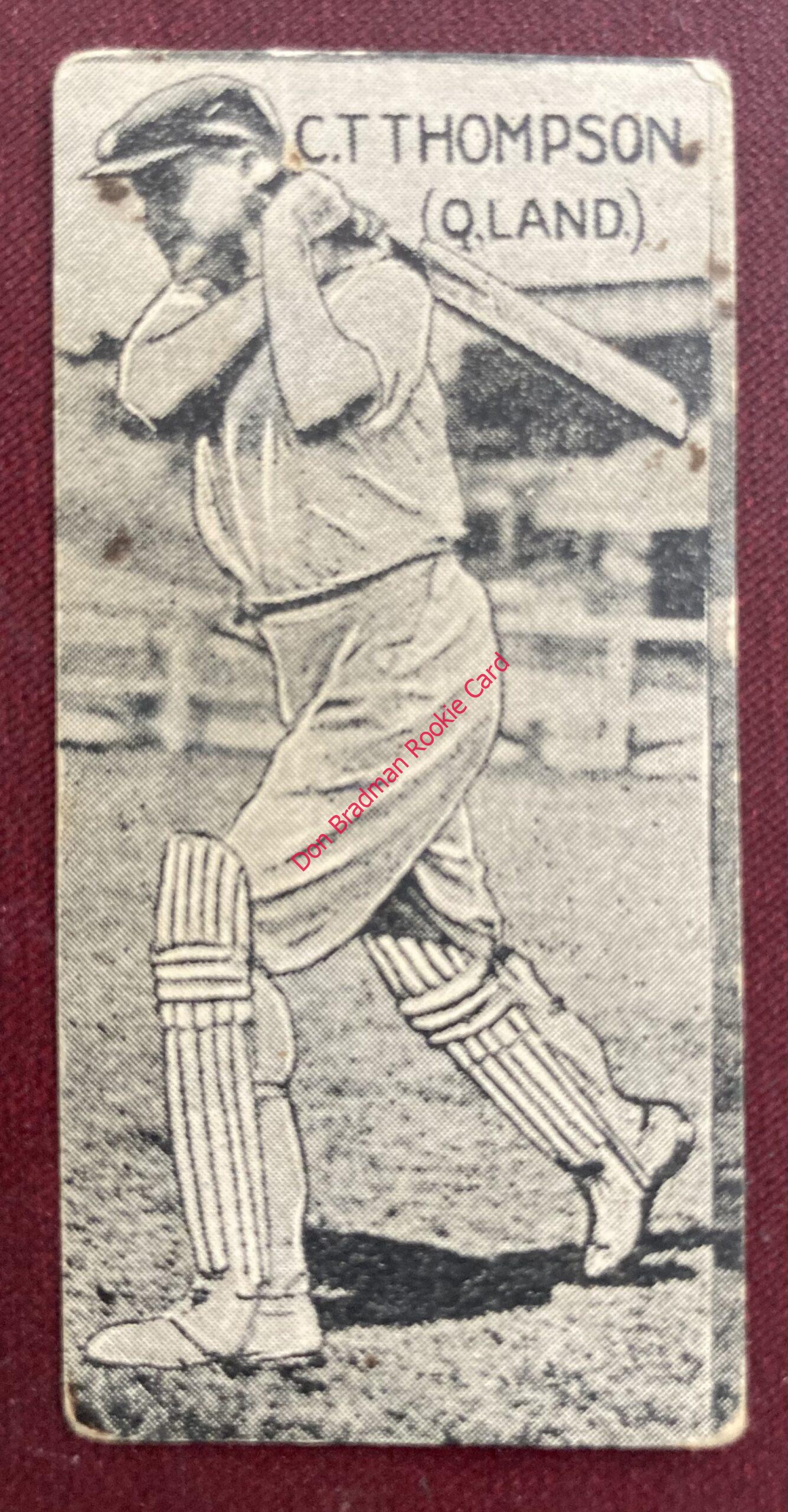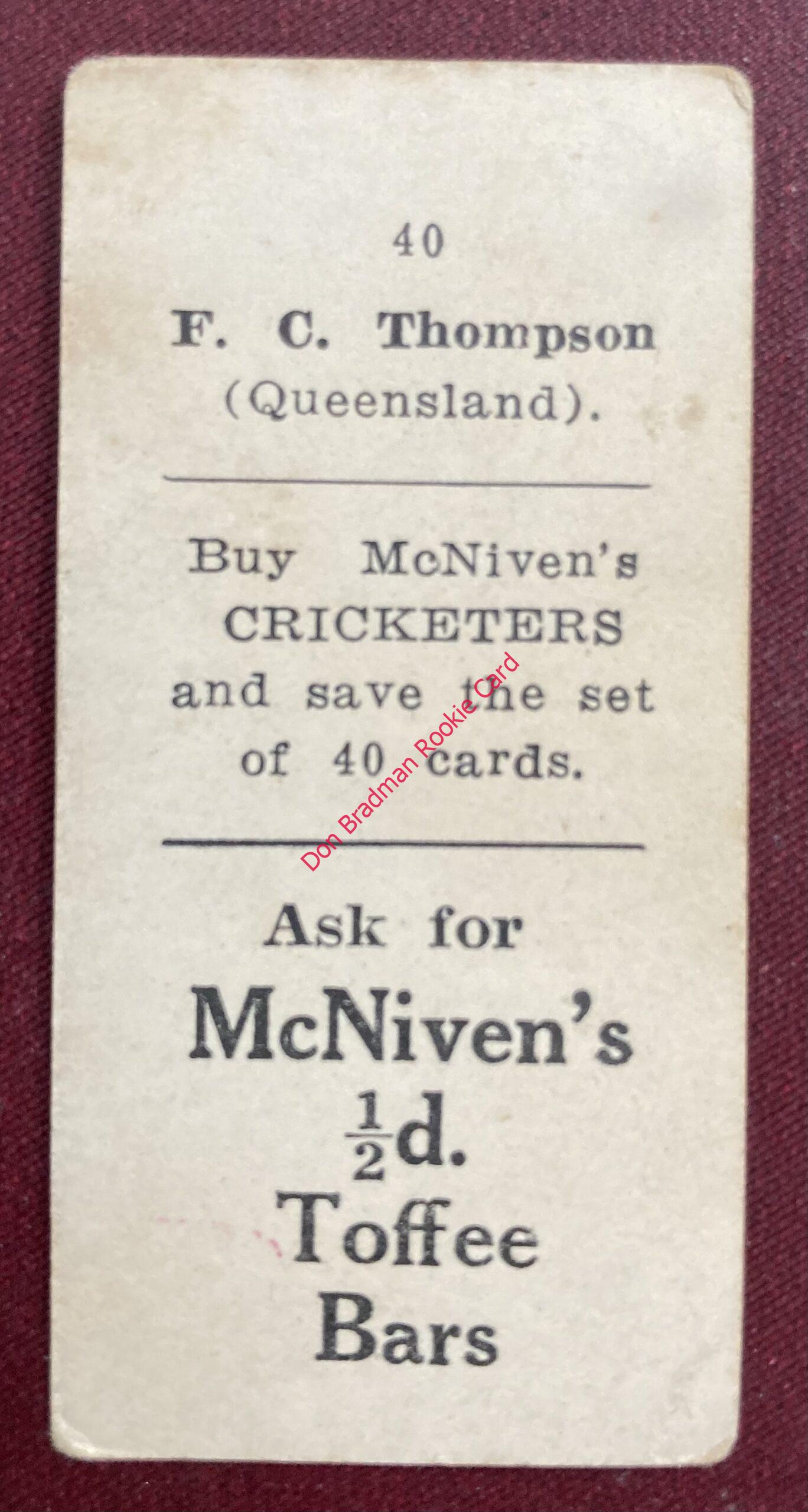This page highlights all the known cards in the McNiven’s Toffees Cricketers card series. As for McNiven’s Toffees, what do we know of the company?? Very very little! Indeed the holy grail of cigarette and trade card catalogues, issued annually by Murray Cards for some decades (the equivalent of the Stanley Gibbons catalogue for stamp collectors) doesn’t even list the McNiven’s Toffees issue, whereas for Bradman’s other rarer rookie card issuer, Hoadley’s Chocolate, they list 12 issues that Hoadley’s produced between 1928 and 1940. It’s very likely to have been the company’s only series of cards ever issued.
The McNiven’s cards themselves are unusual and somewhat reminiscent of a prototype issue, if that’s the right word, in their production. The cards feel like more of a test run, lacking the experienced, mass production professional sophistication shown in cigarette card series such as Bradman’s more common rookie cards, the Ogden’s Australian Test Cricketers 1928-29 series, which would have been produced in the millions of cards, and for which the global population of Bradman rookies, while hard to quantify, is surely well over 2,000 cards to this day, and the W.D. & H.O.Wills 1928-29 Cricket Season card, again a UK cigarette company that would have mass produced the issue, sturdy photocards with their rather lovely art deco backs. Albeit without doubt rarer than the Ogden’s there should be many hundreds of surviving examples of Bradman’s 1928-29 Wills card.
The choice of rounded corners for the McNiven’s cards for a start is strange. The cards we have, all listed below, have some errors and inconsistencies, discussed below on a card by card basis. Even more strange is that every card but one gives the player’s name in the form of initial(s) and surname, every card that is except Don Bradman, who for consistency should be D.G. Bradman but is in fact Don, a happy peculiarity! Thanks again to George from Sydney, we now know that Patsy Hendren’s card also uses his name on reverse rather than his initials. Several cards have been cut inaccurately from the sheet and are displaying a portion of another card, and some of these are identifiable. For example the card of Morgan of New South Wales clearly shows George Duckworth’s gloves, and the card of O’Connor of Queensland seems to have the raised bat of Kippax on its right edge.
Perhaps of more interest for this discussion, before an analysis of the cards themselves, is to document their extremely occasional appearances on Google. I would mention that the prices achieved in these sales are strictly historic and cannot be a guide to future values. Clearly as the market realises their scarcity, and with the general considerable uplift in prices of rare sports cards, the previous achieved values are mainly irrelevant. The cards have evidently never appeared for auction on eBay, or Google would retain a record of those instances. The oldest Google reference is from October 2000, when the only known complete series of cards was sold for AU$2,585 against an estimate of $400-600 at Christie’s Sport in Australia auction, As a complete set of cards there is a Bradman card included for certain. The buyer is obviously unknown, the whereabouts of this lot is unknown, but this is the only other confirmed instance of the existence of another Bradman McNiven’s Toffees rookie card. The screenshots to this sale are as follows.
There are then two instances of multiple cards from the series coming up for auction in decent numbers. In July 2016, a UK based company, Special Auction Services, auctioned 15 cards from the series, including a photograph of 8 cards. That photograph features a card of England captain Percy Chapman that is not among the 32 cards of which we hold the originals. The other 7 players are Maurice Leyland, Jack Hobbs, George Duckworth and Maurice Tate of England, along with Alan Kippax, Hunter Hendry and Bill Ponsford of Australia. However the image doesn’t include Bradman, albeit it’s possible the image of the other 7 cards could have included a Bradman, but if indeed one card was Bradman, it seems unlikely that his card wouldn’t feature in the main photograph that the auctioneer would choose to show.
What we knew from the original 32 cards is that the England players are all in the early part of the series. It’s now known that Chapman’s card, which states he is the “(Capt. English Team)” is card No.1, and the first player card we had before George’s help was Jack Hobbs, who is card No.3. The first Australian player card we knew about was Bill Ponsford, Australian opening batsman, card No.18. So it seemed likely, until the kind intervention of George from Sydney, there were 17 English player cards, of which we have 12. The England tour party totalled 17 selected players, so we could pretty much deduce with an element of certainty that the missing player cards were:
- Percy Chapman (Kent)
- Jack White (Somerset)
- Patsy Hendren (Middlesex)
- Ernest Tyldesley (Lancashire)
- Sam Staples (Nottinghamshire)
However we were wrong! Sam Staples played in the last 3 Test matches against South Africa and was selecteded for the Ashes Tour party, however he fell evidently seriously ill and was either sent home on arrival or perhaps never even boarded the ship’s gangplank. George’s cards confirm that he is not included, that veteran Australian Test player Jack Ryder is included at no.17, so Jack White’s card, of which we still don’t have a copy and thanks to George it remains the only card we don’t have, is by default no.2, which makes sense as he was vice captain.
The missing Australian player cards were much harder to guess at, however they are cards 24, 25 and 26. Jack Ryder (the only confirmed missing card we now know is card 17), Clarrie Grimmett and Jack Gregory all featured in the First Test, Otto Nothling featured in the Second Test, Ted a’Beckett in the Third and Fourth Tests, and Percy Hornibrook played in the Fifth Test, as did Jack Ryder who was recalled, and who, see is confirmed as one of the missing Australians. It was hard to imagine that Grimmett was not among the three cards, and indeed George’s intervention confirmed that in addition to Ryder the other missing players are Jack Gregory, Otto Nothling and Clarrie Grimmett.
The second auction occurred 9 years earlier in March 2007 at the Australian auction house Leski & Co of Melbourne. They auctioned 12 cards of the 40 which they described as an “extremely rare set”, and noted in addition to a photograph of Percy Chapman’s card that the lot was “including A.P.F. Chapman, J.C. White & W. Oldfield”. So it seems absolutely unlikely that Bradman was amongst the other 9 cards or for sure he would have been mentioned. It seems the same auction is featured on the Carter’s website, again using the photograph of Percy Chapman’s card, noting that the lot is “including A.P.F. Chapman, J. Ryder and A. Jackson”. Again, Bradman would have been mentioned if he was one of the 12 cards going under the hammer.
The remaining instances of McNiven’s Toffees Cricketers cards coming up for sale and being recorded by Google are extremely rare, totalling 10 cards in 6 sales, in addition to the 27 cards in the two auction lots above, and are as follows:
- The UK card dealing website Cardhawk had a card of George Duckworth listed, now “out of stock”
- The leading UK based sports cards auction house, Nottingham based Tim Davidson Auctions Limited listed two cards for sale in July 2016, of Australia’s Bill Woodfull and Bertie Oldfield
- In April 2017 Leski Auctions auctioned 4 cards, Phil Mead of England, Hunter Hendry of Australia, and two cards of England’s George Duckworth
- In an undated auction of around 600 (rare?) cricket cards, Carter’s Auctions of Australia listed a single unnamed McNiven’s card
- Two UK auction sales at Tim Davidson’s in May and September 2021, cards of Harold Larwood and George Duckworth (again!)
The simple maths of the card series suggests that with only 37 cards ever listed on Google during the last 20 years, in only 8 different incidences, the McNiven’s Toffees Cricketers series is one of the rarest card series across the whole spectrum of sports cards issuance. To illustrate, with a set of 40 cards being sold at Christie’s in 2000, if you were to imagine 20 complete series of cards, ie 800 cards in total, and with 40 cards sold at Christie’s excluded, a global population of 760 cards, would it be fair to expect a larger number to change hands than a mere 37 cards in 8 incidences over a 20 year period?? Surely more would have come out over that timespan. It suggests to me that, barring the inevitable population of cards buried deep in attics, similar to the owner’s 32 cards in a tobacco tin, that the population among sports card collectors is extremely small. Far smaller than 800 cards.
And now to the actual cards. Again many thanks to George from Sydney, his cards are against a black rather than red background. The first 16 cards cover the English tourists, of these only White is missing. From number 17 onwards all are Australians. The first card is English captain Percy Chapman and thereafter the remaining England tourists, except for the unfortunate Sam Staples. In addition there are 23 Australian cards, the Australian players shown are of course a mixture of the expected Test regulars and hopefuls, and leading Sheffield Shield players, several of whom never made the Australian Test team at any time in their careers but were probably under consideration at the time for their performances. Taking the cards in number order, within both team sections there is seemingly some kind of imperfect scorecard order ie first primary batsmen, openers then middle order, before wicket keepers and bowlers with some lesser batsmen mixed in:
1. Percy Chapman, Kent & England captain
Amateur Percy Chapman was a flamboyant English cricketer who captained England between 1926 and 1931 and played first class cricket for Cambridge University and Kent between 1920 and 1938. A left-handed batsman, he played 26 Test matches for England between 1924 and 1931, captaining the side in 17 of those matches. Chapman was appointed captain for the final, decisive Test of the 1926 series against Australia; under his captaincy, England defeated Australia to win The Ashes for the first time since 1912. Never a reliable batsman, Chapman nevertheless had a respectable batting record with a Test average of 28.90 and a highest score of 121. He could score runs very quickly and was popular with spectators. As a fielder, contemporaries rated him extremely highly. Although opinions were divided on his tactical ability as a captain, most critics accepted he was an inspirational leaders and in the 1928-29 Ashes series he led England to their world record margin of victory in the first Test at Brisbane. According to Douglas Jardine’s biographer, Christopher Douglas, “[Chapman] hardly put a foot wrong during the tour and, even though he gave Australia their biggest hiding to date, he was and probably remains … one of the most popular English captains to tour Australia.”
2. Jack White, Somerset & England vice captain
Vice-captain on tour to Percy Chapman, Jack White played 15 Test matches for England between 1921 and 1931, captaining his country on 4 occasions. A slow left-arm bowler who used accuracy and variation of pace rather than spin to take wickets, he first appeared in 1909 and was a regular player for Somerset from 1913 to 1937, and very much their star player for much of that period, taking 100 wickets a season 14 times. White was a Test selector in 1929 and 1930 and was president of the Somerset club at the time of his death in 1961. For the tour of Australia in 1928-29, he was vice-captain to Percy Chapman and the main bowler in a series that turned into a successful war of attrition. At Melbourne, he bowled 113 overs and five balls, and at Adelaide he surpassed that, bowling 124 overs and five balls, taking 13 wickets in the match for 256 runs, as England won by just 12 runs. In the final Test of the series, he stood in as captain for the injured Chapman, but lost the Test and so ended England’s then-record-equalling run of seven consecutive Test victories
3. Jack Hobbs, Surrey & England
Sir John Berry "Jack" Hobbs was an English cricketer who played for Surrey from 1905 to 1934 and for England in 61 Test matches between 1908 and 1930. Known as "The Master", he is regarded by critics as one of the greatest batsmen in the history of cricket. He is the leading run-scorer and century-maker in first class cricket, with 61,760 runs and 199 centuries. A right-handed batsman and an occasional right-arm medium pace bowler, Hobbs also excelled as a fielder, particularly in the position of cover point. Hobbs is fifth in the all time list of England cricketers' Test match batting averages, averaging 56.94 runs per innings, with his contemporaries Herbert Sutcliffe and Wally Hammond both above him.
4. Herbert Sutcliffe, Yorkshire & England
Herbert Sutcliffe represented Yorkshire and England as an opening batsman. Apart from one match in 1945, his first class career spanned the period between the two world wars. His first class debut was delayed by the First World War until 1919 and his career was effectively terminated in August 1939 when he was called up for military service in the imminent Second World War. He was the first cricketer to score 16 centuries in Test match cricket. A right-handed batsman, Sutcliffe was noted for his concentration and determination, qualities which made him invaluable to his teams in adverse batting conditions; and he is remembered as one of the game's finest "bad wicket batsmen". His fame rests mainly in the great opening partnership he formed with Jack Hobbs for England between 1924 and 1930. He also formed notable opening partnerships at Yorkshire with Percy Holmes and, in his last few seasons, the young Len Hutton. During Sutcliffe's career, Yorkshire won the County Championship 12 times. Sutcliffe played in 54 Test matches for England and on three occasions he toured Australia, where he enjoyed outstanding success. His last tour in 1932–33 included the controversial "Bodyline" series, in which Sutcliffe is perceived to have been one of Douglas Jardine's main supporters. Although close friends have stated that Sutcliffe did not approve of bodyline, he always acted out of fierce loyalty to his team captain and was committed to his team's cause. In statistical terms, Sutcliffe was one of the most successful Test batsmen ever; his completed career batting average was 60.73 which is the highest by any English batsman and the seventh-highest worldwide (of Test batsmen with 20 completed innings) behind only Don Bradman, Marcus Labuschagne, Steve Smith, Adam Voges, Graeme Pollock and George Headley.
5. Patsy Hendren, Middlesex & England
The only other card in the series besides Bradman to use the player's name rather than initials on reverse.
A legendary cricketer who was also a very successful footballer and who played football in an unofficial Victory international for England in 1919, being the 13th double international per se, Patsy Hendren was one of the most prolific batsmen of the inter-war period, averaging 47.63 in his 51 Test matches between 1920 and 1935, and 50.80 in all his first-class matches between 1907 and 1938. He has the third highest first-class run aggregate of 57,611 runs (after Jack Hobbs and Frank Woolley), and his total of 170 centuries ranks second only to Hobbs.
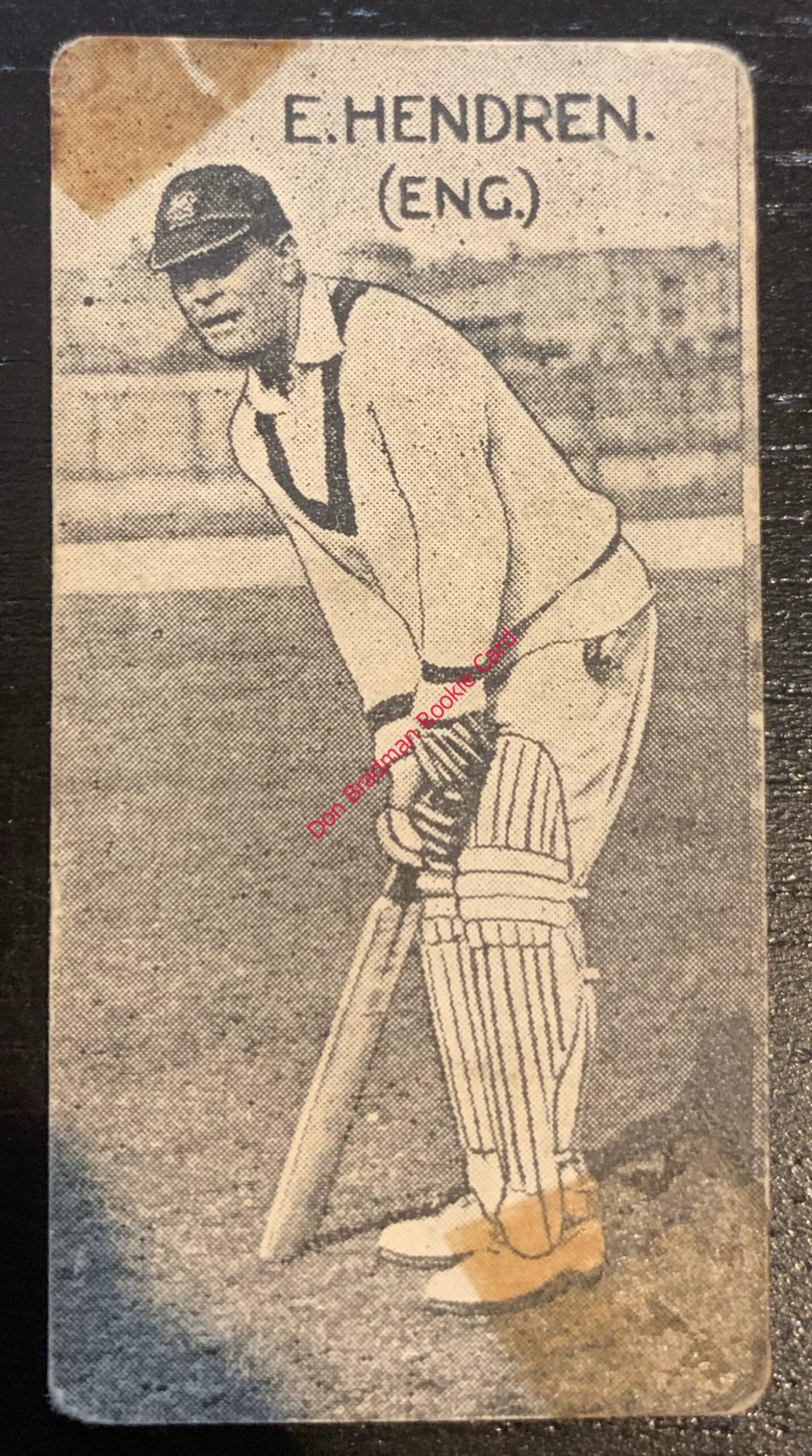
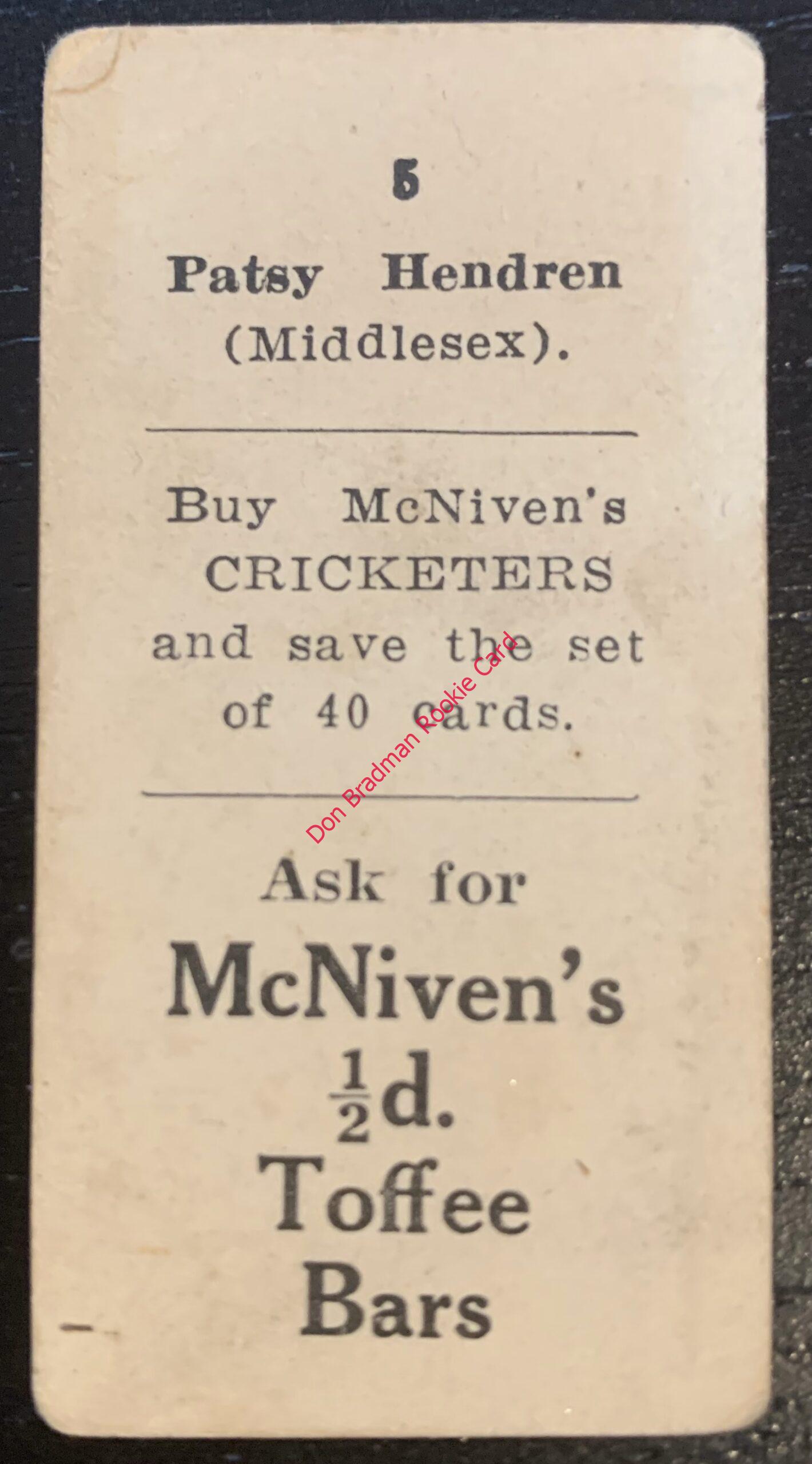
6. Maurice Tate, Sussex & England
The son of former Sussex and England off-spinner Fred Tate, Maurice Tate, nicknamed "Chubby", was England's finest all-rounder during the 1920's, a hard hitting batsman and fast-medium bowler who achieved the exceptional double of 1,000 runs and 200 wickets in a season three years running (1923, 1924 and 1925). Tate made his Test debut for England against South Africa in 1924 and scored his only Test century, also against South Africa, in 1929. In 39 Tests for England he took 5 wickets in an innings on 7 occasions and averaged 26 with the ball and 25 with the bat. He was also a tourist in the 1932-33 "Bodyline" Tour to Australia but didn't play in the Test matches.
7. Wally Hammond, Gloucestershire & England
Another of England's greatest ever Test cricketers, Wally Hammond scored 7,249 runs and took 83 wickets in a Test career spanning 85 matches from 1927 to 1947, and was made captain of England in 1938. With a highest score of 336 not out and 22 Test match centuries, Hammond averaged an exceptional 58.45 with the bat and his career aggregate of runs was the highest in Test cricket until surpassed by Colin Cowdrey in 1970.
8. Phil Mead, Hampshire & England
A left handed batsman, Phil Mead was a veteran cricketer by the time of the 1928-29 Tour and played his last Test match for England in the opening match of the Tour. Having made his County debut in 1905 he first played for England in 1910 and played 17 Test matches, averaging 49.37 in Test cricket with 4 centuries and a highest score of 182 not out. He also once played football for Southampton in 1907.
9. A.P. "Tich" Freeman, Kent & England
Alfred Percy, better known by his nickname "Tich" due to his diminutive stature at only 5 foot 2 inches tall, Freeman was a right arm leg break bowler and remains he only man to take 300 wickets in an English season and holds many other records. Freeman is the second most prolific wicket-taker in first-class cricket history. He made his Test match debut for England against Australia in December 1924 and played his final Test of a dozen against South Africa in August 1929, taking 66 Test wickets at nearly 26 a piece.
10. Harold Larwood, Nottonghamshire & England
Right arm fast bowler Harold Larwood combined unusual speed with great accuracy, he was considered by many commentators to be the finest bowler of his generation, and holds legendary status in cricket for his bowling on the 1932-33 "Bodyline" tour to Australia. He made his Test debut against Australia in 1926, in only his second season in first class cricket and played 21 Test matches in all through to 1933, when he suffered a foot injury in the final Test of the series, but continued his county career with considerable success for several more seasons.
11. Les Ames, Kent & England
One of England's greatest wicket keepers of all time and a fine batsman, Les Ames is the only wicket-keeper-batsman to score a hundred first class centuries. He made his County debut in July 1926 and his Test match debut in the Fifth Test against South Africa at The Oval in August 1929, going on to play 47 Tests for England through to March 1939, scoring 8 Test centuries with an excellent batting average of 40.56 and holds a number of cricketing records. Ames also played League football for Clapton Orient and Gillingham.
12. George Duckworth, Lancashire & England
The reserve wicket keeper on the 1928-29 Tour, George Duckworth played his first game for Lancashire in 1923 and his last in 1938. 1928 was his best season, taking 77 catches and 30 stumpings, and this earned him the accolade of being one of the Wisden Cricketers of the Year in 1929. He played 24 Test matches for England between his debut against South Africa in July 1924 and his final Test against India in August 1936, but as a wicket-keeper he was in direct competition in his later years with Les Ames, who was a much better batsman. Duckworth averaged 14.62 at Test level with a high score of 39 not out.
13. Douglas Jardine, Surrey & England
A poorly cut card showing Ron Oxenham's card on the right edge. A right-handed batsman, Douglas Jardine is best known for captaining the English team during the 1932-33 "Bodyline" tour of Australia. A controversial figure among cricketers, he was well known for his dislike of Australian players and crowds and was unpopular in Australia, particularly for what was perceived to be an arrogant manner. He was also famous in cricket circles for wearing a multi-coloured Harlequin cap, and after playing for Oxford University and Surrey throughout the 1920's, made his England Test match debut against West Indies in June 1928. In 22 Test matches he captained in 15 and of those 9 were won, his final Test coming against India in February 1934. He managed an impressive batting average at Test level of 48.00 with 10 fifties and a single Test century of 127 against West Indies in 1933.
14. Maurice Leyland, Yorkshire & England
Again a poorly cut card, appearing to show part of George Geary's card to the right side. Batsman Maurice Leyland made his County debut for Yorkshire in 1920 and his Test match debut against West Indies in August 1928. He played 41 Tests for England through to August 1938, scoring 9 centuries at an impressive average of 46.06, with a highest score of 187 in his final Test match against Australia. EW Swanton concluded his obituary of Leyland: "No more courageous or determined cricketer ever buckled on pads for England."
15. George Geary, Leicestershire & England
A right handed medium-fast bowler and a useful lower order batsman, making two Test half centuries, George Geary was able to swing the new ball very effectively but relied for most of his success on his amazing persistence and ability to bowl with slight yet well-disguised variations of pace and cut. He made his County debut for Leicestershire in 1912 and his Test match debut for England against South Africa in July 1924. He played 14 Tests taking 66 wickets at 29.41, his final Test coming against Australia in June 1934.
16. Ernest Tyldesley, Lancashire & England
The younger brother of legendary Lancashire and England batsman Johnny Tyldesley, Ernest remains Lancashire's most prolific run-getter of all time, and is one of only a few batsmen to have scored 100 centuries in the first-class game. Tyldesley played 14 Tests for England between May 1921 and March 1929, scoring 3 Test centuries, however so strong was the English batting during the 1920's that he was never assured a Test place. Upon his final appearance for England on the Ashes tour at Melbourne in March 1929, Tyldesley's batting average of 55.00 was the highest of any player, at that time, to have completed a career of 20 innings or more.
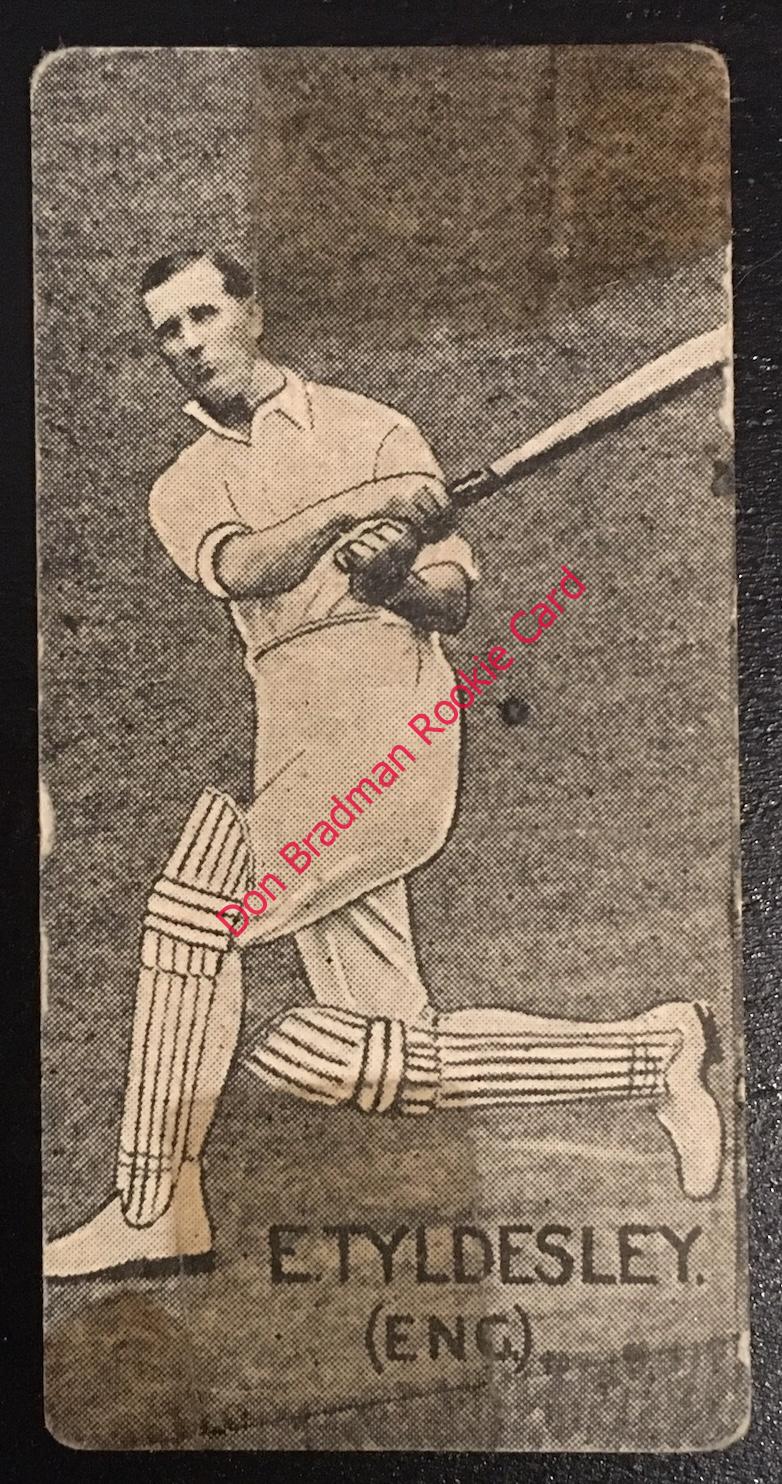
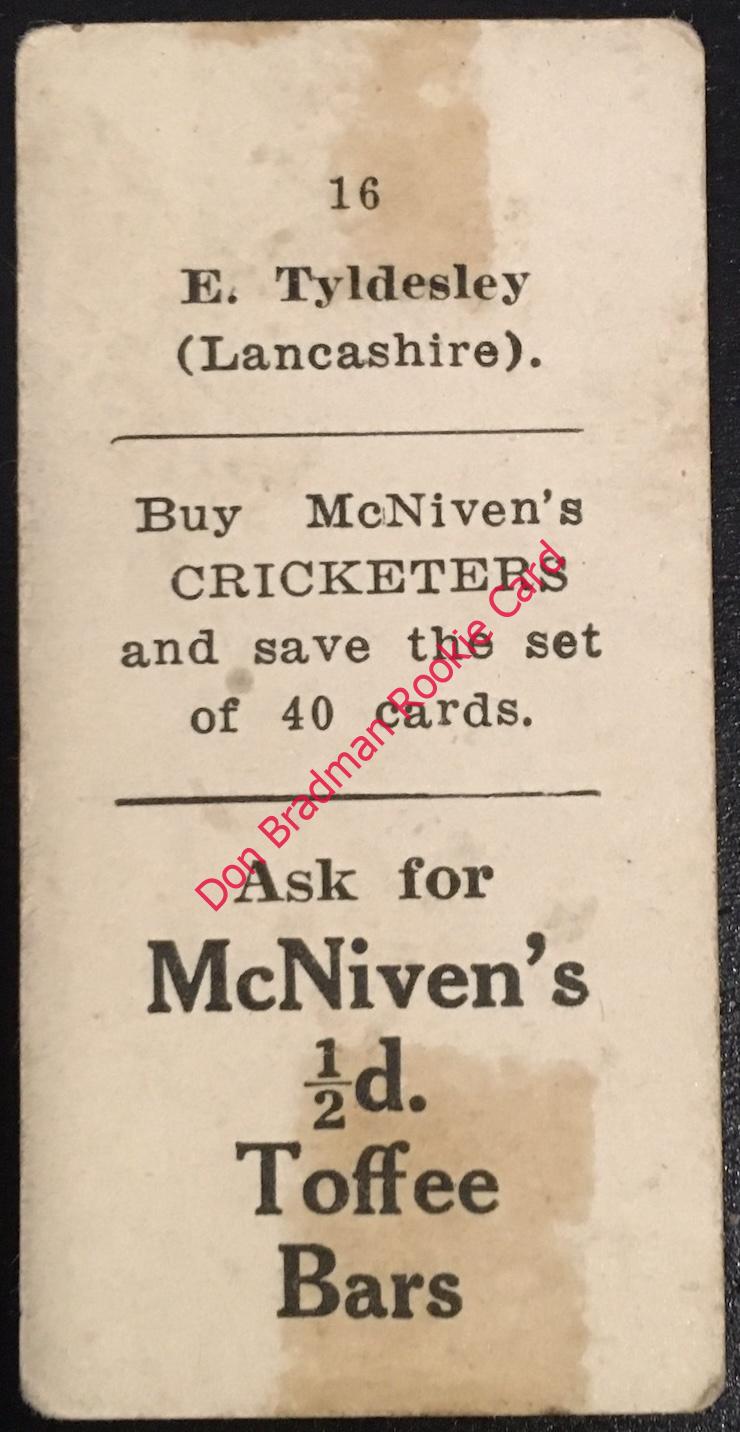
17. Jack Ryder, Victoria & Australia
Australia's Test captain prior to Bill Woodfull and a veteran of 20 Test matches between December 1920 and March 1929, all-rounder Jack Ryder averaged 51.62 in Test cricket with 3 Test centuries and a highest score of 201 not out against England, made in six and half hours at Adelaide in 1924-25. Ryder was also the first Australian to complete a Test career of more than 20 innings with a batting average over 50.00. As a right-arm medium pace bowler he took 237 first-class wickets but only 17 of these were in Test matches.
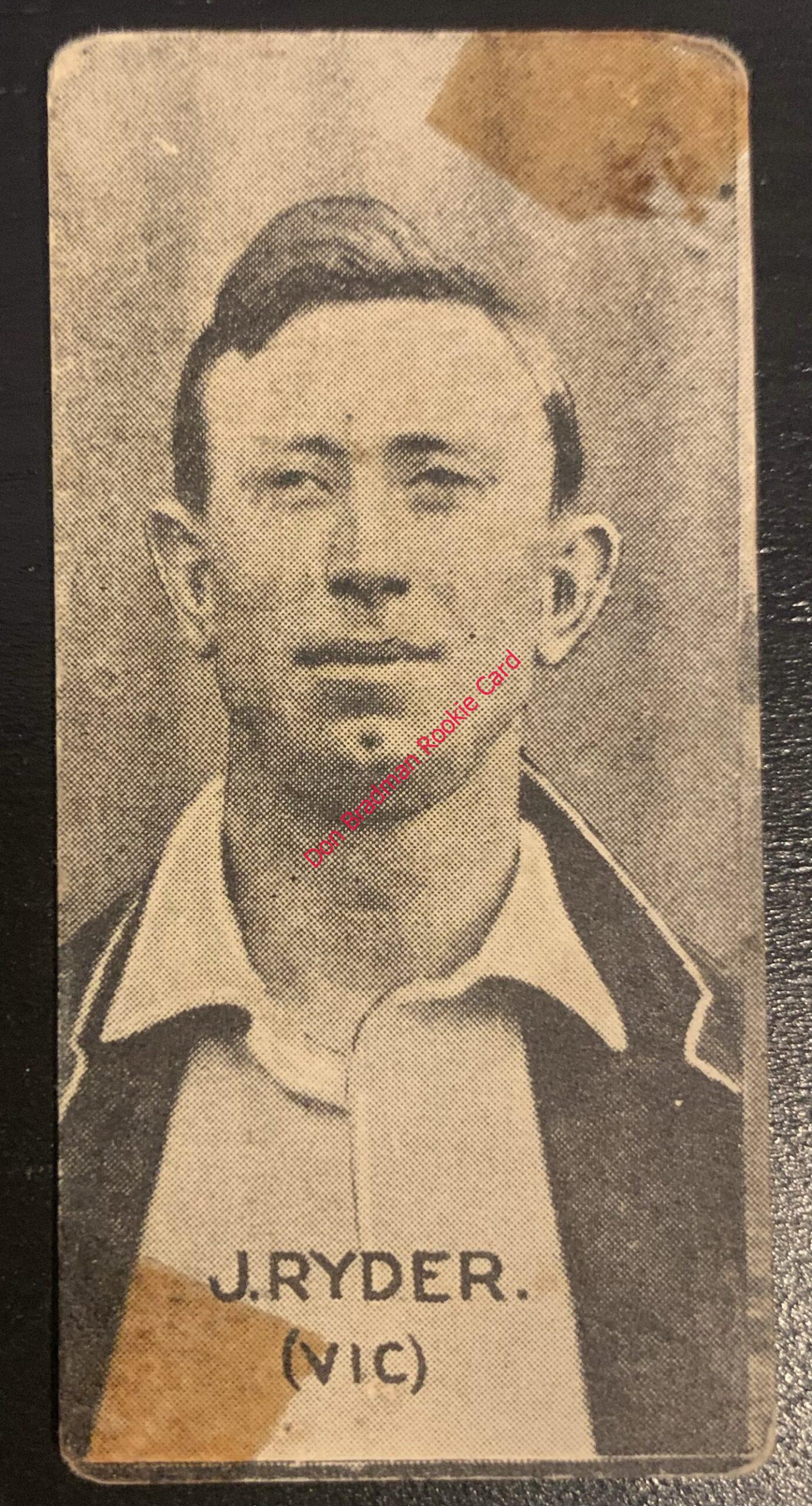
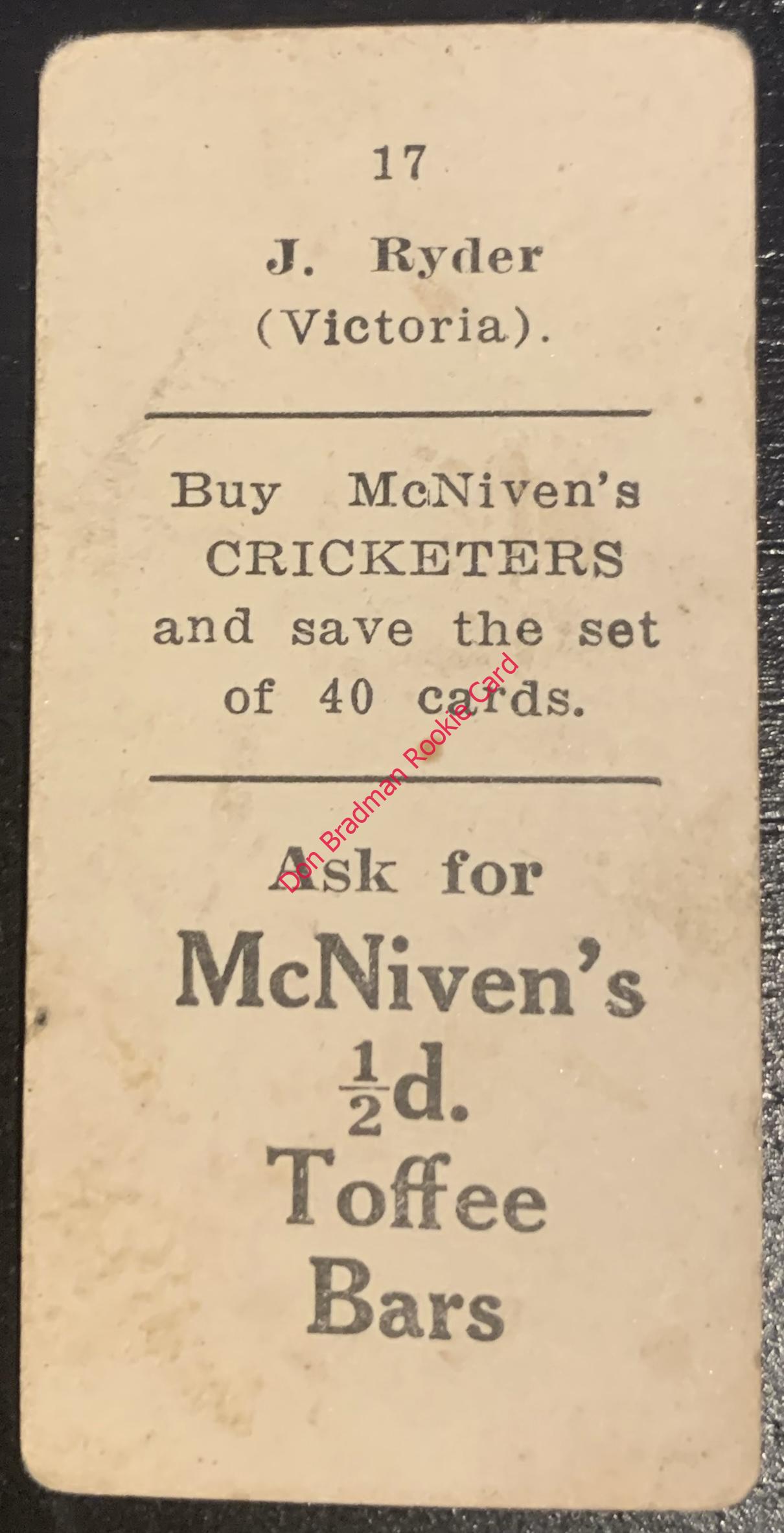
18. Bill Ponsford, Victoria & Australia
Usually playing as an opening batsman, Bill Ponsford formed a successful and long-lived partnership opening the batting for Victoria and Australia with Bill Woodfull, his state and national captain. Ponsford is the only player to twice break the world record for the highest individual score in first class cricket; Ponsford and Brian Lara are the only cricketers to twice score 400 runs in an innings. Ponsford holds the Australian record for a partnership in Test cricket, set in 1934 in combination with Don Bradman of 451 for 2nd wicket, a record for the highest partnership ever for any wicket in Test cricket history when playing on away soil of which Ponsford made his career best Test score of 266. In 29 Tests between December 1924 when he made his debut against England his last Test in The Ashes in August 1934, Ponsford scored 7 Test centuries and averaged a very fine 48.22 in Test cricket.
19. Bill Woodfull, Victoria & Australia
Captain of both Victoria and Australia, Woodfull's famed opening pairing with fellow Victorian Bill Ponsford for both his state and Australia remains one of the most successful in history. Woodfull made his first class debut in 1922 and his Test match debut in England in June 1926. After becoming captain in 1930 he scored his Test best score of 161 against South Africa in 1932. In 1932-33, great controversy erupted during England's tour of Australia, the so-called "Bodyline" series. The visitors used bodyline tactics—persistently aiming at the upper bodies and heads of the Australian batsmen in the hope of stifling the hosts' strong batting line-up. The Australian public and cricket community abhorred the tactic, but Woodfull refused to retaliate or complain publicly. The controversy peaked during the third Test at The Adelaide Oval. Woodfull was felled by a blow to the heart, almost provoking a riot. After Woodfull was dismissed, English manager Plum Warner came to privately express his sympathy, to which Woodfull famously replied "I do not want to see you, Mr Warner. There are two teams out there. One is playing cricket and the other is not." In 35 Tests for Australia Woodfull scored 7 centuries and averaged exactly 46 with the bat.
20. Alan Kippax, New South Wales & Australia
Regarded as one of the great stylists of Australian cricket during the era between the two World Wars, Kippax overcame a late start to Test cricket to become a regular in the Australian team. He made his first class debut in 1918-19 but had to wait until February 1925 to make his Test match debut against England. Kippax was an "impeccably correct and elegant batsman, [with] an upright, easy stance at the wicket; like his schoolboy idol Victor Trumper, he rolled his sleeves between wrist and elbow and excelled with the late cut". Kippax's innings of 83 in the Lord's Test of 1930 induced Neville Cardus to comment that, "he pleased the eye of the connoisseur all the time." In 22 Tests through to August 1934, Kippax scored 2 centuries and averaged 36.12.
22. Vic Richardson South Australia & Australia
An excellent all round sportsman who was also a top Aussie rules footballer (he won the South Australian National Football League's highest individual honour, the Magarey Medal, while captain-coach of Sturt in 1920), Vic Richardson made his Test match debut for Australia against England in December 1924 and played in 19 Tests through to his final Test against South Africa in March 1936, already aged 41. In that time he averaged 23.53 with a highest score of 138 and was Australia's vice captain in the 1932-33 "Bodyline" tour. He subsequently captained Australia on their 1935-36 tour to South Africa.
23. Gordon Harris, South Australia
The first card in the series of a player who never played Test match cricket for Australia, there is no doubt Gordon Harris was under active consideration after scored of 155 and 183 in Sheffield Shield matches in November and December 1928. He played in 37 first class matches for South Australia between 1920 and 1931, scoring 4 centuries with an average of 34.75.
24. Jack Gregory, New South Wales & Australia
Another mainstay of 1920's Australian Test cricket and from a famous Australian cricketing family, left hand batsman and right arm fast bowler Jack Gregory played 24 Tests for Australia between his debut against England in December 1920 and his final Test at Brisbane in December 1928. He twice scored Test match centuries and averaged 36.96 with the bat, taking 85 Test wickets at 31.15 apiece, his best bowling was 7-69 in an innings and 8-101 in a match at the 1920-21 Test against England at Melbourne. At the Johannesburg Test in 1921 he scored a century from 67 balls in 70 minutes, which was at the time the fastest hundred in terms of both balls faced and minutes taken in the history of Test cricket. The record stood until 1985 when Viv Richards managed the feat with 56 balls but it remains the record for the fastest hundred in terms of minutes.
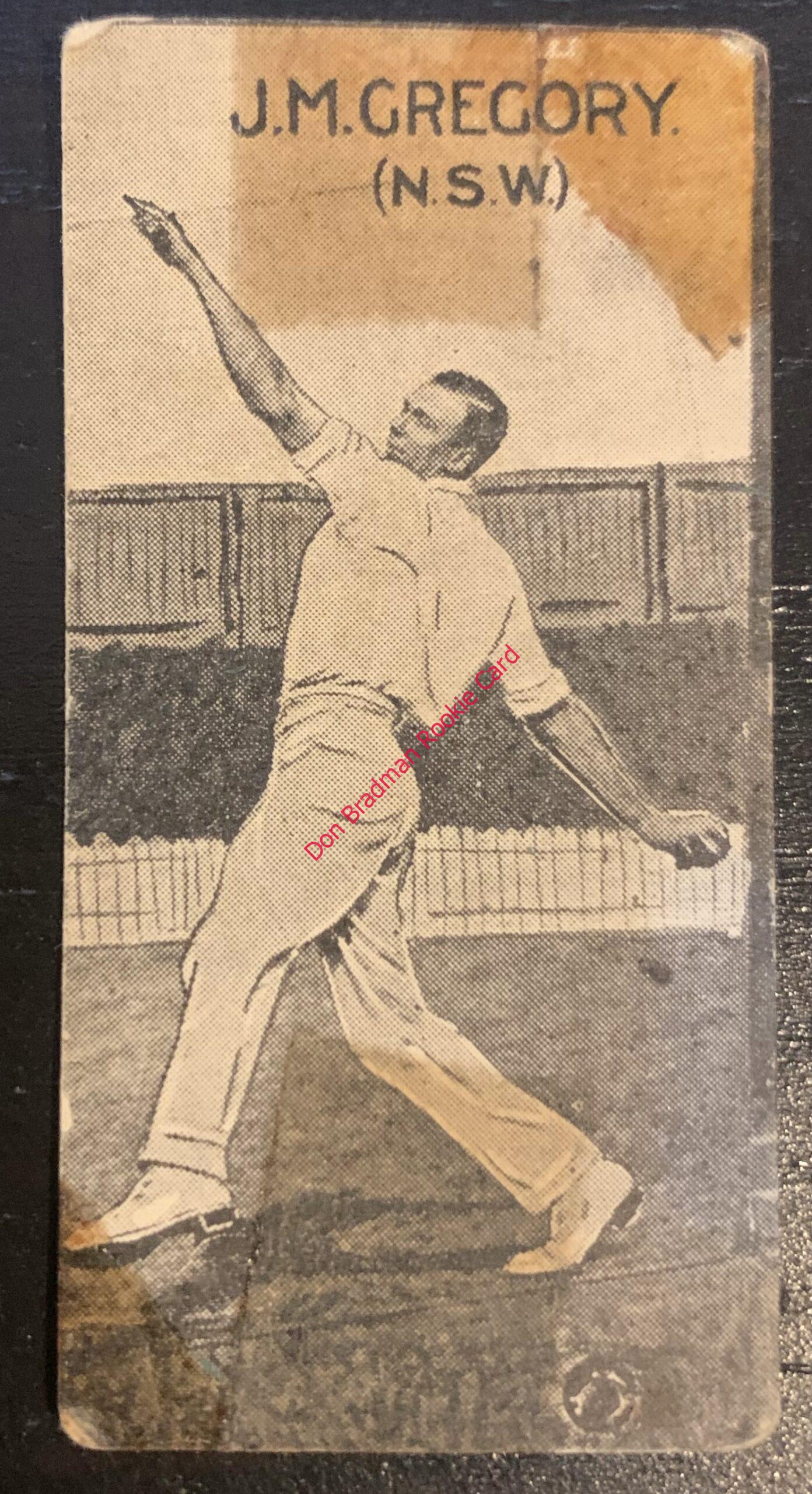
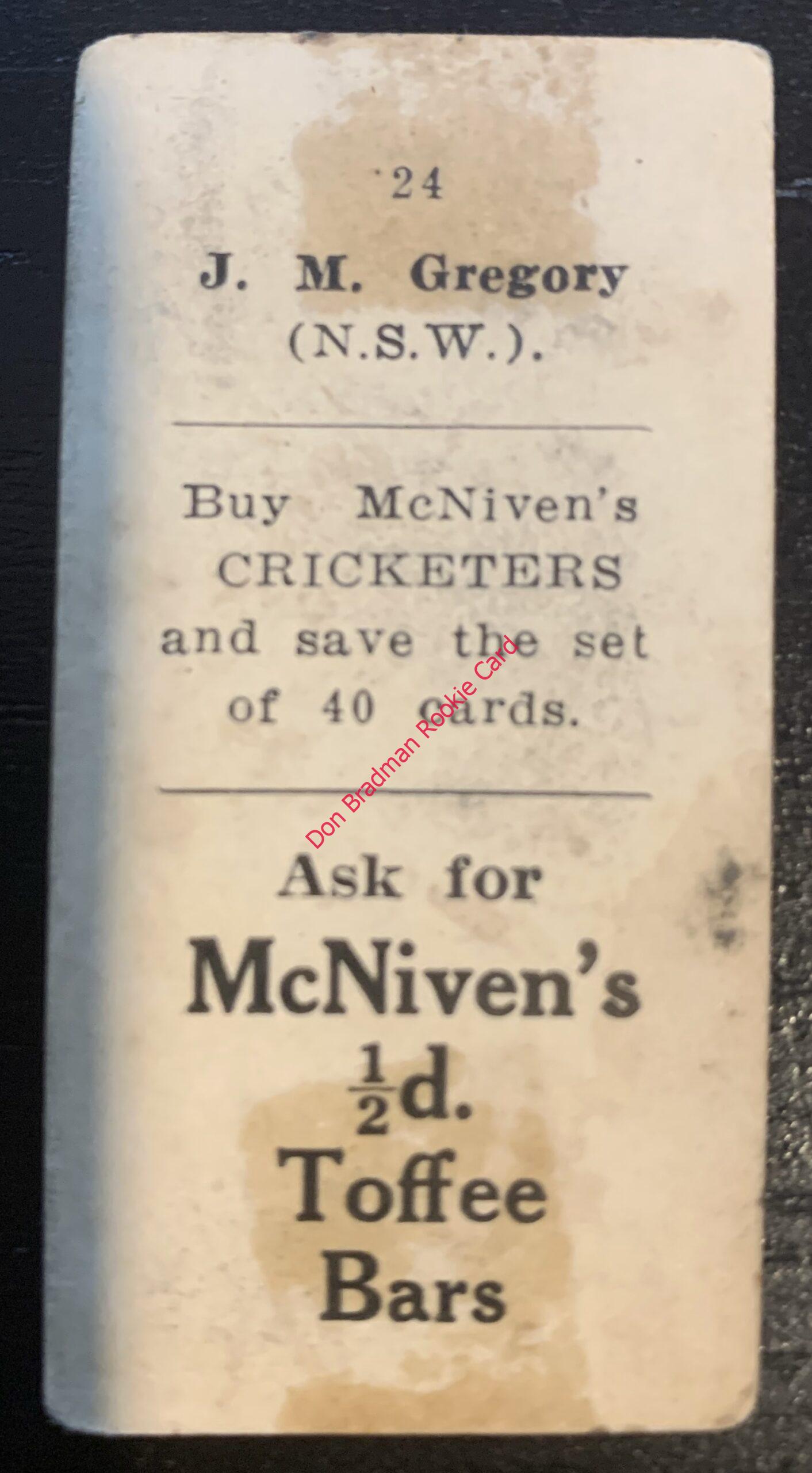
25. Otto Nothling, Queensland & Australia
Nothling was a double cricket and rugby union international who won a total of 19 international rugby caps for Australia, playing against New Zealand, Maoris and South Africa between 1921 and 1924. He retired from rugby when he graduated from university in Sydney. While there he played cricket for New South Wales as a right-arm fast-medium bowler and hard-hitting middle-order batsman. He later played cricket for Queensland between 1927-28 and 1929-30 and on England's 1928-29 Ashes Tour, having taken 5 wickets in Queensland's match with the tourists, Nothling was selected for the Second Test at Sydney. He opened the bowling but took no wickets, and made 44 in the second innings, adding 101 for the fifth wicket with Jack Ryder. It proved his only Test match for Australia.
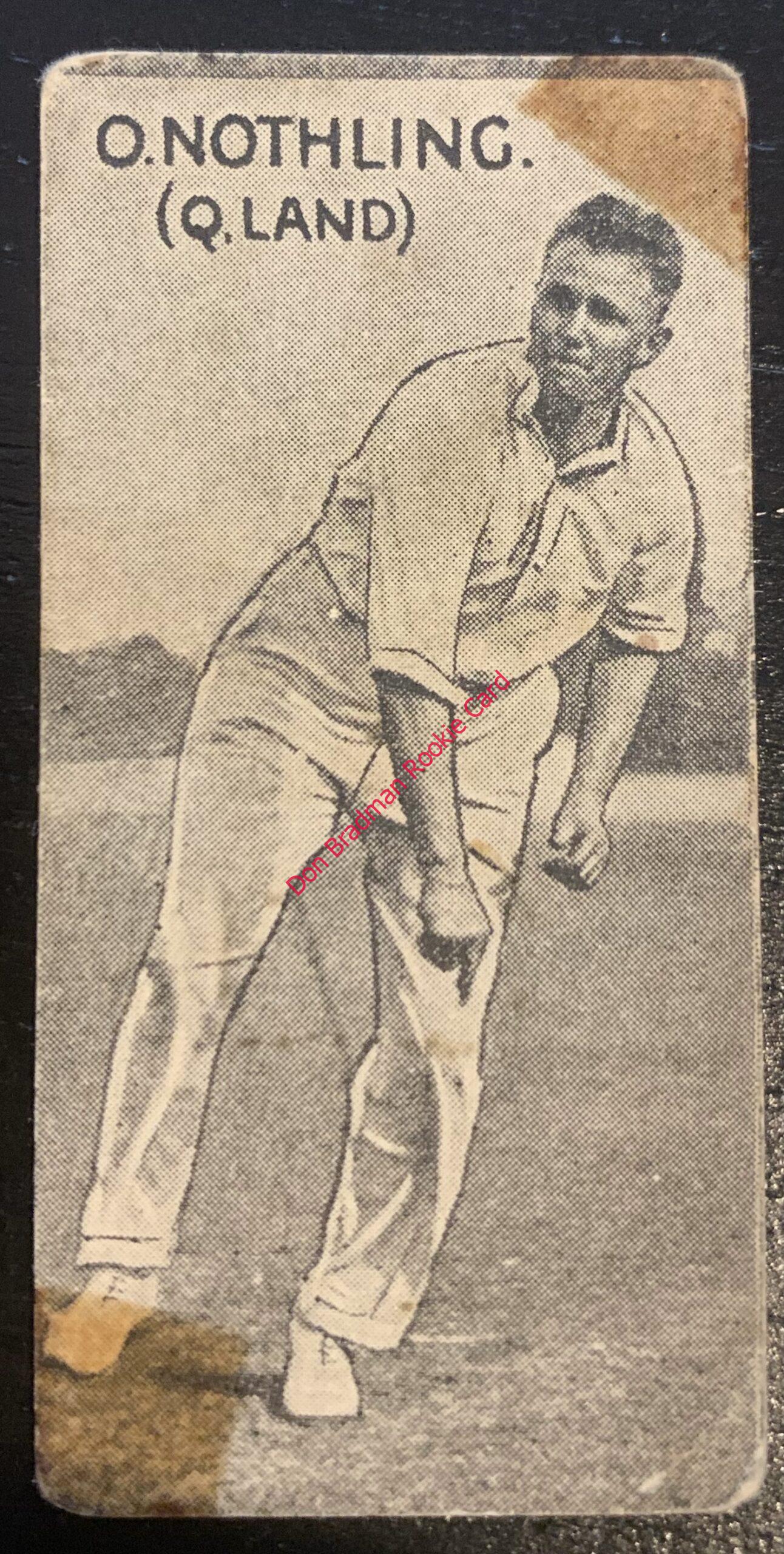
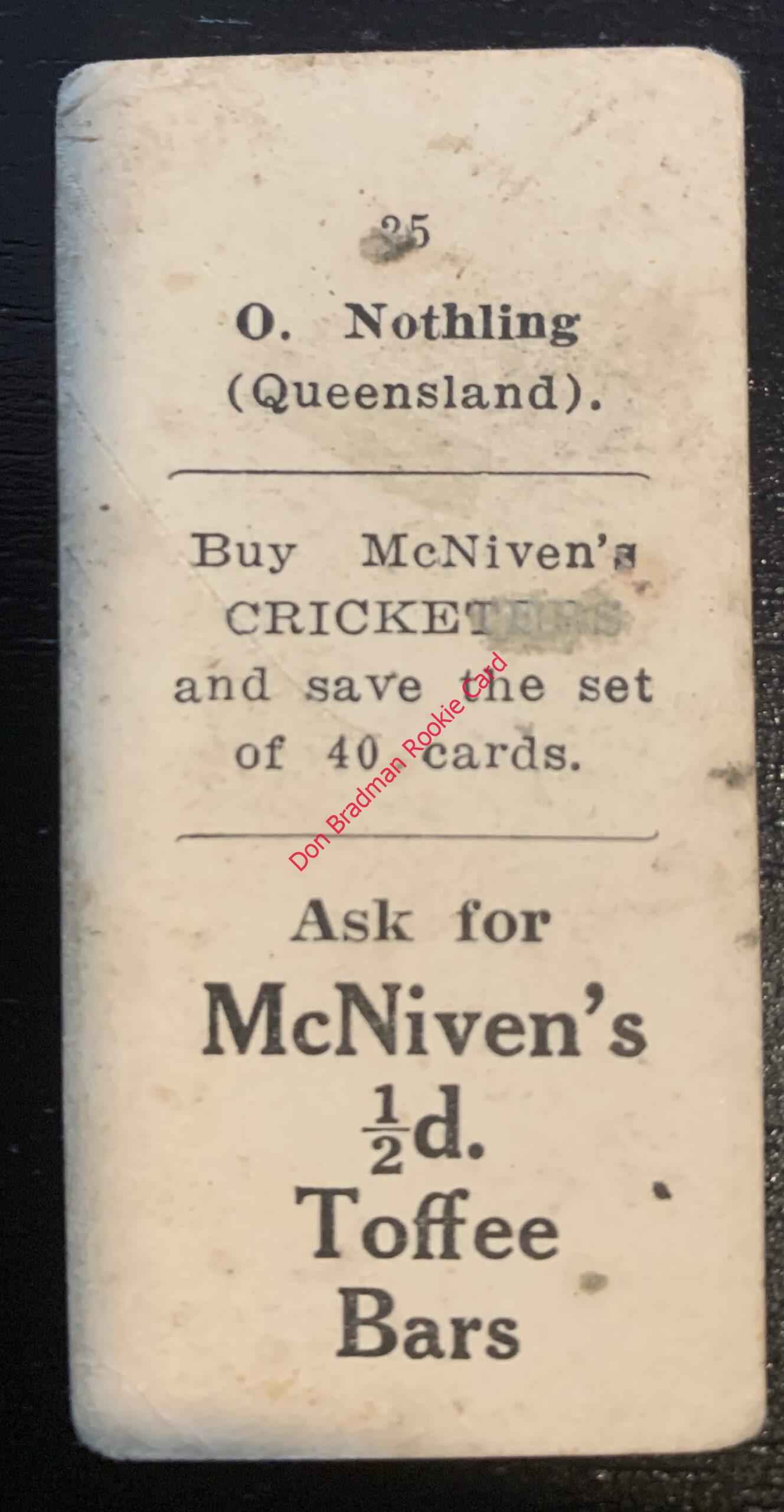
26. Clarrie Grimmett, South Australia & Australia
New Zealand born leg-spinner Clarrie Grimmett made his first-class debut for Wellington at the age of 17. At that time, New Zealand was not a Test cricketing nation, and in 1914 he moved to neighbouring Australia, leading 1930's Australian spin bowler Tiger O'Reilly to later speculate that he "must have been the best Christmas present Australia ever received from that country". Initially playing for Victoria he moved to South Australia in 1923 and made his Australian Test match debut, already aged 33, against England in February 1925, going on to play 37 Test matches through to a match with South Africa in Durban in February 1936, by when he was 44. Grimmett remains the one of the few bowlers with career figures of over 200 wickets in fewer than 40 Tests. He held the record for the fastest bowler to take 200 wickets in Tests, doing so in his 36th match. The record stood for 82 years, until Yasir Shah of Pakistan broke that mark in December 2018. He took a five-wicket haul on 21 occasions, seven times finishing with ten wickets or more in a match. In one performance playing for the touring Australian side against Yorkshire in 1930, he took 10 wickets for 37 runs off 22.3 overs, one of only a very small number of players to have claimed all of the wickets in an innings. Undoubtedly one of the finest early spin bowlers, he is credited as the developer of "the flipper" as a style of delivery.
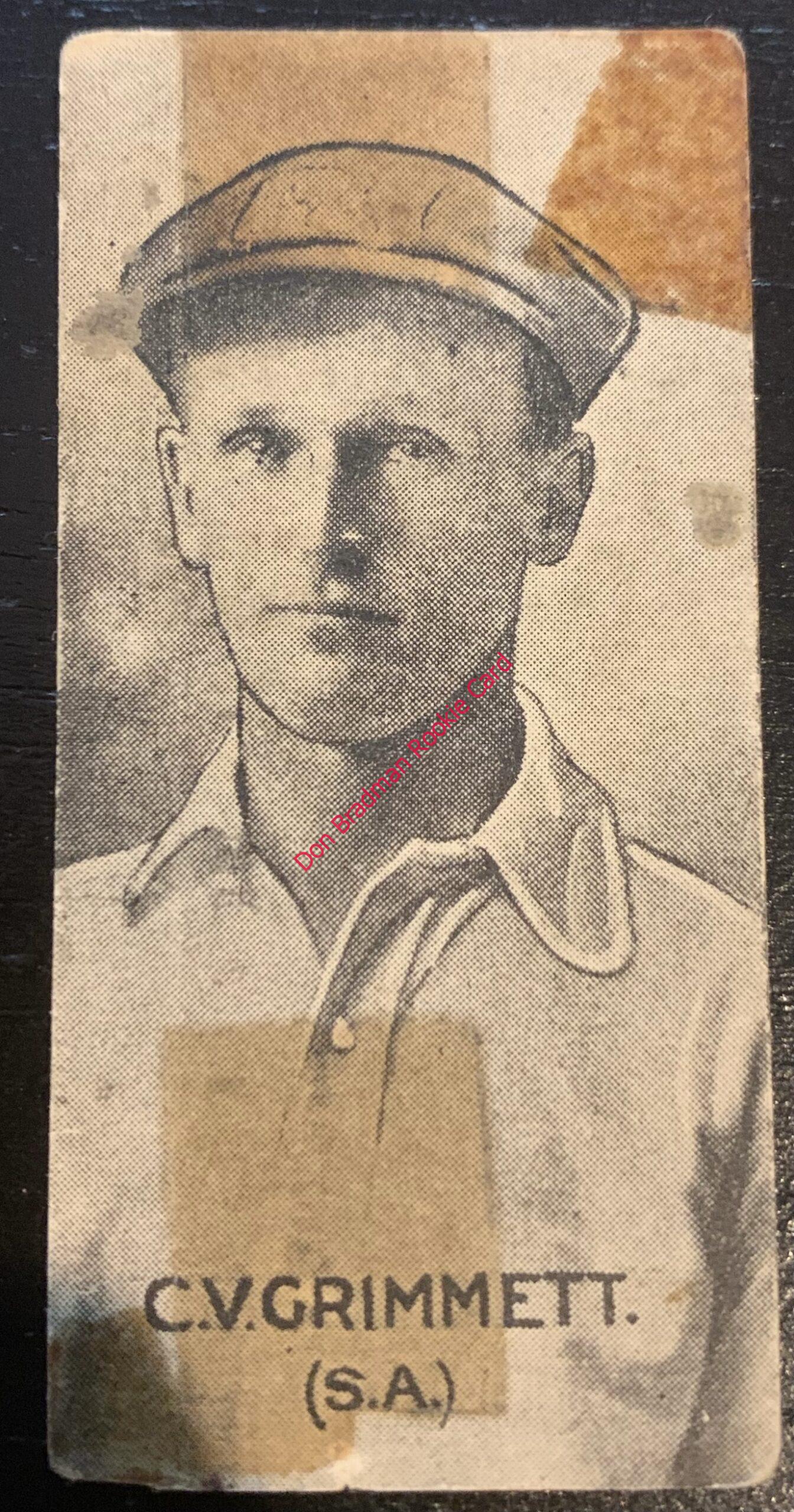
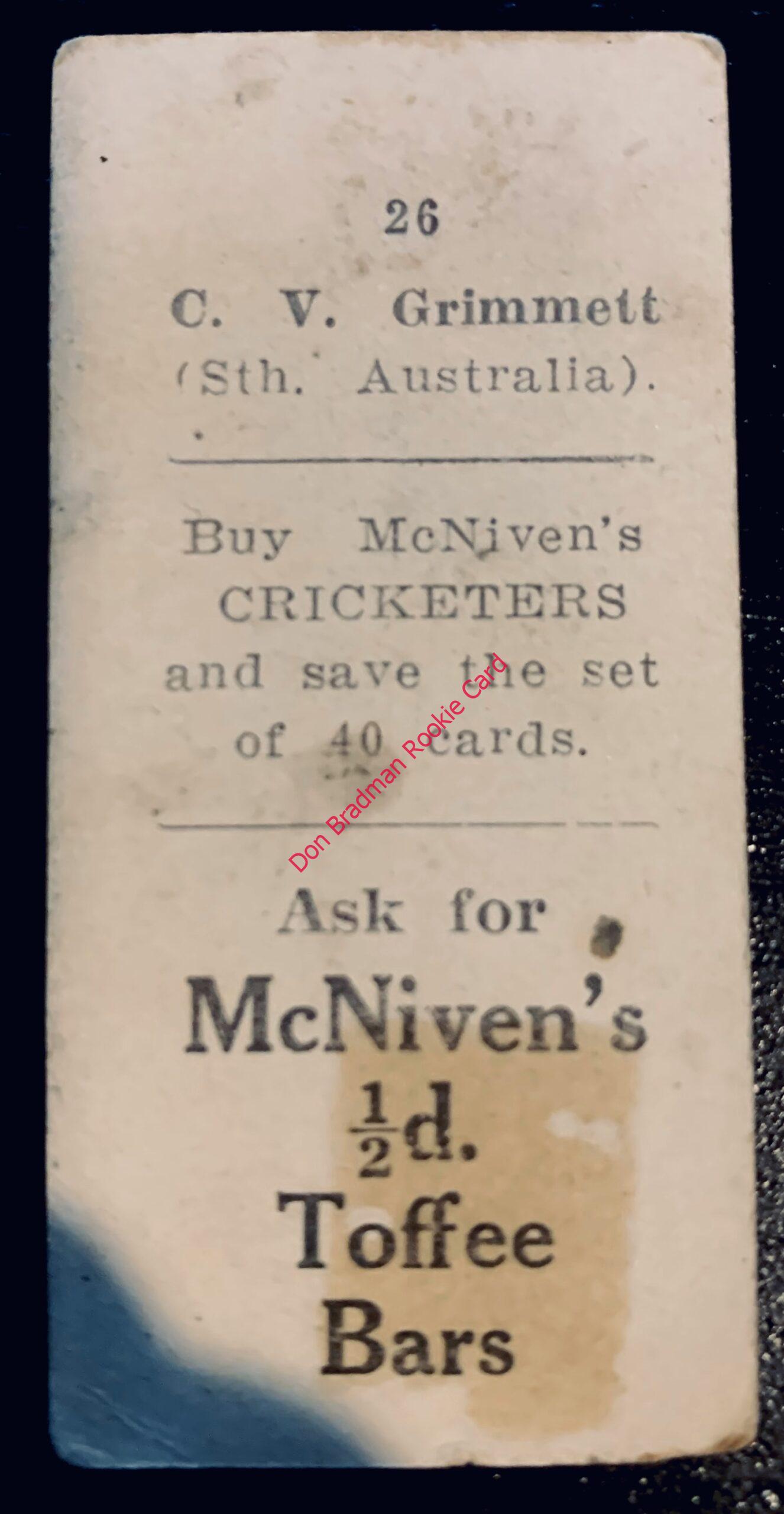
27. Bert Ironmonger, Victoria & Australia
Left arm off-spinner Bert Ironmonger was already 27 when he made his first class debut for Queensland in 1909, subsequently joining Victoria in 1914. Ironmonger's Test debut came against England in November 1928 when he was was already 46. He played Test cricket until the age of 50, his final Test coming against England in February 1933, and continued in first class cricket until the age of 53. He is the fourth-oldest Test debutant and the second-oldest Test player. In 14 Tests for Australia he took 74 wickets at just under 18 a piece.
28. Colin Alexander, South Australia & Australia
A middle-order batsman, Colin Alexander made his first- class debut for South Australia in the 1925-26 season a few weeks after turning 18. In his second match, against the touring New Zealanders, he scored 130 and 34 not out. In his next match, which was his first in the Sheffield Shield, he scored 133 against Victoria. In the 1926-27 season he scored 55 and 104 against New South Wales, and he was selected to play for The Rest against Australia at the end of the season. He scored 328 runs at an average of 32.80 in 1927-28, and was selected in a 13-man squad to tour New Zealand at the end of the season. He played in four of the six first class matches on the tour, including one of the two against New Zealand, but apart from an innings of 95 against Auckland he was unsuccessful. After a few matches in 1928-29 he played no more first class cricket. He was only 21 when he played his last match.
29. Charlie Kelleway, New South Wales & Australia
A right handed batsman and right arm fast-medium bowler, Charlie Kelleway played in 26 Test matches for Australia between his debut against South Africa in December 1910 and his last Test against England in November 1928. He scored 3 Test centuries and averaged 37.42, and took 52 wickets in Test cricket at 32.36 a piece. Playing both sides of the First World War, he travelled to England in 1911-12 to play against the team captained by Plum Warner. In that series, he took a total of only 6 wickets at 41.50. However, on his return in the Triangular tournament of 1912 he was more successful and made 360 runs in six Tests, with 114 at Manchester and 102 at Lord's, both against South Africa. He also had the best bowling of 5-33 in an innings. He served as a Captain in the Australian Army and after the war remained in England and was the first captain of the Australian Imperial Force Touring XI until he was removed following a dispute.
30. Bert Oldfield, New South Wales & Australia
One of Australia's all time greatest wicket keepers, Bert Oldfield played his first Test match against England at Sydney in December 1920. Oldfield played 54 Tests for Australia, scoring 1,427 runs at an average of 22.65, and taking 78 catches and 52 stumpings, which remains a record several decades after his final Test against England in March 1937. In the notorious Third Test at Adelaide, the English "Bodyline" tactic of bowling fast balls directed at the Australian batsmen's bodies reached its most dramatic moment when a ball from fast bowler Harold Larwood hit Oldfield on the head, fracturing his skull (although this was from a top edge off a traditional over the wicket delivery and Oldfield admitted it was his fault). Oldfield was carried from the ground unconscious. He recovered in time for the fifth Test of the series, one of only two Tests he missed during his Test career.
31. Tommy Andrews, New South Wales & Australia
Right handed batsman Tommy Andrews could also bowl leg breaks and keep wicket when required, and played in 16 Test matches for Australia from his debut against England in May 1921 until his final match against England in August 1926. In that time he averaged 26.90 with the bat and played for New South Wales until 1929.
32. Don Blackie, Victoria & Australia
On this card Don Blackie's initials are completely incorrect. Blackie played most of his cricket in minor cricket and only made his first class debut in 1924-25 aged 42. He played three Tests as an off-spinner against England in the summer of 1928-29. At 46 years, 253 days of age at the time of his Test debut in the Second Test of the series, Blackie remains the oldest debutant in Australian Test cricket. In the Third Test he took 6 for 94 and in total took 14 wickets at 31.71 a piece.
33. Leo O'Connor, Queensland
Another poorly cut card that appears to have part of Alan Kippax's card on the right edge. Another card of a player who never made the Australian Test team, Leo O'Connor captained and kept wicket for Queensland in the Sheffield Shield. He made his first appearance for Queensland in 1913 and was a regular for the state whenever they played a first class match over the following decade and a half. When Queensland made their Sheffield Shield debut in 1926-27, O'Connor was named as their inaugural captain. In 46 fist class matches he averaged 39.89 with the bat, with a highest score of 196 against New South Wales at Brisbane in their debut match.
34. Archie Jackson, New South Wales & Australia
Right handed batsman Archie Jackson made his first class debut aged 17 and played eight Test matches for Australia between his debut against England in February 1929, aged 19, and his final Test against West Indies in February 1931. Jackson made a highest Test score of 164 on his debut in the Fourth Test at Adelaide. He ended with a Test match average of 47.40 but had suffered from persistent ill health and died of tuberculosis in February 1933 aged just 23.
35. John Scaife, Victoria
With incorrect initials to the card's reverse, John Scaife played 46 first class matches as a right handed batsman, making his debut for Victoria against Tasmania in 1925-26. One of the smallest first-class players in Australia at the time, Scaifeplayed in a trial match for an Australian XI against The Rest at the start of the 1928-29 season but was not successful. He continued to play for Victoria with mixed success. He did not score his first century until 1933-34, when he made 120 and 80 to help Victoria draw the match after New South Wales had declared at 672 for 8 in their first innings. His best season was 1935-36, when he made 573 runs at 52.09, averaging 33.93 across his career with a top score of 120.
36. Ron Oxenham, Queensland & Australia
The card is poorly cut and Maurice Leyland's heel appears bottom right. Right arm medium pace bowler and lower order batsman Ron Oxenham played State cricket from 1911-12 to 1936-27, and played 7 Test matches for Australia between his Test match debut against England in December 1928 and his final Test against South Africa in November 1931. With a top score of 48 he averaged 15.10 in Tests and took 14 wickets at 37.28 a piece. His brother Lionel also played with him for Queensland.
37. Gordon Morgan, New South Wales
On this badly cut card part of George Duckworth's card is clearly visible. Gordon Morgan played first-class cricket for New South Wales across the 1920's, making his first class debut in 1921-22 and playing for the final time in 1928-29. During that time he scored 3 centuries in 27 matches, averaging 31.83 with a top score of 121.
38. Hal Hooker, New South Wales
A tall fast-medium bowler, Hal Hooker became the first player to take four wickets in successive balls in a Sheffield Shield match in 1928-29. He is the holder of the world record 10th wicket stand in first class cricket, making 307 with Alan Kippax. Coming in at number 11, Hooker batted for almost five hours and made 62, one of 3 first class fifties and averaging 20.04 in first class matches. With the ball he took 87 wickets at 28.50 a piece and played from 1924-25 to 1931-32.
39 Hunter Hendry, Victoria, New South Wales & Australia
Nicknamed "Stork" on account of his height, Hunter Hendry was a formidable batsman to whom bowlers found difficulty, who played in 11 Tests and 140 first class matches between 1918-19 and 1935-36. He joined Victoria from New South Wales in 1924. In 11 Test matches for Australia, making his Test debut against England in May 1921 until his final match in February 1929, he scored a single century, making 112 at Sydney in the Second Test of the 1928-29 series against England, and he averaged 20.93 in Tests. At the time of his death in 1988, aged 93, he was the oldest surviving Test and Sheffield Shield cricketer.
40. Cecil Thompson, Queensland
A right handed batsman,
Cecil Thompson made his first class debut against New South Wales in 1912-13. He was one of the leading Queensland batsmen in the 1920's, along with Leo O'Connor. He played for University in district cricket until moving to South Brisbane in 1925. In the 1925-26 season, in matches for Queensland and his South Brisbane club, he scored 1,525 runs at an average of 152.50. In 1926-27, in Queensland’s first Sheffield Shield match, he scored their first century in the first innings (O'Connor scored a century in the second innings). In the 1928-29 Sheffield Shield he scored 743 runs at an average of 74.30; in the whole competition only Don Bradman scored more. A careful player, judiciously selecting which ball to hit, Thompson had great powers of concentration, scoring 275 not out in 628 minutes against New South Wales in 1930-31, the highest individual score at the Brisbane Exhibition Ground. In 58 first class matches through to 1933-34 he averaged 42.16 with 11 first class centuries.
.

Please contact us for information

